Beyond Wild Places
Your guide to the wilder side of life

Ultimate Guide to Sigiriya: Sri Lanka’s Cultural Triangle
Scattered across the central plains of Sri Lanka are the country’s most important historical and archaeological sites. Sigiriya is easily the most recognisable, identified by its towering rock formation with an ancient fortress perched atop its flat mount.
However, Sigiriya is also close to two other impressive UNESCO World Heritage Sites forming a triangle: the Ancient City of Polonnaruwa and the Dambulla Cave Temple. Together, these make up Sri Lanka’s cultural and religious heartland. If you’re interested in exploring more of the fascinating history and surprising geology of the teardrop shaped island, then spending a few days in and around Sigiriya should be a priority for your Sri Lanka itinerary.
This post is going to look at how to explore Sigiriya and the surrounding area. I spent five days based in Sigiriya, with day trips to Polonnaruwa, Dambulla and Ritigala. I’m going to detail everything you need to know about visiting the cultural triangle of Sri Lanka.
Disclaimer: This post contains affiliate links which means I get a commission if you buy a product through my link at no extra cost to you. By doing so, I can keep this blog going and continue to create helpful guides for you. Read more: Privacy Policy
Why I Based Myself in Sigiriya
Sigiriya is perfectly located in the middle of the cultural triangle and offers the perfect base for exploring the area. The village has plenty of high quality accommodation for reasonable prices and lots of good restaurants too. It’s also a lot quieter than bigger towns like Dambulla and Habarana, and I liked the “local feel” that staying in a home stay and eating at local restaurants had in Sigiriya. I found the locals extremely friendly and it really made my time in Sigiriya extra special.
It’s also ideal to be close to Pidurangala Rock and Sigiriya Rock for sunset or sunrise hikes. Plus, it’s easy enough to do day trips from Sigiriya to Polonnaruwa and Dambulla either by public transport or tuk tuk. While some people tend to stay a night in Dambulla, a night in Sigiriya and then a night in Polonnaruwa, I found it was easier just to base myself in one place and organise everything from there.

How to Get to Sigiriya
Sigiriya is off the main A6 highway, so you’ll likely have to transfer buses at least once to reach it. There’s no train service to Sigiriya. However, being in the middle of the country, it’s quite easy to reach from various places.
Dambulla is the main transport hub for Sigiriya. It has buses running every hour to Sigiriya from the Dambulla Bus Stand for 100 LKR or you can take a tuk tuk for around 2000 LKR (US$7). The final bus stop in Sigiriya is just a 10 minute walk from the entrance of the Sigiriya Rock Fortress, but you can also hop down closer to your accommodation, just let the driver know.
From Kandy to Sigiriya
From Kandy, take a bus heading to Dambulla. There are both normal buses and AC buses. The AC bus costs 500 LKR (US$2) while the local bus will cost a little less. The journey time should take 2-3 hours.
Once you arrive at Dambulla Bus Station, you’ll find local buses heading to Sigiriya every hour for 100 LKR (US$0.50). This journey travels via Inamaluwa Junction and takes around 30 minutes.
Read more: 10 Best Things to Do in Kandy, Sri Lanka
Short on Time? Try These Day Tours from Kandy
From colombo to sigiriya.
Ask around the Colombo bus stand for buses heading to Dambulla (it may be #49 Trincomalee bus, #15 bus to Anuradhapura, or #48 bus to Kaduruwela). A local bus might take around 5 hours for the journey, but you can also find AC buses which will shorten the journey to about 3.5-4 hours via toll roads.
From Dambulla, take a bus or tuk tuk to Sigiriya as above.
Read more: How to Spend 24 Hours in Colombo

From Trincomalee to Sigiriya
From Trincomalee, you can take any bus heading towards Colombo. Ask if they’re passing through Dambulla (bus #49 is ideal as this definitely does). Either get off in Dambulla itself or get off a bit earlier at Inamaluwa Junction (the turnoff for the Sigiriya Road). The journey should take about 3 hours and cost 500 LKR (US$2).
In Dambulla, jump on a bus heading to Sigiriya or flag the bus down at the Inamaluwa Junction (make sure you’re standing on the left side of the road for the bus to pullover on its way to Sigiriya). From the junction, the bus costs 80 LKR to Sigiriya and you may have to wait up to 30 minutes for it.
Read more: Guide to Trincomalee: Sri Lanka’s Underrated Beach Destination
From Anuradhapura to Sigiriya
From Anuradhapura, there are regular buses heading to Dambulla and the journey should take about 2 hours and cost 300 LKR (it’s usually #15 bus heading to Colombo). From Dambulla, hop on a bus to Sigiriya as described above.

Where to Stay in Sigiriya
Sigiriya village has exploded in recent years with plenty of accommodation. While you might not notice from the main road, there’s hundreds of home stays, guesthouses and resorts tucked away in the forest down skinny back roads all over the area.
There’s something for every budget, with reasonable prices because of the high competition. Here’s my recommendations in order of price (budget to high-end):
Freedom Home Stay | This is where I stayed for five days and, for the price, it’s incredible value. They offer two large en-suite rooms with a patio near the family home. The family are beautiful and serve a delicious breakfast every morning. The husband is also a tuk tuk driver and he took me on all the day trips I outline below for a good price. Check prices here .
Sigiri Rock Side Home Stay | Just a 5-minute walk from Sigiriya Rock Fortress entrance, this home stay offers a handful of double and single rooms amongst a pretty garden. With a shared patio area, friendly hosts, and a delicious breakfast served every morning. Check prices here .
La Dolce Vita | A rustic, homely property with modern comforts, this boutique hotel has an outdoor pool, private patios for the rooms, and a restaurant serving daily breakfast. It’s located 2km from Sigiriya Rock. Check prices here .
Atha Resort | An exceptionally rated resort just 3km from Sigiriya Rock, this place features an outdoor pool and onsite restaurant. The beautiful rooms overlook the garden, some with private balconies. Check prices here .

When to Visit Sigiriya
Sigiriya is best visited during the dry season , from December until April , especially in terms of visibility and weather conditions. However, it will be extremely hot during these months, so you’ll likely want to be exploring early in the morning and late in the afternoon with a midday siesta.
Keep in mind that this is also peak tourist season, so you should expect large crowds at most sites and long wait times for climbing Sigiriya Rock.
The wet season runs from May until November, but you might still be lucky with sporadic dry patches. It’s also incredibly humid during these months and afternoon storms are common. I was there in late August and had relatively good weather during the day, and just some stormy afternoons. It’s difficult to predict the ever-changing weather in Sri Lanka!

Where to Eat in Sigiriya
Kenoli Restaurant | One of the most delicious rice and curry joints I visited in Sri Lanka, the couple running this small restaurant are super friendly and excellent cooks. Well-known as one of the best places to enjoy local food, it’s home cooked Sri Lankan cuisine at its best.
Liya Restaurant | Right next door to Kenoli, this place might not have the same reputation but I ate here plenty of times and it was always good. The family running this place are super friendly and always up for a chat. The serving portions are huge and good value for money.
The Lion’s Choice | Located on the main road in Sigiriya, I happened upon this place on my first day in town. The rice and curry was delicious and featured some very obscure local delicacies to try. They’re also happy to change the menu to suit vegans.

Best Things to Do in Sigiriya and Around the Cultural Triangle
While the main attraction of Sigiriya is the famous Lion Rock Fortress, there’s plenty of incredible historical sites to explore in and around town. Both Sigiriya Rock and Pidurangala Rock can be done within a day in Sigiriya, while the other major attractions will require a day trip.
Here’s the best things to do in Sigiriya, with everything you need to know to visit each of the attractions.

Sigiriya Rock Fortress (Lion Fortress)
Brief History: Lion Rock Fortress is the fortified palace built by King Kashyapa in the 5th century, perched on the imposing Sigiriya Rock seen from miles around. The King moved the capital to the more strategic location of Sigiriya, from the plains of Anuradhapura. The Palace in the Clouds only lasted 18 years though, before it was forgotten, until British colonialists rediscovered it with the help of locals.
How to get there: Sigiriya Main Entrance is on the west side of the complex and within walking distance from Sigiriya town (about 1.5km depending on where you’re staying)
Ticket price: US$36 for adults (including the Sigiriya Museum)
Opening hours: 5am to 5pm every day (you can stay inside the park after 5pm, but tickets must be purchased before 5pm)
Sunrise or sunset? Sunset is ideal if the clouds are clear as you’ll avoid the searing sun and some of the day trip crowds, but sunrise is equally nice if you don’t mind an early morning
How long is the hike: Those with a reasonable level of fitness who are also stopping to look at things along the way should be able to complete the hike to the top of Sigiriya Rock in an hour. You should also factor in about 30-45 minutes at the top, and half an hour for the descent.
Is it worth it? The price is enough to make many backpackers think twice about visiting Sigiriya Rock. And while I agree the ticket price is steep, I’d have to say it’s still worthwhile. For Sri Lanka, Sigiriya is on par with what Machu Picchu is for Peru, as it’s main archaeological attraction. I just hope (as do others) that the money is going back into research and conservation efforts. If the price is really out of your budget, just stick to visiting Pidurangala which is far cheaper and offers just as beautiful views, but lacks the historical significance.

Things to See at Sigiriya Rock
The Sigiriya Museum is included in the price and located close to the entrance. Very few people actually bother with it, but it does offer a nice overview of the history, geology, and architecture of the ancient city. Then, you’ll pass many of the landscaped royal gardens as you walk towards the giant rock, which consist of terraced pools.
The first set of steps through the rocks will take you up to the famous lion paw staircase , which is how the Lion Rock Fortress got its name. From there, you’ll be looking up at the narrow metal staircase that seems to be precariously nailed into the side of the rock. You need to ascend these stairs to finally reach the flat plateau of Sigiriya Rock .

The ruins of King Kasyapa’s fortified palace have been reduced over time to mere foundations. While it can be difficult to imagine what it would have looked like at its peak, the terraces are still worth exploring for different vantage points.
The highlight of the climb up to the top of Sigiriya Rock is for the panoramic views . You’ll be able to see across to Pidurangala Rock and the forested plains home to elephants and other wildlife.
You have to descend the same way to exit. However, if you’re visiting for sunset, the main entrance will be closed after 5pm, and you’ll have to follow the signs indicating the exit for after hours.

Good to Know
There are many steps (over 1000) to reach the top, including some steel ladders with steep drops, so those with a fear of heights or physical difficulties may not make it to the top.
Unlike other attractions, Sigiriya doesn’t have a strict dress code because it’s not a temple or place of worship, but ensure you wear comfortable clothing and footwear for walking.
There are toilets and an ATM at the main entrance.

Pidurangala Rock
Brief History: When King Kashyapa discovered Sigiriya in 5th century, he wanted to move the monks to Pidurangala so he could build his palace on top of Lion Rock. The monks obliged and the monastery was built into caves around Pidurangala Rock.
How to get there: The car park and entrance is about 4.5km from Sigiriya town on the west side of the rock. A tuk tuk will cost about 1500 LKR (US$5) for the return trip from your accommodation, including wait time for the climb up and back.
Ticket price: 1000 LKR per adult
Opening hours: 5am to 6pm every day (you can stay at the top after 6pm, but tickets must be purchased before 6pm)
Sunrise or sunset? Many people recommend sunrise for Pidurangala, as you’ll likely get to enjoy the view with only a few others. In the wet season, you’ll also likely avoid the stormy afternoons. However, I went for sunset and equally enjoyed it.
How long is the hike: The hike up to Pidurangala is steep and covers some rough terrain. Most people will be able to make it to the top in about 45 minutes, although fit people could do it in 20-30 minutes or less with no breaks. It only takes about 15 minutes going down.
Is it worth it? For the much cheaper ticket price than Sigiriya Lion Rock, Pidurangala is definitely worth it. The view of Sigiriya Rock is unbeatable and if you’re visiting at sunset or sunrise, it’ll likely be one of the most memorable things you do in Sri Lanka.

Things to See at Pidurangala Rock
The hike starts at Pidurangala Sigiri Rajamaha Viharaya , a white temple at the base of the rock. This is where the ticket office is and the endless stairs begin up to the top. You’ll also need to cover up just to walk through this area, so bring a shawl or borrow one from the monastery.
From there, you’ll ascend some steep stairs and then follow a rough jungle path over rocks and tree roots, and through caves. On the way, you’ll pass Pidurangala Temple, of which the most impressive sight is a 12m reclining Buddha lying under a rock face.

From there, the hike gets even more adventurous. The last 10 minutes requires some basic bouldering and climbing over large rocks. The final push requires a bit of a scramble up to the top, and then a short walk through the last bushes to the open views awaiting above.
The panoramic views are arguably more impressive than those from Sigiriya Rock, as you’ll have an incredible view of the Sigiriya Lion Rock , which glows with the rising or setting sun. You can also gaze out over the forested plains of Minneraya and Kaudulla National Parks.
Most people take a seat on the rock face to watch the sun rise or set. You need to return the same way. Expect some queues at the rock scrambling section, if there’s lots of people about.

You’ll need good walking shoes to attempt this hike, especially ones with decent grip. Sandals won’t really cut it on this trail.
If you’re heading up for sunrise, it’s best to explore the temples on the way back down when you have some sunlight. It’s also a good idea to carry a headtorch , if you’re visiting at sunrise or sunset as the path isn’t overly well lit.

Polonnaruwa
Brief History: Polonnaruwa was the second capital of Sri Lanka after the destruction of Anuradhapura in 993. It was home to the Sinhalese kingdom that expanded across Sri Lanka from 1070 until 1232, with the city of Polonnaruwa being the cultural and commercial centre of the empire.
How to get there: A return trip in a tuk tuk from Sigiriya, including driving around the Ancient City of Polonnaruwa site costs about 10,000 LKR (US$34). Alternatively, you can jump onto the #48 bus to Kaduruwela that passes through Dambulla from Colombo. Then, you’ll have to arrange a tuk tuk or rent a bicycle to get you around Polonnaruwa.
Ticket price: US$30 per adult
Opening hours: 7am to 5pm every day
How long do you need: You’ll probably need 3 hours to really explore the complex properly, which means if you’re visiting from Sigiriya on a day trip it will be a decent 6 hour day all up. It may take longer than 3 hours, if you’re exploring on a bicycle or on foot.
Is it worth it? Yes, the vast ruins of temples, palaces, and religious buildings in Polonnaruwa was one of the most impressive things I saw in Sri Lanka. Often compared to the more famous Angkor Wat in Cambodia, this UNESCO World Heritage Site is undoubtedly Sri Lanka’s best preserved and incredible archaeological site. It’s a steep entry ticket, but I’d pay it again!

Things to See at Polonnaruwa
The ancient city of Polonnaruwa is not small. There are different buildings, temples, and statues scattered around the huge area, some preserved better than others. Next to the ticket office is the Archaeological Museum, which provides a nice overview of the area. This is worthwhile if you’re not going to have a guide with you.
Some of the must-see attractions within the complex include the Royal Palace and surrounding temples, King’s swimming pool , Sacred Quadrangle Temple , and the huge stupa of Rankot Vihara .
However, my two favourite spots were the nearly 17m high buddha statue of Lankatilaka Temple and the carved buddha figures of Gal Vihara .

The complex is huge. You can either get a tuk tuk to drive you around, explore on foot or rent a bike to get around. In the searing heat of Sri Lanka though, I opted for the tuk tuk and my driver included a tour of the complex in the price from Sigiriya.
It’s very hot in the middle of the day with minimal shade, so ensure you have a hat, sunscreen, and sunglasses. You also need to take your shoes off many times throughout the complex and the stone and sand can be hot. It’s a good idea to pack some socks to slip on to protect your feet!

Dambulla Cave Temple
Brief History: Dambulla is the largest and best preserved cave temple complex in Sri Lanka. It has been a sacred pilgrimage site for 22 centuries, with Buddhist monks inhabiting the area since the 3rd century. Many of the buddha statues were built in the 12th century and the impressive wall paintings were completed over the 18th century.
How to get there: You can take a bus from Sigiriya to Dambulla which should take about 30-45 minutes. From Dambulla Bus Stand, you can either walk or take a tuk tuk for the 3.5km to the ticket office for the cave temple.
Ticket price: 3000 LKR per adult
Opening hours: 7am to 6pm every day
How long do you need: You only need around 1-2 hours to explore the caves, depending on how long you take to climb the stairs from the ticket entrance. The actual Dambulla Cave Temples are located up on top of a large rock and it can take 10-20 minutes to walk up.
Is it worth it? Yes, the Dambulla Cave Temple is an incredibly unique place to visit. I had no expectations before visiting and was blown away by the beauty and craftsmanship of the temples, being carved out of the rock with many buddha statues and detailed paintings. As it’s an easy half day trip from Sigiriya, I highly recommend a visit.

Things to See at Dambulla
There are several separate caves with over 150 Buddhist statues and paintings, some dating back over 2,000 years. Murals cover over 2,000 square metres of cave walls, depicting Buddha’s life, while the views overlooking the surrounding valley all the way to Sigiriya are also really beautiful.
It’s a rather small attraction that doesn’t require as much walking as the other places on this list. However, I suggest taking your time to wander through each of the cave temples admiring every corner.
There’s also a Golden Temple , a huge golden buddha statue perched on top of a temple on the other side of the Dambulla Cave Temples.

The dress code to enter the temples is very strict. Make sure you remove your shoes at the entrance where you’ll find a small shoe rack that requires a small donation of 20 LKR. You must also have your knees and shoulders covered.
If you want to explore the Golden Temple as well, it’s down the other side of the hill. You can take the stairs down the opposite side of the hill and exit via the Golden Temple (don’t enter through the Golden Temple as there’s no ticket office for the Cave Temples this way and security will make you walk around to the ticket office!). Although, I wouldn’t say it’s a must see.

Ritigala Archaeological Site
Brief History: Ritigala is a mountain in central Sri Lanka which is home to an ancient Buddhist monastery that dates back to the 1st century. It’s believed to have been an important centre of Buddhism during the Anuradhapura Kingdom until the 12th century when it was abandoned. The legends surrounding the mountain relate to its unique and unusual flora and fauna and it’s thought that many of its plants have medicinal properties.
How to get there: A return trip in a tuk tuk should cost around 5500 LKR (US$20) from Sigiriya, with the journey being just over an hour one way. There’s no public transport that will get you to Ritigala.
Ticket price: US$5 per adult
How long do you need: You can walk up and down the ruins of Ritigala mountain within an hour, but allow 2 hours if you really want to take your time and stop at each site. From Sigiriya, you should allow about 5 hours all up for a visit.
Is it worth it? While it’s not as impressive as Sigiriya or Polonnaruwa, I still really enjoyed my day trip to Ritigala. It’s quite an offbeat location to visit, so you’ll get to explore some back roads in Sri Lanka and have the archaeological ruins almost all to yourself. If you have the time and budget, I recommend a visit.

Things to See at Ritigala
From the ticket office, there’s a singular path that winds its way up Ritigala Mountain to the last ruins on the slope. While things are not well signposted at all, it’s quite easy just to follow the paved trail up and back (although there are some little side trips you can explore as well).
First, you’ll pass through a large old bathing area , with wide stone steps leading into the now-overgrown forest. As you follow the path heading up into the forest, you’ll be able to enjoy the beautiful flora and fauna without any disturbance.

You’ll pass more foundations of temples, a hospital, a library, stone bridges and more. You’ll have to use some of your imagination for the site, but it’s still quite impressive as to how they got the huge stone blocks up the mountainside all those years ago.
Eventually you reach the final ruin, a large pavilion platform with supporting columns still visible. Behind this ruin, a dirt path continues to what maps.me refers to as the “Big Tree” , which is in fact very accurate. There is a huge tree with tangled roots sprawled out into the dirt. Beyond this point, the sign warns the army controls the area so the public is not allowed.
Simply turn around and head back down. On the way back, I discovered a couple of impressive ruins on little side trails off the main path. Again, nothing is signposted well, so be careful where you go.

The car park and ticket office for Ritigala Strict Nature Reserve are accessed down a dirt road and it all feels quite remote . I quite liked this though, because we only saw a couple of other people there the entire time!
Carry enough food and water for your trip as we didn’t pass any shops along the way.
Where to Next? More Sri Lanka Travel Guides
- Ella: 10 Best Things to Do in Ella: An Essential Guide
- Kandy: 10 Best Things to Do in Kandy: An Essential Guide
- Colombo: Best Things to Do in Colombo in 24 Hours
- Galle: 2 Days in Galle Fort: Best Things to Do in Galle
- Hiriketiya: Hiriketiya Beach: A Guide to Sri Lanka’s Little Coastal Paradise
- Weligama: Layback Surf Camp Review in Weligama
- Digital Nomad Travel: Digital Nomad in Sri Lanka: A Guide for Remote Workers
- Trincomalee: Trincomalee Travel Guide: Underrated Beach Destination in Sri Lanka
Pin this post

Share this:

Day Trip to Pigeon Island: Best Snorkelling in Trincomalee

Ultimate 2 Week South Sri Lanka Itinerary

Learning to Surf in Sri Lanka: A Guide for Beginner Surfers

Layback Surf Camp in Weligama Review: The Best Surf Camp in Sri Lanka?
[…] Read more: Ultimate Guide to Sigiriya and Sri Lanka’s Cultural Triangle […]
[…] Read more: Ultimate Guide to Sigiriya and Sri Lanka’s Cultural Triangle […]
Leave a Reply Cancel reply
Discover more from beyond wild places.
Subscribe now to keep reading and get access to the full archive.
Type your email…
Continue reading
Visiting Sigiriya: Your Guide to the Historic Centre of Sri Lanka
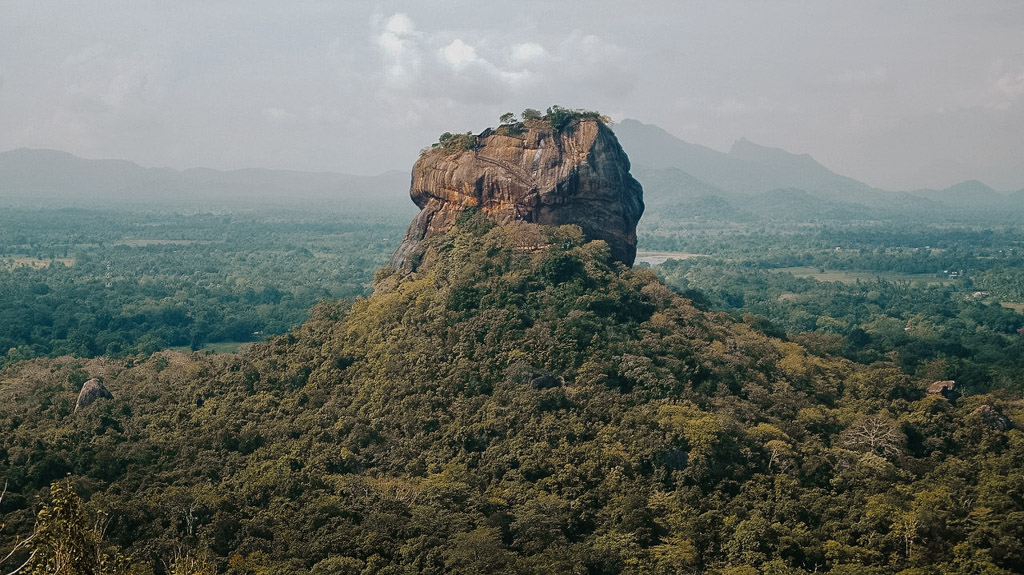
Visiting Sigiriya on your Sri Lanka trip?
Palm tree-lined roads, jungle plains, red rock outcrops, glistening blue lakes, and the odd roaming elephant – welcome to Sigiriya! This small village located in the northern centre of Sri Lanka is home to Sigiriya Rock Fortress, also known as Lion Rock Sri Lanka, one of the most historical places in Sri Lanka.
But, that’s not all this area has to offer, Sigiriya tourist attractions like scenic elephant safaris, Buddhist cave temples and ancient cities can be found here too.
To thoroughly enjoy the historic triangle of Sri Lanka, make sure to spend at least 2 days here to experience all of the best things to do in Sigiriya.
This guide has you covered with all the pertinent information about Sigiriya, including weather in Sigiriya, location of Sigiriya, Sigiriya visiting hours, and any other important details about Sigiriya you’ll need to make your trip the best it can be.
Looking for the ideal Sri Lanka route guide? See my 3 Week Sri Lanka Itinerary

* This post may contain affiliate links, which means I may receive a commission, at no extra cost to you, if you make a purchase through a link. Please see my full disclosure for further information.
Sigiriya Sri Lanka Quick Guide
SRI LANKA TRAVEL INSURANCE Check Prices of HeyMondo Insurance
SRI LANKA BUS + TRAIN TICKETS Check Bus Prices on 12Go
SIGIRIYA SRI LANKA HOTELS Check Prices of Sigiriya Hotels
SRI LANKA FLIGHTS Check Flight Prices on Skyscanner
SRI LANKA CAR RENTAL Check Car Rental Prices on Discover Cars
SIGIRIYA SRI LANKA GUIDED TOURS Check Tour Prices + Availability
Where is Sigiriya?
Located in the green Central Province of Sri Lanka, Sigiriya is about a 1.5 hour train ride north-east from the capital city of Colombo.
Sigiriya with a population of only 1,000 residents is known mainly for the Lion Rock Fortress, an ancient elevated royal city.
Click the Sigiriya map below to take you to Google Maps.

Best Time to Visit Sigiriya Sri Lanka
Sri Lanka has two distinct monsoon seasons, each striking the northeast and southwest coasts at opposite times of the year. The best time to visit Sigiriya in the centre of the country is during the driest months of January to April, as the monsoon hits this part of Sri Lanka between May to September.
The winter in this area that is characterized by wet and windy days lies between October and December but can provide great deals on accommodation in Sigiriya during this time.
How to Get Around Sigiriya
What I consider to be the best way to see a place, walking can enhance your experience with a combination of exercise and time to notice the details. Due to the small size of the village of Sigiriya, albeit a bit spread out, it maintains a high walkability level.
If you decide to enjoy the outlying activities, such as the Rock Fortress of Sigiriya or Dambulla Cave Temple Complex , hailing a tuk-tuk is your best bet. A tuk-tuk ride is super fun and can provide you with a chance to chat with a local. You can also opt for a Sigiriya taxi but that will come with a higher price tag.
TIP | Haggling is a must and make sure you stick to your guns and finalize the price before getting into the tuk-tuk.
Sri Lanka’s local bus system is one of the most economical ways to get around the island. Between Sigiriya, Dambulla, Anuradhapura and Polonnaruwa the bus runs frequently and a trip will only cost you a mere $0.50 USD.
TIP | Make sure you have small denominations of Sri Lankan rupees available as the bus driver will not give you change until the end of your bus ride.
No idea what to pack? Follow my comprehensive Sri Lanka Packing List
Where to Stay in Sigiriya Sri Lanka
As the main town in the historic triangle of Sri Lanka, Sigiriya enjoys a central location between neighbouring towns of Habarana and Dambulla and has a good range from budget hotels in Sigiriya to mid-level hotels in Sigiriya.
I’ve recommended three hotels near Sigiriya below, but you can also search for all options for hotels in Sigiriya Sri Lanka using Booking.com .
HERITANCE KANDALAMA | LUXURY

An architectural marvel and one of the best 5 star hotels in Sigiriya, this luxury accommodation is one with nature and situated right on Kandalama Lake. Three pools dot this jungle property with panoramic views of Sigiriya Rock and more.
CHECK PRICES + AVAILABILITY
BACK OF BEYOND | MID-RANGE

Economical tree house style villas and Sigiriya hotel nestled in the jungle near Pidurangala offer private washrooms and an onsite restaurant serving some amazing authentic Sri Lankan fare.
SHADY MANGO VILLA | BUDGET
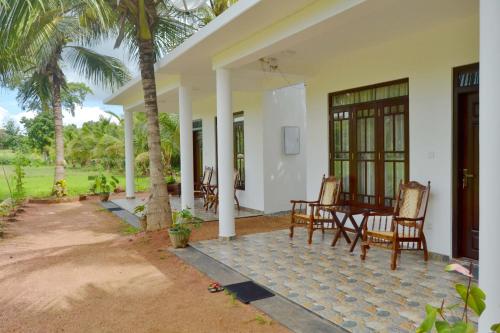
Located close to Sigiriya Fortress is this cozy budget-friendly homestay, with individual whitewashed air-conditioned rooms with basic amenities and free breakfast. If you are looking for a good value hotel in Sigiriya, this is a really good bet.

Things to Do in Sigiriya – Sri Lanka’s Historic Triangle
Explore the dambulla cave temple complex.
Located right outside of the city of Dambulla, the UNESCO Rangiri Dambulla cave temple complex has stood for more than 22 centuries as a sacred pilgrimage site, refuge and monastery. Up 525ft, embedded in a rock face, lies five cave shrines each with a plethora of immaculately made Buddhist statues. The caves are a must if visiting Sigiriya Sri Lanka. Monkeys can also be found here, a regularity at most tourist sites in Sri Lanka. They’ll mind their own business if you mind yours.
WHERE | Dambulla Cave Temple Complex, Sri Lanka
How to get from Sigiriya to Dambulla Cave Temple | Taking a taxi or tuk tuk is the quickest way to get there and will only take 25 minutes. Alternatively, you can hop on the bus on the main road in Sigiriya and get off at the Dambulla bus terminal. From there it is a 15 minute walk to the entrance.
COST | Dambulla Cave Temple entrance fee is 1500 LKR ($8 USD)
TIP | Go before the heat of the day hits the cave temple! As with all Buddhist temples, you will be required to take your shoes off before entering the complex, and the rock flooring of the cave exterior heats with the sun. I went around 4pm and was running like a hot potato across the stones in my bare feet to get from cave to cave. Highly recommend going in the early to mid-morning.
TIP | Make sure you grab a ticket from the ticket centre before braving the 364 stairs to the top, otherwise, you won’t be allowed in

Climb the Iconic Sigiriya Rock Fortress in Sri Lanka
The ancient city of Sigiriya is home to Lion Rock in Sri Lanka, a UNESCO World Heritage Site, and what a sight it is! An otherworldly formation of rusty red rock protrudes from the lush jungle, formerly the Sri Lankan capital city, ruled by King Kashyapa in the 5th century.
The rock itself displays beautiful Sigiriya frescoes, lion statues and staircases, but is also surrounded by expansive water gardens Sigiriya. Beware the line of tourists can grow as the day goes on, making climbing Sigiriya rock tiresome at midday.
Go early around 7am to get the most out of the Sigiriya Lion Rock. Visiting Sigiriya Rock Fortress is many people’s favourite things to do in Sigiriya, and for good reason.
WHERE | Sigiriya Lion Rock Fortress, Sri Lanka
BOOK A TOUR | Walking tour of Sigiriya Rock Fortress
How to get to Lion Rock Fortress from Sigiriya | Grab a tuk-tuk from your accommodation and make the short journey to the Lion Rock Sigiriya entry gate. Depending on how far away your hotel is from the site, you can walk the distance.
COST | Sigiriya Rock entrance fee is $30USD, among the more expensive entrance fees in the country and especially when you visit Sigiriya
HOURS | Sigiriya visiting hours are 7AM-5:30PM (last entrance at 5PM)
TIP | Bring a reusable water bottle with you, as park personnel will check your daypack for plastic water bottles and baggies. Let’s all do our part to leave the country as clean as we found it. Here is one of my favourite purifying water bottles .

Catch a Sunset on Pidurangala Rock Sigiriya
With impressive views of Lion Rock Sigiriya, the alternative hike of Pidurangala Rock is only a 5 minute tuk tuk ride away. The hike will take around 40 minutes each way, with a medium difficulty climb and a bit of boulder scrambling at the very top. Don’t worry, there’s a rest spot half way up with a beautiful reclining Buddha statue.
Go for sunset to get the most epic photos of Sigiriya lion rock and experience a different perspective while visiting Sigiriya. This is of the most underrated Sigiriya visiting places, and for that reason is something worth taking time for.
WHERE | Pidurangala Rock, Sigiriya
COST | Pidurangala Rock entrance fee is 500 LKR ($3 USD).
TIP | If you haven’t come prepared with appropriate temple attire, you will need to collect a free scarf from the temple for covering up shoulders and knees before heading up. After the temple you are able to take the scarf off.

Safari in Sigiriya at Hurulu Eco Park, Kaudulla or Minneriya National Park
Depending on the time of year, the elephant migration may take you to the Hurulu Eco Park. Here you can see large herds of Asian elephants (including babies!), on a large jungle plain.
My overall experience was good, but as an opponent of elephant orphanages and camel rides, I was skeptical. At the end of the day, the elephants didn’t seem to be bothered by our presence, but there were points during the safari when the number of jeeps far outweighed the number of elephants. This has become a major problem in recent years as the popularity of Sri Lanka increases.
If this bothers you, definitely opt to visit the Minneriya National Park or Kaudulla National Park, where there is no doubt that the elephants are in their natural habitat.
WHERE | Hurulu Eco Park , Kaudulla National Park or Minneriya National Park
BOOK A TOUR | Private tour of Minneriya National Park
COST | Entrance fees for Hurulu Eco Park, Kaudulla National Park or Minneriya National Park range from $15 – 18 USD.
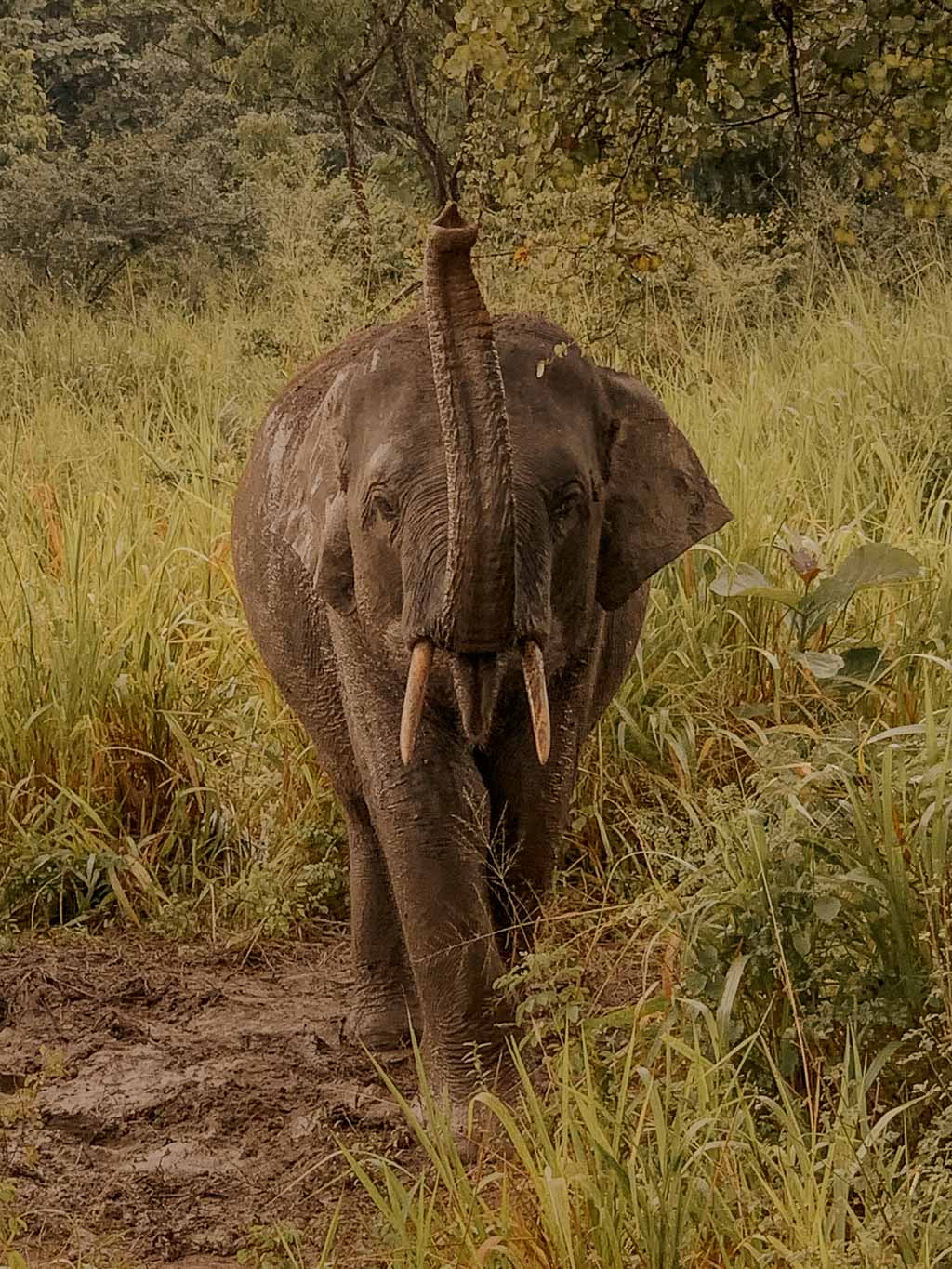
Visit the Sacred City of Anuradhapura
The sacred city of Anuradhapura , a Ceylonese political and religious capital that thrived for 1,300 years is located about a 1.5-hour drive from the village of Sigiriya in Sri Lanka. The UNESCO world heritage site and historical place in Sri Lanka can easily be reached as part of a day trip when visiting Sigiriya. The city was situated around a cutting from the ‘tree of enlightenment’, the Buddha’s fig tree, brought to Sri Lanka in the 3rd century B.C.
Anuradhapura was abandoned after an invasion in 993, and was concealed in the heavy jungle for many years after. This sacred city features monasteries, monuments and palaces, and so many famous monuments of Sri Lanka so make sure to spend the majority of your day here.
WHERE | Anuradhapura, Sri Lanka
BOOK A TOUR | Private tour of the ancient city of Anuradhapura
How to get to from Sigiriya to Anuradhapura | Take a bus or tuk-tuk to Dambulla, then transfer to a bus heading for Anuradhapura
COST | Anuradhapura entrance fee is 3,920 LKR ($25 USD). If you’d like to opt for an all-inclusive experience, you can book an organized day trip for $40 USD to Anuradhapura here .
TIP | To enhance your experience, hire an English speaking guide at the gates. Prices range from 850 – 1000 LKR (between $4 – 6 USD)

Take a Day Trip to Polonnaruwa
After the destruction of Anuradhapura in 993, the second capital of Sri Lanka, Polonnaruwa was created. This city, located a 1.25 hour drive east from Sigiriya was once a fabulous garden-city built in the 10th century. Deemed a UNESCO world heritage site, Polonnaruwa features domed temples, swimming pools, palaces and audience halls.
WHERE | Polonnaruwa, Sri Lanka
How to get from Sigiriya to Polonnaruwa | Catch a bus or tuk tuk to Dambulla (about a 25 min ride) and get off at Inamaluwa Junction. Then, catch a bus heading toward Polonnaruwa, a 1.5 hour journey).
COST | Polonnaruwa entrance fee is 3,920 LKR ($25 USD). You can also arrange a private day tour that will pick you up at your hotel in Sigiriya and take you to all the main attractions in Polonnaruwa starting at $64 USD).
TIP | Rent a bicycle to easily get around this small ancient city which can be rented outside the main gate for just a few rupees
TIP | Anuradhapura versus Polonnaruwa | Anuradhapura offers a more lively town centre with prominent Buddhist devotion, while Polonnaruwa is more peaceful, smaller and condensed with more well preserved artistic monuments and takes shorter to peruse. You choose! If you have the time when visiting Sigiriya, definitely try to fit both into your schedule

Where to Go After Sigiriya
You have a couple of options here for your next destination after visiting Sigiriya:
JAFFNA | First, you could head up to the cultural capital of the North, Jaffna. This city is home to the majority of Muslim residents, and the devastation of the recently lost civil war is apparent. This shouldn’t dissuade you though, the city is full of great culture and people and since it’s not on any usual route guides for Sri Lanka, you’ll find fewer tourists and more Sri Lankan authenticity.
TRINCOMALEE | Secondly, you can head out to the northeast surf spot of Trincomalee where the beaches are less busy and more expansive than in the south. This surfing and whale watching destination is also less developed, so don’t expect to get a myriad of western food options. It’s the perfect opportunity to truly connect with the local people and try a Sri Lankan curry!
KANDY | If time is tight, head straight to the cultural capital of Kandy using my ideal Sri Lanka route guide . The best way to get from Sigiriya to Kandy is by grabbing a tuk-tuk to the bus station in Dambulla. From there you can take a bus to Kandy. This will cost you less than $10USD and will take 3 hours.
More Essential Guides for Sri Lanka
Want to continue planning your trip to Sri Lanka?
Check out my 3 WEEK SRI LANKA ITINERARY or if you prefer to determine the route yourself, read the specialized guides below for some of the best experiences in Sri Lanka:
SRI LANKA BUCKET LIST | Get inspired by all that Sri Lanka has to offer. Here are my Sri Lanka highlights.
SRI LANKA TRAVEL TIPS | Prepare for your Sri Lanka trip by reading my 21 top tips on what you should know before visiting the beautiful teardrop isle
KANDY | Bustling market streets, quiet strolls around the lake, lush botanical gardens, and ornate Buddhist temples, the cultural capital of Sri Lanka has it all
ELLA | Nestled in the green centre of Sri Lanka, this hiker’s paradise features trails with panoramic views of jagged green hills, deep valleys and rushing waterfalls.
YALA NATIONAL PARK | Majestic elephants, elusive leopards, and a myriad of bird species can all be found in one of the biggest national parks in Sri Lanka.
WELIGAMA | Where surf culture is alive and thriving, this central town is located on the golden south coast of Sri Lanka and offers the best surf beach for beginners, and an abundance of traditional and modern eateries.
GALLE FORT | Fortified stone walls, dutch and Portuguese style architecture, great food and shopping all culminate in this little town that was once a major Sri Lankan trading post.
SRI LANKA PACKING LIST | Take the guesswork out of packing and easily check off my list to all things you will need for Sri Lanka’s warm climate
Click Image Below to Save Pin for Later!

Haley is the founder of the global travel blog, Haley Blackall Travel. She has travelled to 40+ countries across 5 continents over the last 15 years. She loves to share in-depth travel guides and recommendations to help travellers get the most out of their vacation time, including her favourite boutique hotels, things to do and travel itineraries.
Similar Posts

12 Top Things to Do in East Bali – Waterfalls, Temples, Views + More
East Bali is one of the island’s undiscovered regions. Some of the best things to do in East Bali include iconic views of Mount Agung, lush green rice fields, ancient temples, calming water palaces, and picturesque bamboo villas. Most opt to stay in tourist hubs such as Canggu, Seminyak, Uluwatu, or Ubud, but I highly…
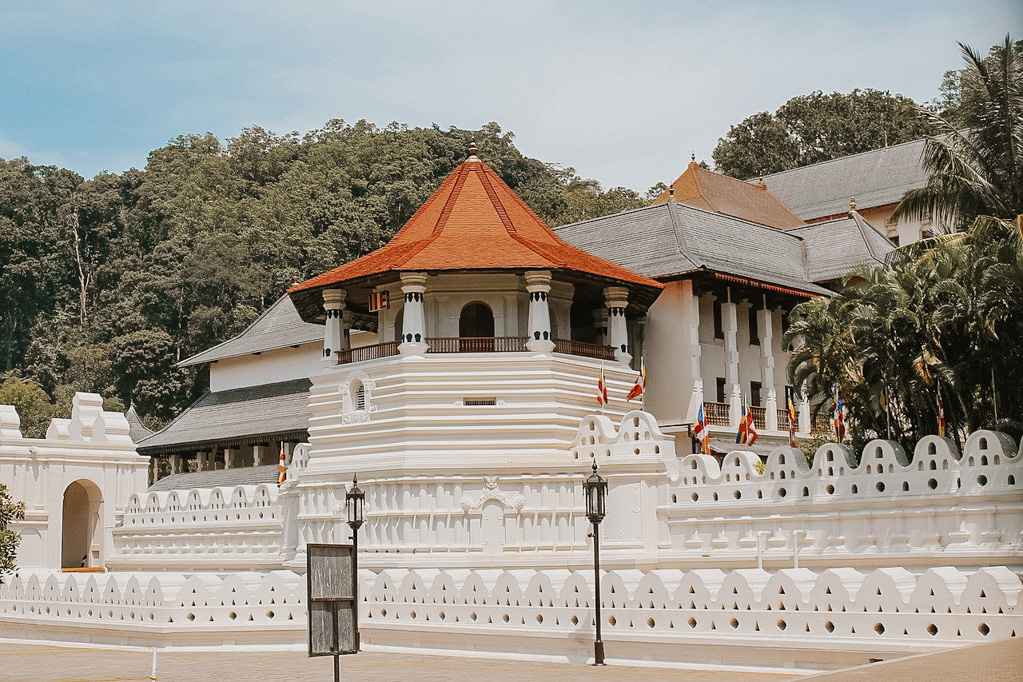
The Best Things to do in Kandy, Sri Lanka
Looking for the best things to do in Kandy, Sri Lanka? Coined as the second city to Colombo, Kandy is full of culture and life. Its elevation in the green peaks gives this city a much more small-town feel. You won’t have any issue escaping the commotion of the city centre if you want to…

Lahangan Sweet, Bali – Mount Agung Viewpoint
Viewing Mount Agung at sunrise or sunset is one of the best things to do in Bali. And the Lahangan Sweet viewpoint is no exception. Atop a lush green mountain ridge in East Bali, you can see the mighty Mount Agung to your left and the gorgeous Bali coastline to your right. If you end…
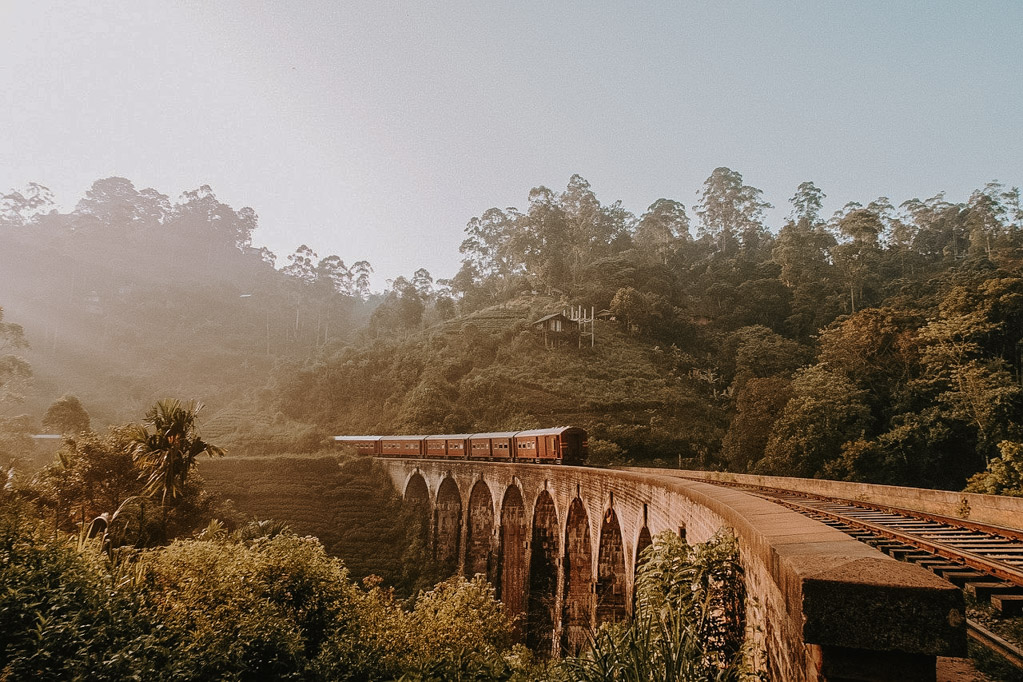
9 Amazing Things to do in Ella, Sri Lanka
Ella Sri Lanka, nestled 1,041m up into the lush green jagged hills and tea plantations of central Sri Lanka, is a hiker’s paradise. A major hub for hip, young European backpackers, this once quaint sleepy town has grown in popularity around the world. Some of the top things to do in Ella are the Insta-famous…

The Best Sri Lanka 3 Weeks Itinerary: Ideal Route Guide
Planning 3 weeks in Sri Lanka? Here is my guide to the teardrop isle. In this 3 week Sri Lanka itinerary you will experience lush jungled hilltops, captivating wildlife, culture-steeped cities, and white sand beaches with some of the best surf spots in the world. Not to mention the earthy, spicy and nutritious food! The…
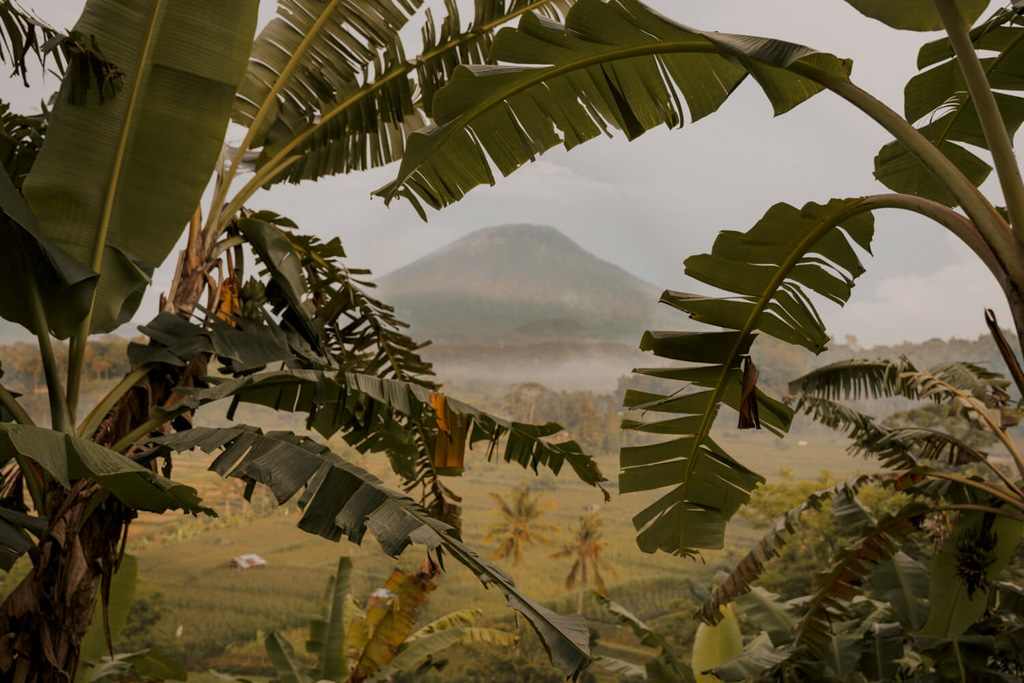
Bukit Cinta Bali – Mount Agung Sunrise Viewpoint
This monumental and moody Mount Agung viewpoint is one of the best ways to see the glorious volcano. Bukit Cinta Bali, meaning ‘hill of love’ in Bahasa, is quite possibly the best view of Mount Agung you can get. Especially when you visit at sunrise. This is the time of day that the volcano will…
Leave a Reply Cancel reply
Your email address will not be published. Required fields are marked *
Save my name, email, and website in this browser for the next time I comment.
Privacy Overview

Ultimate Guide to the Sigiriya Lion Rock in Sri Lanka
The Sigiriya Lion Rock in Sri Lanka is one of the country’s most fascinating and spectacular tourist attractions. This UNESCO World Heritage Site comprises an enormous, distinctive rock fortress that is unlike anything else found anywhere else in the world.
This is one of the most legendary places in Sri Lanka, and the fortress dates back centuries, and over the years has had many uses and has fulfilled many rules for local kings, rulers and religious leaders.
It’s a stunning example of ancient architecture and human ingenuity and one of the best sites to visit in Sri Lanka.
As well as ruins that are thousands of years old, you can find exceptionally preserved rock art and frescoes, as well as extensive gardens that were landscaped over time and that surround the giant rock itself.
This is a place not to be missed, and to help you to plan your here trip here, this is our visitor’s guide to Sigiriya Sri Lanka.
Don’t leave home without: Lonely Planet Sri Lanka (Travel Guide)
Sigiriya Lion Rock in Sri Lanka: Plan Your Visit
Table of Contents
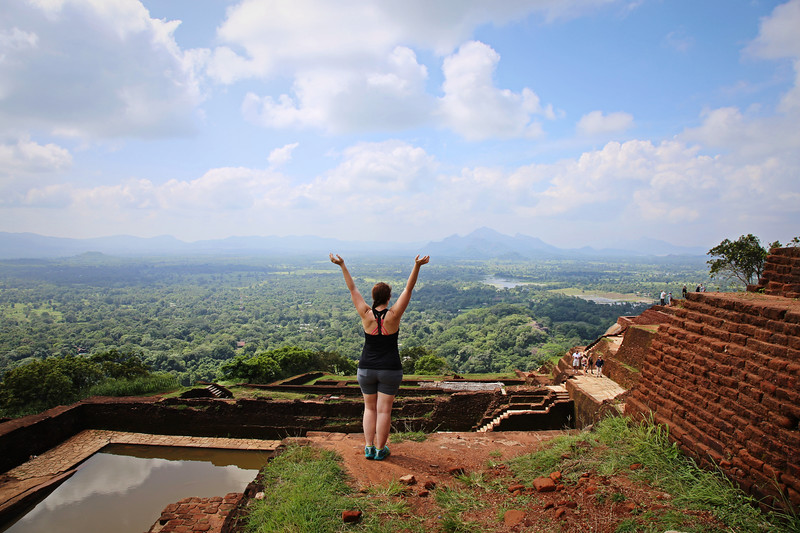
Where is Lion Rock in Sri Lanka?
Sigiriya, Sri Lanka is located in the central province of the country, in a historically important region that comprises many ancient sites. The rock itself is quite isolated, and the nearest large town and transport hub is located around 20 miles away at Dambulla.
This is the gateway to Sigiriya and you can find buses here from across the country.
Colombo is around 120 miles away, and to travel from the capital would take a minimum of 4 hours on public transport. You can also travel from popular destinations such as Kandy to the south or Anuradhapura to the north.
From Dambulla, you can catch the public bus to Sigiriya or hire a local tuk-tuk driver to transport you.

Best Time to Visit Sigiriya
Sigiriya can be visited all year round as long you don’t mind risking heavy rainfall during the wettest parts of the year. The region’s dry season runs from April to September and outside of this, monsoons frequently occur in the area.
The busiest season, when the rock can be completely crowded, is, of course, the dry season, so traveling in the monsoon can be an opportunity to see this impressive site with few others around, as long as you don’t mind getting a little wet.
When you do visit Sigiriya Sri Lanka, it’s best to try and arrive as early as possible to avoid both the intense heat and the worst of the crowds.
To get to the summit of the rock involves climbing a huge set of steps, so it’s best done in the morning to avoid overheating in the scorching Sri Lankan sun.
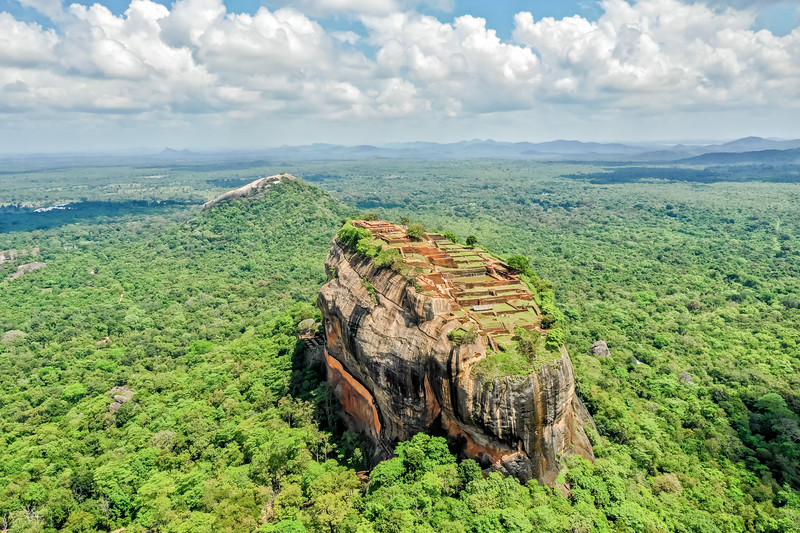
The Ancient City of Sigiriya
Sigiriya is one of the most astounding remnants of a past Sri Lankan civilization. The name of the huge rock itself translates to English as the Lion’s Rock, because of the enormous Lion’s Paw that was carved by the entrance guarding the way in.
The rock is almost 200 meters high and geologically is a plug leftover from the remains of a long-extinct volcano.
The giant rock is impressive enough on its own account, and that’s before you even begin to consider the long history and the incredible ruins that are found here.
The area is thought to have been inhabited for thousands of years, and early Buddhist monks were some of the first locals to take shelter in the extensive caves found in the rock.
In 477 AD, when King Kashyapa took power, he started to move his capital city to Sigiriya Sri Lanka, and he began to turn this rock into not only his palace and fortress but into a huge planned city.
The king’s empire though fell in 495 AD and the Lion’s Rock began to fall into disuse and disrepair. The new ruler of these lands gave the rock to Buddhist monks, and it remained an important temple complex for many centuries until it again was abandoned and left to be overgrown by nature.
It was ‘rediscovered’ in 1831 by British soldiers in Sri Lanka, and since then it has been the focus of much archaeological scrutiny, while in more recent years it’s become one of the country’s most visited tourist attractions.
Our top recommended tours including Sigiriya:
- Sigiriya Rock and Dambulla Cave Temple all-inclusive Private Day Trip
- Full-Day Tour of Sigiriya Rock Fortress and Dambulla Cave Temples
- Private day Tour to Sigiriya from Kandy
- Private Day Trip to Sigiriya and Hiriwadunna from Colombo

Visiting the Sigiriya Lion Rock in Sri Lanka
The summit of this impressive rock can be reached by a set of steep stairs that encompass almost 1200 steps.
It’s a sweaty and arduous slog to the top, but it’s worth every step to experience not only the expansive views but the ruins of the palace and fortress that are waiting for you.
Before you begin the climb though, at the main entrance to this large compound you need to pass through the local museum.
This tells the story of the legends and myths that surround Sigiriya as well as providing a detailed history that will give you a great insight into the importance of the site for past civilizations, particularly for the founding king who built his palace here more than 1500 years ago.
The museum also focuses extensively on the many excavations that have been made over the last hundred years, beginning with the British who in the 1890s began to realize its importance only several decades after they had initially rediscovered it.
When you enter the compound itself, you will soon realize that this was more than just a fortress. Sigiriya was an entire city, planned and designed to perfection by the early architects who built it.
Once you are through the main gate, you will be inside the extensive gardens. Sigiriya was built symmetrically, and the planning involved the construction of a huge water reservoir that could sustain thousands of people who lived in this royal capital.
Even more impressive though are the gardens. To reach the rock, you must walk through the beautiful, verdant landscapes that have been here for centuries.
The king ordered these to be built as a symbol of status and for the nobles and royalty to enjoy at leisure. They are thought to be one of the earliest examples of landscaping in the world, and today they are kept luscious and green by an army of workers toiling in the heat.
Our top recommended tour including Sigiriya Lion Rock: Sigiriya Lion Rock Fortress day tour
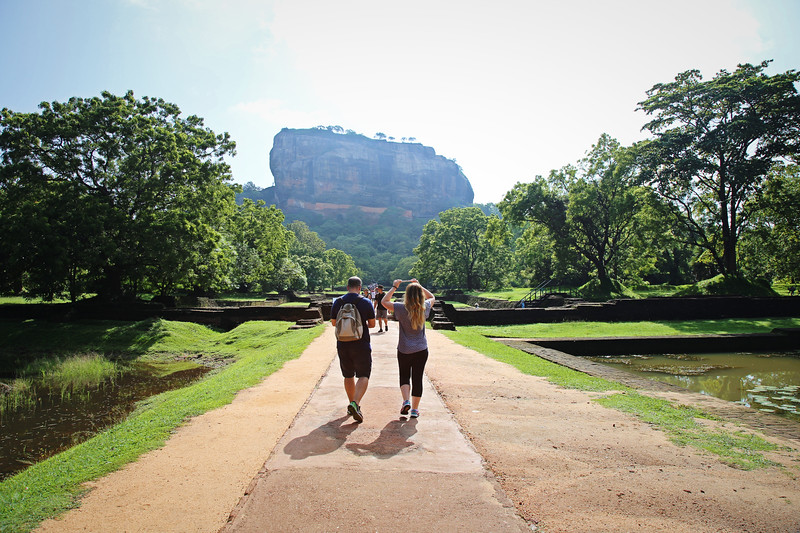
Hike to the Summit of Lions Rock
After you have admired the gardens, it’s time to climb the rock. Come well prepared with plenty of water, sunscreen and of course a hat to keep off the intense sun. The rock is almost vertical in shape, and to reach the top, almost 1200 steps were literally carved into the mountainside.
The path is steep in places, so take it slow and enjoy the incredible views on your way up. On the walk, you can enjoy the many cave frescoes painted onto the rock walls itself.
Another important site is the Mirror Wall, which was so highly polished that when it was first constructed, it was thought to have been quite literally used as a mirror by the king.
After an hour of upwards walking, you will reach the summit, where not only will you be greeted by expansive views over the gardens below and the surrounding, green forests, but you can explore the ruins of the palace.
There is little left, as the ravages of time have caused much of the brickwork to crumble through the centuries, but you can still enjoy a sense of the grand architectural designs and elaborate construction work that allowed this place to be built atop the rock.
Of course, the only way back down is to walk, but the way back of the trail is much easier on the downhill.
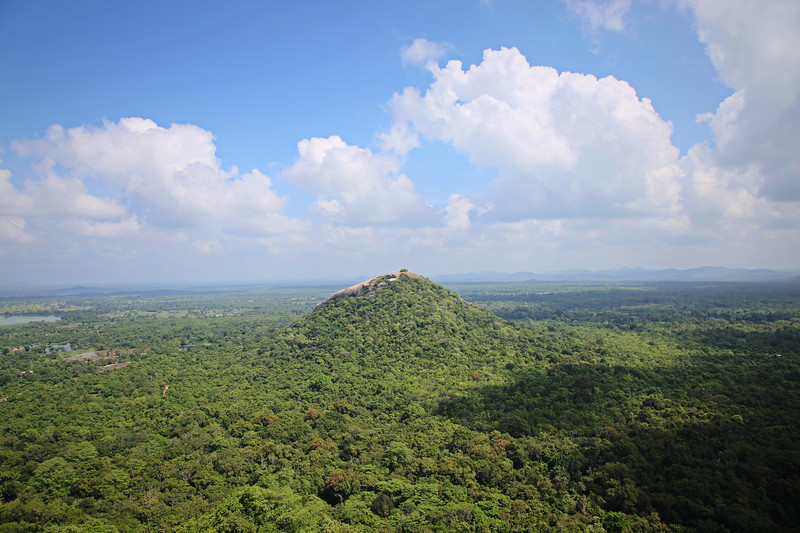
Visiting the Pidurangala Temple
Pidurangala Temple is found just a mile away from Sigiriya. This temple is found at the base of a rock that’s equally as distinctive and dramatic as Sigiriya, however, it’s not nearly as frequented by tourists and you will find it to be much less busy.
Although historically, it’s not as important as its neighbor, this rock also offers incredible views over the surrounding area, and from its summit, you can actually see Sigiriya in the distance.
This makes it an excellent place to get a sense of the size and scale of this huge, ancient undertaking. To get here, it’s advisable to take a tuk-tuk, as the walk is hot and tiring.
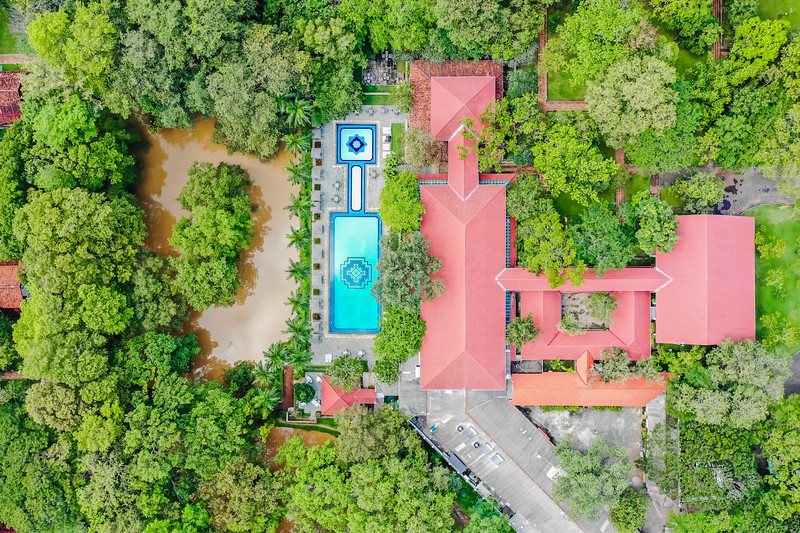
Where to Stay Near Sigiriya
While you can choose to stay in the nearby town of Dambulla, which acts as the regional transportation hub, you can also choose to stay closer to Sigiriya itself, as there are several hotels on the road to the entrance itself.
Budget travelers will be better off staying in Dambulla and then either taking a tuk-tuk or public transport to the rock, but if you want to splash out a little, then you can stay closer, and then have the opportunity to head in even earlier than everyone else to experience the rock without the crowds.
The most well known and impressive hotel option close to the rock is the Hotel Sigiriya , which is actually located within the boundaries of the UNESCO World Heritage Site and offers the best rooms and service in the area.
Personally, we stayed at the Cinnamon Habarana Lodge and it was spectacular! They have an extensive and private estate that is surrounded by nature. The rooms are huge and the service is very good.
They can also arrange safaris in nearby Kaudulla or Minneyira, depending on the season, as well as visits to Dambulla and Polonnaruwa .
More on Sri Lanka:
- Ultimate Sri Lanka Itinerary: 2 Weeks to 4 Weeks
- The Most Spectacular Places to Visit in Sri Lanka
- Best Sri Lanka Safari: 8 Park Comparison guide
- 10 Epic Things to do in Ella, Sri Lanka
- 9 Epic Reasons to Visit Mirissa, Sri Lanka
- Safari Guide to Kaudulla National Park
- Yala National Park Safari: Only Guide You Need
- Kumana National Park-The Only Safari Guide You Need
- 10 Sri Lanka Beaches You’d Be Foolish to Miss
- 11 Epic Reasons to Visit Arugam Bay (Spoiler: Epic Breaches!)
- Boogie Boarding in Sri Lanka
Did you like this story? Share it!
Travel planning resources, about lina stock.
Lina is an award-winning photographer and writer that has been exploring the world since 2001. She has traveled to 100 countries on all 7 continents. Member: SATW, NATJA, ATTA, ITWA
Leave a Comment Cancel reply

A Guide to Sigiriya in Sri Lanka (aka: Lion Rock)
Even before you get to the top, it’s undeniable that Sigiriya in Sri Lanka, an ancient fortress known more affectionately as the Lion Rock, is a magnificent and impressive site. Designated as a UNESCO World Heritage site in 1982, this rock, towering at 200 meters above water, has obtained a lot of history, story and legend, and archeological wonder throughout its many years of existence. Although not an easy climb (there’s over 1200 steps!), it’s a site not to be missed when in Sri Lanka.
In this guide, you’ll learn about its history, what the site holds in today, and how you, too, can check climbing Sigiriya off your bucket list .

History of Sigiriya Fortress
Sigiriya Fortress was built by King Kashyapa I, in the 5 th century, at the time of which the area belonged to the Moriya, who were the natives to the Sinhalese dynasty. This fortress played the role of capital to the kingdom, until the king was defeated in 495 A.D. Before the fortress was built, the rock was inhabited by Buddhist monks, and after the passing of the king, it returned to its function as a monastery. However, evidence exists that this area has been lived in since as long ago as the 10 th century B.C.
From then on, the capital changed with each short-lived dynasty, until the region was mostly abandoned by the Sinhalese dynasties altogether. It wasn’t until the 19 th century that Sigiriya became of any significance again, when it became a military fortress for the kingdom of Kandy. Directly afterwards, it became a site of interest during the colonization of the British Empire, and through the efforts of military officer Jonathan Forbes specifically.
It is generally regarded to be one of the most valuable historical sights in Sri Lanka. The structure of the rock was formed from magma, which came from a now extinct volcano. It’s deemed to have a lot of importance from archaeological perspectives, with the fortress including numerous intriguing features, such as the Mirror wall, which is said to have been so polished once upon a time that the king could see his reflection in it. Additionally, its time as a center for power, however brief, in combination with its remote location, have paved the way to creating a significant legacy to Sigiriya Rock. Not to mention its significance to the Sinhalese cultures.

About Sigiriya in Sri Lanka
As was mentioned, there are many striking features to Sigiriya, which are the reason why it’s quite possibly Sri Lanka’s most visited tourist attraction.
The Gardens
The Gardens are composed of three components: the cave and boulder gardens, the terrace gardens, and the water gardens. Located on the west side of Sigiriya, the water gardens themselves are further divided into three sections, with especially the fountains remaining an impressive sight to see today. But while both the water gardens and the boulder gardens are stunning, it can be said that the terrace gardens are the most impressive among the gardens of Sigiriya in Sri Lanka, complete with a limestone staircase that runs through it. In general, these gardens are worth visiting already simply for the fact they are some of the oldest gardens still existing in the world.
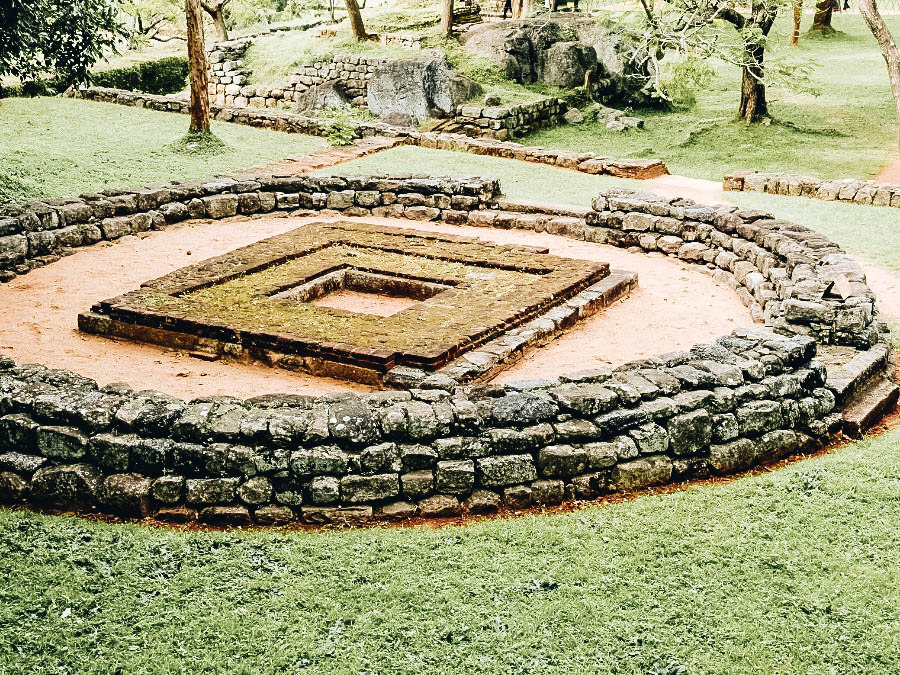
The Rock Palace
This Rock Palace was officially the king’s palace once upon a time. It is also perhaps Sigiriya’s biggest source of pride, and certainly among the biggest reasons why tourists flock to the attraction. Besides the palace, there’s the fortified fortress, as well as numerous rock carvings and sculptures, at this site.
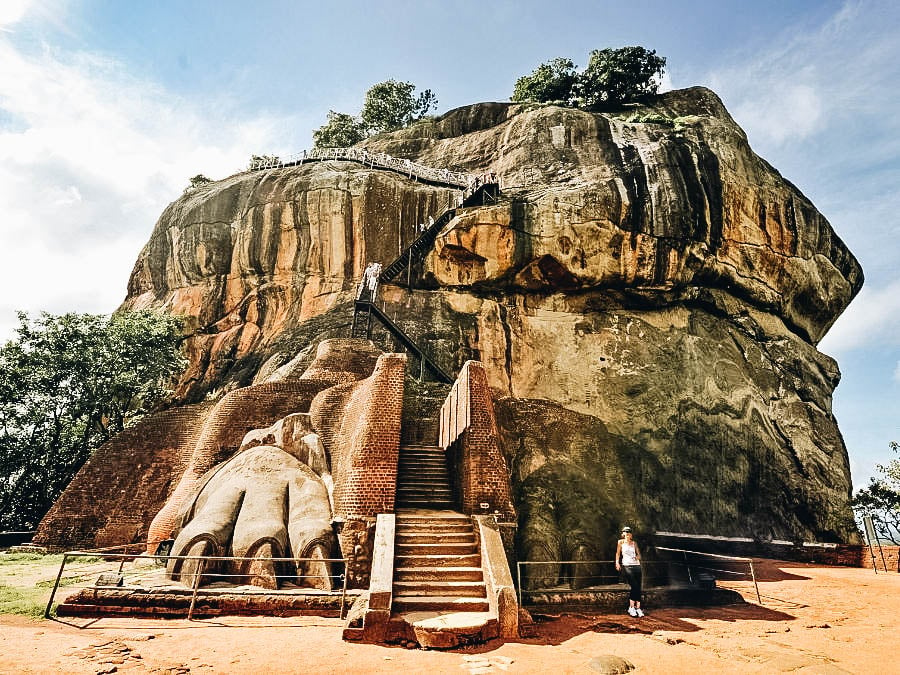
Lion Rock Sigiriya Graffiti
Much of the Lion Rock’s Mirror Wall is covered with ancient graffiti. They were inspired by the frescoes – which you can read more about below – and in a major part feature poetry. These graffiti have been a great help in identifying new words of the Sinhala language.
Boulder Garden of Lion Rock Sigiriya
Unlike the other gardens at Sigiriya, the Boulder Garden is built in a largely asymmetrical fashion. Much of the gardens are also from a time period before Sigiriya ever became of significance to the Sinhalese, having instead been built by the monks who were the original inhabitants of the rock. Sadly, not a lot of this ancient handiwork has lasted through the times to still be admired today, although plenty of artistry and artifacts still remain to be seen today.
Lion Staircase
This staircase was also built by King Kashyapa I, guarding the entrance to his palace. It is located on the northern side and is about all that remains of what was once a much larger structure. At its prime, the staircase was 35 meters high and 20 meters wide.

Palace Complex of Sigiriya Lion Rock
Besides the above-mentioned qualities, the palace complex of Sigiriya Rock also featured impressive frescoes, as well as a cave named “Cobra Hood Cave”. Located within the Boulder Garden, it is a projection representation of a cobra with an open hood. This cave is typically visited on your way back from the site’s summit.
Lion Rock Frescoes
Featured in many essays about Sigiriya and making up a large wall area on the western side of the Lion Rock, these frescoes represent women with flowers in their hands. Specifically, they are located about halfway up the rock. Not many of them have survived up until today, but the ones that have remain as impressive as ever, and a lot of speculation over who these women were continues all the way until today.
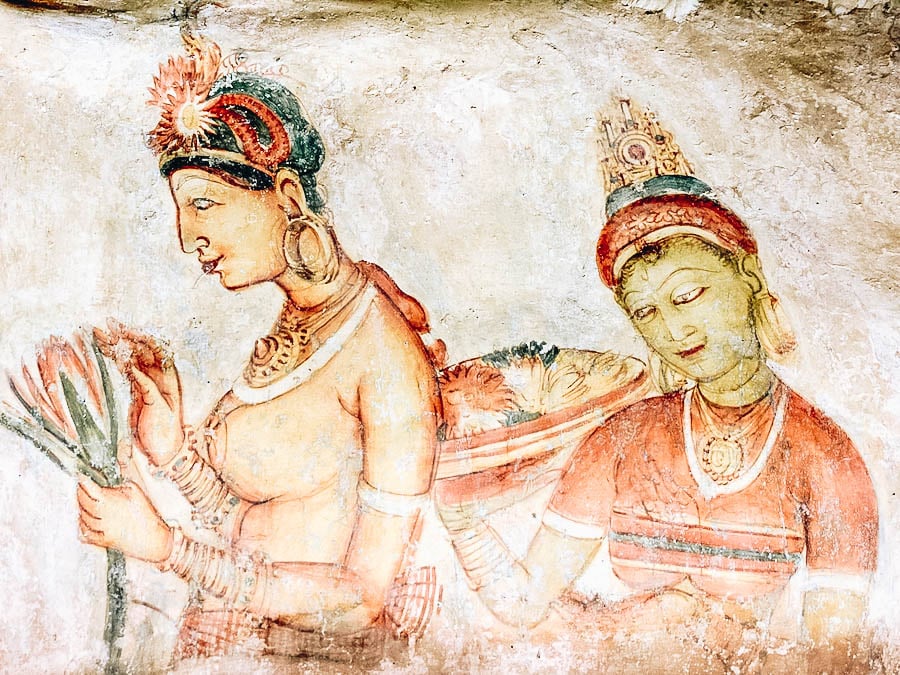
Climbing the Steps of Sigiriya
Although climbing up Sigiriya is not difficult per se, it is quite demanding. The rock stands 200 meters above water and there are 1200 steps to be conquered to get up there. Divided into six parts of climbing, the climb gets harder the further into it you get. It can take nearly 2 hours to reach the summit, but frankly you are not in any rush to get there anyway, as there are many attractions, starting with the boulder gardens, scattered on the lower stages of the climb.
To climb Sigiriya during the best possible time, time your trip to January, February, or March, with February being the best of these months. During this time of year, the temperatures are somewhere around 28 to 32C (82-90F), with possible downpours, but mostly in the afternoons and only lasting for a short while. Even during these months, your very best bet is to climb up Sigiriya in the morning hours of the day.

Visiting Nearby Pidurangala Rock
While not as popular to visit as the Lion Rock, Pidurangala Rock is another impressive rock in the region—it’s actually almost as tall as Lion Rock! The attraction is definitely a worthwhile addition to your itinerary for discovering this part of Sri Lanka. The hike up there takes around 30 to 40 minutes, at around moderate difficulty level. It’s said to have also been a Buddhist monastery once upon a time, and there’s still a cave temple located on the trail today. From its summit, you’ll have amazing panoramic views, as well as views of the Sigiriya Fortress.
My Experience Essay
Climbing the 368 stairs to the top of Bartolome island in the Galapagos made my brow trickle with sweat and scaling the 468 stairs of the Florence Duomo made my lungs ache, even the measly 109 steps of the St. Simons Lighthouse in Georgia made me embarrassingly winded. If these were all examples from the past, then what would the 1200 steps of the 200m high Sigiriya rock in Sri Lanka do to me? I was about to find out and I was afraid—very afraid.
Sigiriya is an ancient palace, built in 480AD, located in the central Matale District of Sri Lanka. The UNESCO World Heritage site is known for it’s beautifully landscaped gardens, well-preserved frescos and… a crap load of stairs, all at different anxiety producing levels. But, I was convinced that the experience would be a great addition to my list of the top things to do before you die .
In the early morning, I left the safety of my cozy room at Cinnamon Hotel’s Chaaya Village Habarana to embark on a bus road trip to the the rock. When the tour guide stopped at the bottom of Sigiriya to allow for a photo opportunity, I sensed that I may be in a bit of trouble. It looked HUGE from far away, which meant it would only grow in size as we got closer. All the agonizing pilates classes better help with climbing this rock.
Stepping out of the bus, climbing guides immediately approached each of us asking if we needed any assistance for the trek. We were warned that if you agree to an escort, it will cost you about 1000 rupees ($7.62 usd). I opted to do this climb solo, though some strong man pushing me up sounded like a solid back-up plan.
Crossing the lilypad filled moat, I saw a glimpse of hope for a leisurely climb. The stairs started in sections of about 20 at a time. This was nice. The moss filled steps were picturesque with plenty of landing pads for photo opportunities, monkeys climbed the walls and stray puppies were scampering about. Maybe climbing Sigiriya won’t be so bad after all. Wishful thinking.
Things got a little hairier as I continued on, the steps steeper and sections longer. Then there was a line forming to walk up a spiral metal staircase. In order to see the well preserved Sigiriya frescoes you need to take this route, which I did.
Carrying on I finally reached the Lions Den, a large plateau which acts as a resting ground for explorers. I was warned that if you suffer from vertigo do not go past this point and many climbers opted to turn around here. But, I pressed on hoping that vertigo would not find me.
The stairs hugged the side of the rock and, though they seemed secure, looking down took my breath away in more ways than one. Climbers of all ages were attempting this part of the trek and you could visibly see the fatigue on their faces. I am sure mine looked the same. After stepping foot on the last step of my ascent, before looking at the picturesque view before me, I congratulated myself for the feat that had just been accomplished. And I silently thanked my pilates instructor.
Then, I took a look around to see beauty in a form that I had never witnessed before. At the top was weathered stone ruins, lush green land, a water filled pool and a perfect view. The ideal reward. After taking in the scene, I started my decent, which in some areas was more dangerous than the ascent. Plus, it was a bit of a labyrinth to get out, lacking any signs and each set of stairs leading to another outlook.
In the end, after a total of two and a half hours, there was no choice but to exit through a section of souvenirs (of course), where I gratefully paid 300 rupees ($2.29 USD) for a diet coke, extremely expensive by typical Sri Lankan standards. As I walked towards the bus at the bottom of Sigiriya monkeys roamed close by, most likely wanting a sip of my overpriced diet coke. Not gonna happen.
My legs were wobbling when I climbed the last few stairs for the day, the ones onto the bus, where I plopped into my seat and took a well deserved nap.
Have you already visited this majestic Sigiriya in Sri Lanka or is it in your dreams to do so in the near future? As one of the most fascinating sights to see in all of Asia, surely you’ll want to venture out to Sri Lanka and the Lion Rock one day in your life! Especially when you are in Sri Lanka, you ought not to miss out on visiting this legendary fortress that’s still gaining curiosity among archeologists today.
Sigiriya Essentials Where is Sigiriya?: Sigiriya is located in Sri Lanka’s Central Province. More specifically, it is located in the northern part of Matale District. Dambulla is perhaps the closest town to Sigiriya. How to get to Sigiriya?: You can get to Sigiriya by bus from Dambulla, from where you can catch the bus at 30 minute intervals every day between 6:30AM and 6:00PM. If you are not staying in Sigiriya for the night, it is highly recommended you do not miss the last bus back to Dambulla as it is still a 25km distance between the two places. You can get to Dambulla from most cities, including Kandy. If you’re coming by car, you can reach Sigiriya by driving on A1 or A6. The easiest choice would be to join a tour group like the all-inclusive Polonnaruwa & Sigiriya Tour departing from Dambulla. Opening Time of Sigiriya Lion Rock for Visitors?: The site opens for visitors at 7AM each day of the week. The last time of admission is at 5PM, and the Lion Rock closes for the day at 5:30PM. Entrance Fees for Lion Rock Sigiriya: For foreign tourists, the entrance fee to Sigiriya is $30 USD— and the ancient site is worth every penny! Can I Buy a Sigiriya Lion Rock Entrance Ticket Online?: Yes! If you place on venturing to Sigiriya on your own you can book your ticket online in advance at this link ! This post may contain affiliate links. If you make a purchase through my links, I earn a commission that helps to keep this blog running—at no extra cost to you. For more information read my full disclosure .
You Might Also Enjoy
Trek through a Sri Lankan Village: Hiriwadunna
2 thoughts on “A Guide to Sigiriya in Sri Lanka (aka: Lion Rock)”
i was really planning to go thank you for your guide
Thank you for sharing this information its informative
Leave a Comment Cancel reply

Hey Bucket Listers! I'm Annette .
I’m a goal obsessed mid-lifer, traveler, experience collector, fear crusher, digital marketer and author with big bucket list dreams. Let's Connect!
GET MY 2,000 free bucket list ideas
Jump right in and you will get your printable ideas by email:
Whatcha Looking for?
Home About Blog The Shop Partnerships Contact
Bucket list ideas travel facing fear & anxiety.

Sri Lanka travel guide
Ultimate Guide to Sigiriya -The Lion Rock in Sri Lanka
Nicknamed the eighth wonder of the world, Sigiriya is the most remarkable cultural landmark in Sri Lanka. Sigiriya or the Lion Rock is an ancient rock fortress created in the 5th century AD. This 200 m tall huge rock is towering over the surrounding greenery of the plains in central Sri Lanka. Sigiriya Rock Fortress remained the capital of Sri Lanka for 22 years, due to the strategic advantage of this location.

Sigiriya fortress complex has significant archaeological importance, and it is a UNESCO world heritage site in the country. It stands as testimony to the great architectural skills and urban planning of ancient Sri Lankans. Since Sigiriya is one of the most valuable historical monuments in the country, it attracts thousands of visitors every year. Especially, it is highly famous among tourists, making Sigiriya the most visited tourist destination on the island.

Access to Sigiriya
Sigiriya has located 150 km from Colombo , between the towns of Dambulla and Habarana. If you hire a taxi to Sigiriya, it may cost around 80 USD. You can reach Sigiriya within 2 and half hours from Colombo by taxi.
The cheapest way to get there is to take a bus or train from Colombo. As there is no direct bus or train that goes to Sigiriya, you need to travel to Habarana which locates 15 km away. Then you can take a tuk-tuk ride to the destination. Overall, Sigiriya is reachable within 3 and a half hours from Colombo.
The quickest way to get to Sigiriya from Colombo is by flying there directly. Cinnamon Air operates daily flights from the domestic terminal of the Colombo Airport to Sigiriya. It will take only 30 minutes to reach Sigiriya by air.
History of Sigiriya
Though Sigiriya is a marvelous creation, it has a quite dramatic historical background. The creator of Sigiriya was King Kashyapa, who was the eldest son of King Dhatusena. Since he was the son of a non-royal concubine, he wasn’t the heir to the throne. Moggallana, the son of the royal consort was the rightful heir to the throne. Therefore, Kashyapa acquired the throne by overthrowing King Dhatusena, while his brother Moggallana fled for his life.
As a result, King Kashyapa was disgraced among the public. Fearing an evident attack from Moggallana, Kashyapa moved his capital to Sigiriya Rock. At Sigiriya, he constructed a large citadel on top of the huge rock and an elaborate city with all the facilities. Since this rock fortress was rising high above the surrounding plain, it offered him a safe and secure place. He could get an unhindered view of any advancement of intruders from all directions, which ensured his protection.
King Kashyapa reigned for 22 years until Moggallana came back with his armies and defeated him. According to history, King Kashyapa killed himself with his own sword in the battle. After ending Kashyapa’s reign as the king of Sri Lanka, Moggallana moved back to the ancient capital of Anuradhapura . This was the sad end of gorgeous Sigiriya as the capital of Sri Lanka.
Here we are going to give you a complete guide to Sigiriya in Sri Lanka. Since we have climbed Sigiriya rock several times, we are quite knowledgeable about the travel guidelines. Therefore, we have summarized the best travel tips and main things to see in Sigiriya -the Lion Rock in Sri Lanka.
1. Entrance of Sigiriya
Opening hours of Sigiriya run from 7.00 am to 5.30 pm every day. Foreigners need to pay 30 USD for the entrance fee. This will also grant access to the Sigiriya Museum.

2. Garden of Sigiriya
As you enter Sigiriya, you’ll first walk through this beautiful garden as you make your way to the towering Lion’s Rock ahead. This garden of the Sigiriya is one of the most important aspects of this rock fortress. There are large ponds and moats around the Sigiriya Castle ground. The garden consisted of a number of ponds, fountains, and other structures.

It’s believed there was a complex underground irrigation system to supply water to these ponds. With a number of water gardens and terraced gardens, Sigiriya is among the oldest landscaped gardens in the world. Therefore, be sure to take some time to appreciate the ancient gardening skills of Sri Lankans.

3. Sigiriya Frescoes
After passing the gardens, you’ll approach the staircase which winds its way up Sigiriya Lion Rock. Along this way, you can see ancient Sigiriya frescoes painted on the rock wall of a cave. These frescoes are one of the major things to see in Sigiriya. The frescoes are depicting maidens carrying flowers, wearing elaborate jewels on their hair, ears, and arms. Large hooped earrings dangle from their ears and they wear armlets as well as bangles.

It’s believed the western wall of Sigiriya was almost entirely covered by frescoes, but only eighteen frescoes have survived today. You’ll see these paintings are highly skilled creations on the plastered and polished rock walls. Needless to say, Sigiriya Rock may look like beautiful heaven with all its painted glory in the past.

Most importantly, there is a notice to refrain from taking photos of the frescoes because the camera flash makes a bad impact on the frescoes. Since these ancient paintings are in a fragile state, we need to protect them. Therefore, kindly respect the rule and avoid taking pictures or touching these thousand years old paintings.
4. Mirror Wall
Mirror Wall is one of the most striking features of Sigiriya. The Mirror wall is made of brick masonry and covered in highly polished white plaster. It calls as Ketapath Pawura in Sinhala because it was polished so thoroughly as a mirror, that the king could see his reflection in it.

There are inscriptions and poems written by the visitors of Sigiriya. The most ancient inscriptions date from the 8th century. They are proving that Sigiriya was a travel destination, even more than a thousand years ago.

Ancient visitors scribbled verses about the beauty of Sigiriya paintings. There are over 1,000 pieces of graffiti, scratched by the pilgrims who visited the site in the past. But further writing on Mirror Wall is banned for the protection of the old writings.
5. Lion’s Paws
The main entrance located on the northern side of the rock was designed in the form of a huge stone lion. The majestic paws of the lion have survived up to today, where the upper parts of the body were destroyed. According to archeologists, the palace was looking like a squatting lion during its heydays.

This sculpted lion gate gives a grand and majestic entrance to the visitors. You’ll go through this gate to enter the narrow pathway leading to the top of the rock. This final ascent along the metal stairway is quite steep, but you can climb to the top with only a little effort.

6. Ruins on the Top
Past the massive stone lion paws, there are around 1,200 steps up to the summit of Sigiriya rock. But it’s not a strenuous hike, you can easily climb along the metal stairway.

At the top of Sigiriya Rock, there is a vast complex of ruins including remnants of King’s palace, surrounded by an extensive network of fortifications, gardens, ponds, canals, and fountains. Large pools are constructed on the top to make sure there is an abundant water supply for the royals.

You’ll see there are stone steps leading down into the water of the pools indicating that they were swimming pools. Especially, the large pond on top of Sigiriya was considered as the swimming pool for King Kashyapa and his royal family.

7. Panoramic View from the Top
Once you reach the top, you’ll feel that hard work paid off with a spectacular panoramic view over the surrounding plains. The top view of the elegantly landscaped garden shows perfect symmetrical linear pathways running for several hundreds of meters.

You’ll see the panoramic view is so fascinating and lion paws look amazing from the top. The summit is quite windy, and the breeze is cool and refreshing. Definitely, the breathtaking scenery at the top will be completely worthy of your visit.

The following are the important guidelines to consider when visiting Sigiriya. Climbing Sigiriya Rock under the tropical sun may be a little bit of a challenge for tourists. Therefore, start your climb as early as in the morning to avoid the heat of the sun at noon. Be sure to take a bottle of water and keep yourself hydrated. Wear comfortable, breathable clothes as well as comfy shoes for the climb. Wear a hat, sunglasses, and sunscreens if you are climbing in the noon. Pack lightly as much as possible, with only the essential items for climbing.

Most importantly, do not make a huge noise, while hiking up to the summit. Hornet nests are there in some of the rocks in the surrounding. They won’t disturb you until you disturb them. Above all, remember to avoid using drones , since hornets get disturbed by the sound of drones. Therefore, the use of drones is strictly prohibited within Sigiriya premises.
To sum up, here we have bought you the details of the most valuable cultural landmark in Sri Lanka, the Sigiriya Rock Fortress. Since the entrance fee of Sigiriya costs 35 USD, some budget travelers skip it and visit nearby Pidurangala Rock. But we strongly recommend Sigiriya as one of the best places to visit in Sri Lanka . With its epic photogenic beauty, Sigiriya won’t disappoint any of the visitors. Welcome guys, Happy traveling to Sigiriya for you all!

Text by Magnificent Sri Lanka. Images from Wikimedia Commons, Pixabay, Twitter, and us. Copyrights reserved by original authors.
Related Posts
Leave a reply cancel reply.
Your email address will not be published. Required fields are marked *
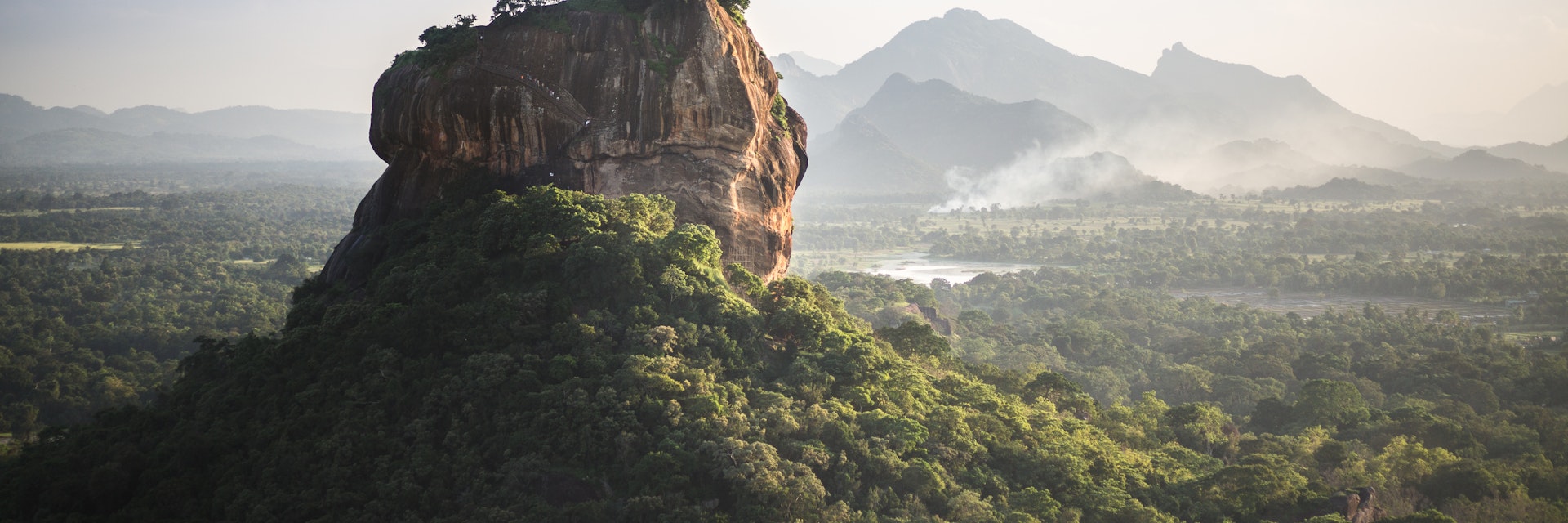
©SylvainB/Shutterstock
Rising dramatically from the central plains, the enigmatic rocky outcrop of Sigiriya is perhaps Sri Lanka's single most dramatic sight. A set of near-vertical staircases climb past some remarkable frescoes to a flat-topped summit that contains the ruins of an ancient civilisation. The spellbinding vistas over the surrounding landscape only add to Sigiriya's extraordinary appeal.
Get In Touch
https://www.ccf.gov.lk/sigiriya.htm
Lonely Planet's must-see attractions
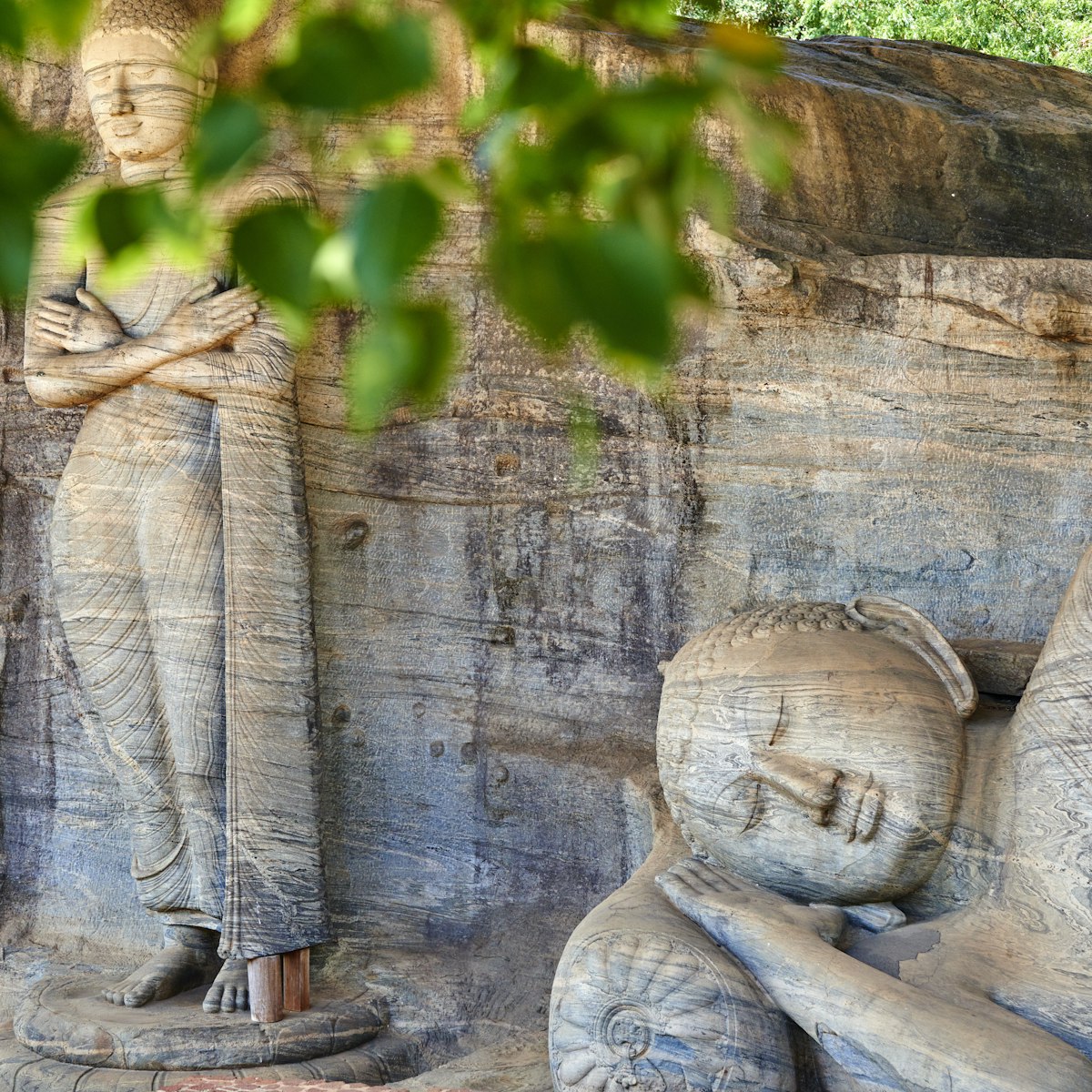
Part of Parakramabahu I’s northern monastery, Gal Vihara is a group of beautiful Buddha images that probably marks the high point of Sinhalese rock…
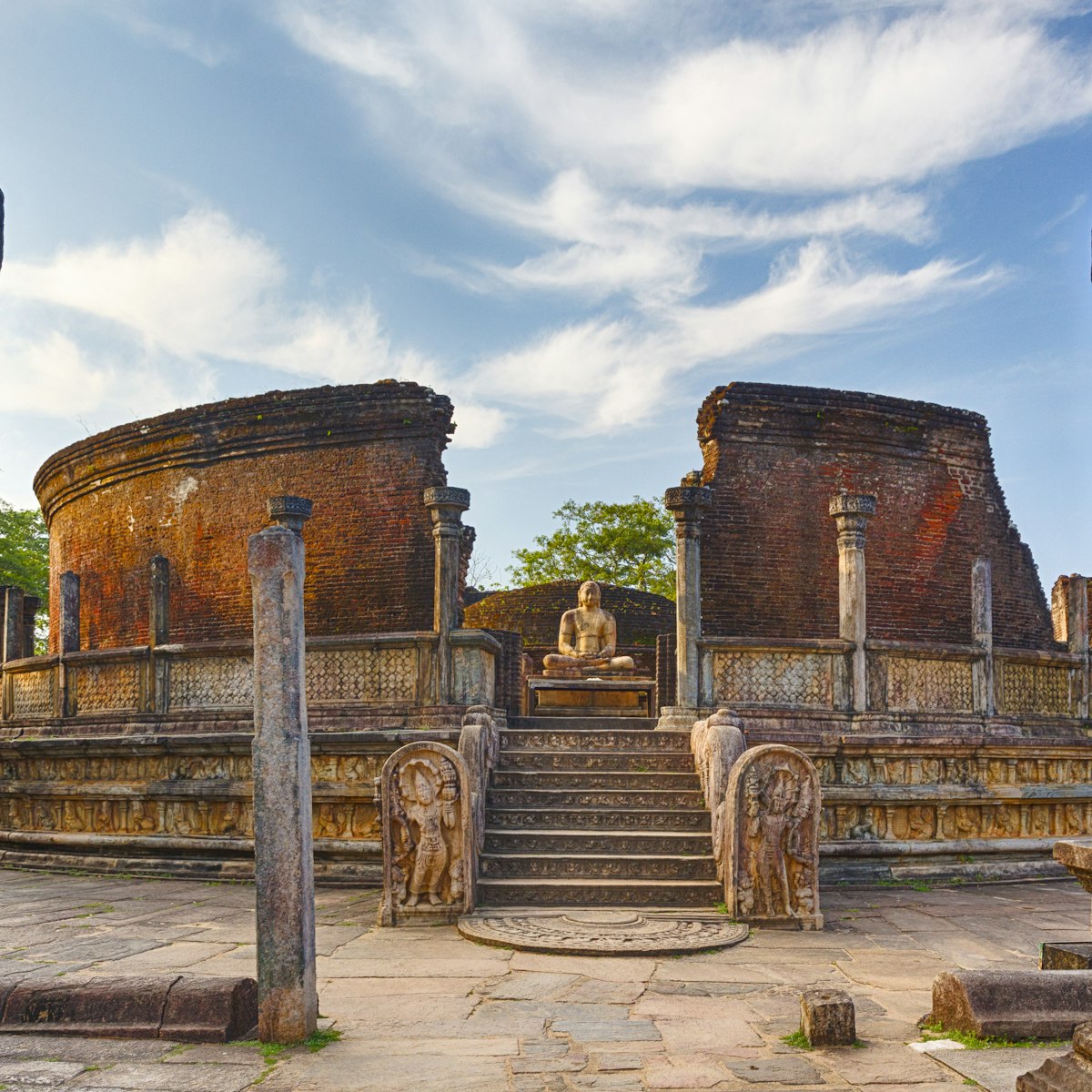
16.59 MILES
A short stroll north of the Royal Palace ruins, the area known as the Quadrangle is literally that – a compact group of ruins in a raised-up area bounded…
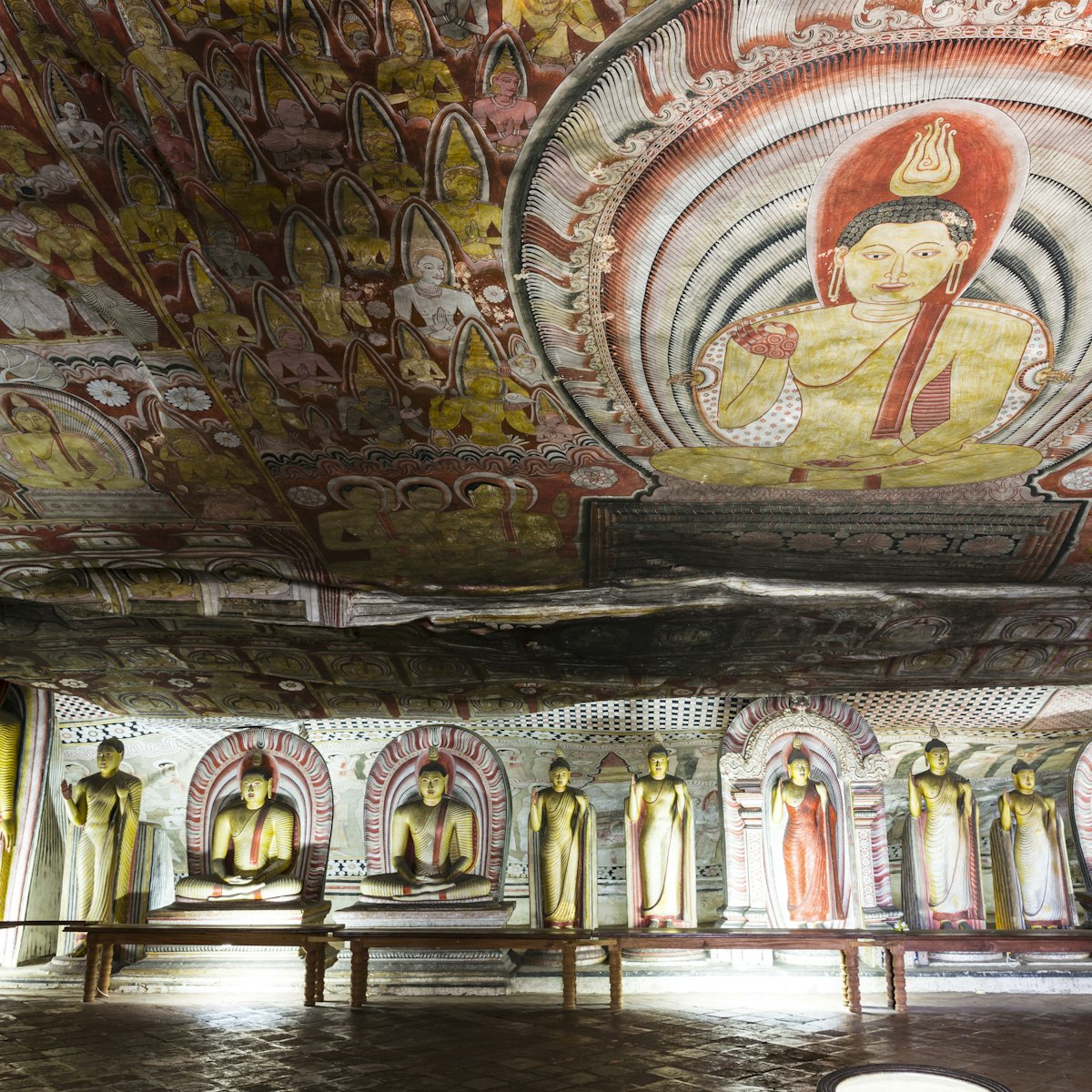
Cave Temples
10.27 MILES
The beautiful Royal Rock Temple complex sits about 160m above the road in the southern part of Dambulla. Five separate caves contain about 150 absolutely…
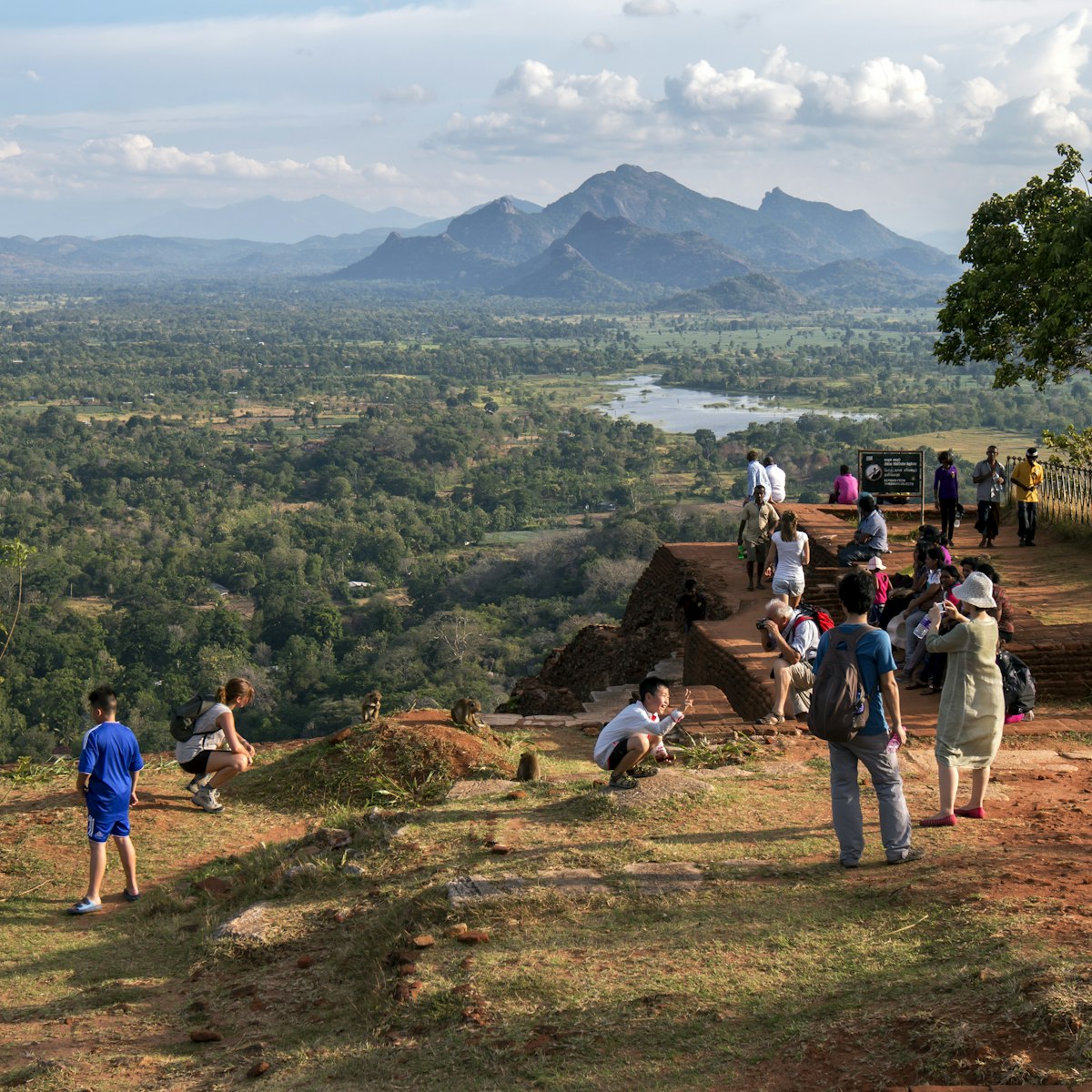
The spectacular terraced summit of the rock covers 1.6 hectares. This is thought to be the site chosen by King Kasyapa for his fortified capital after he…
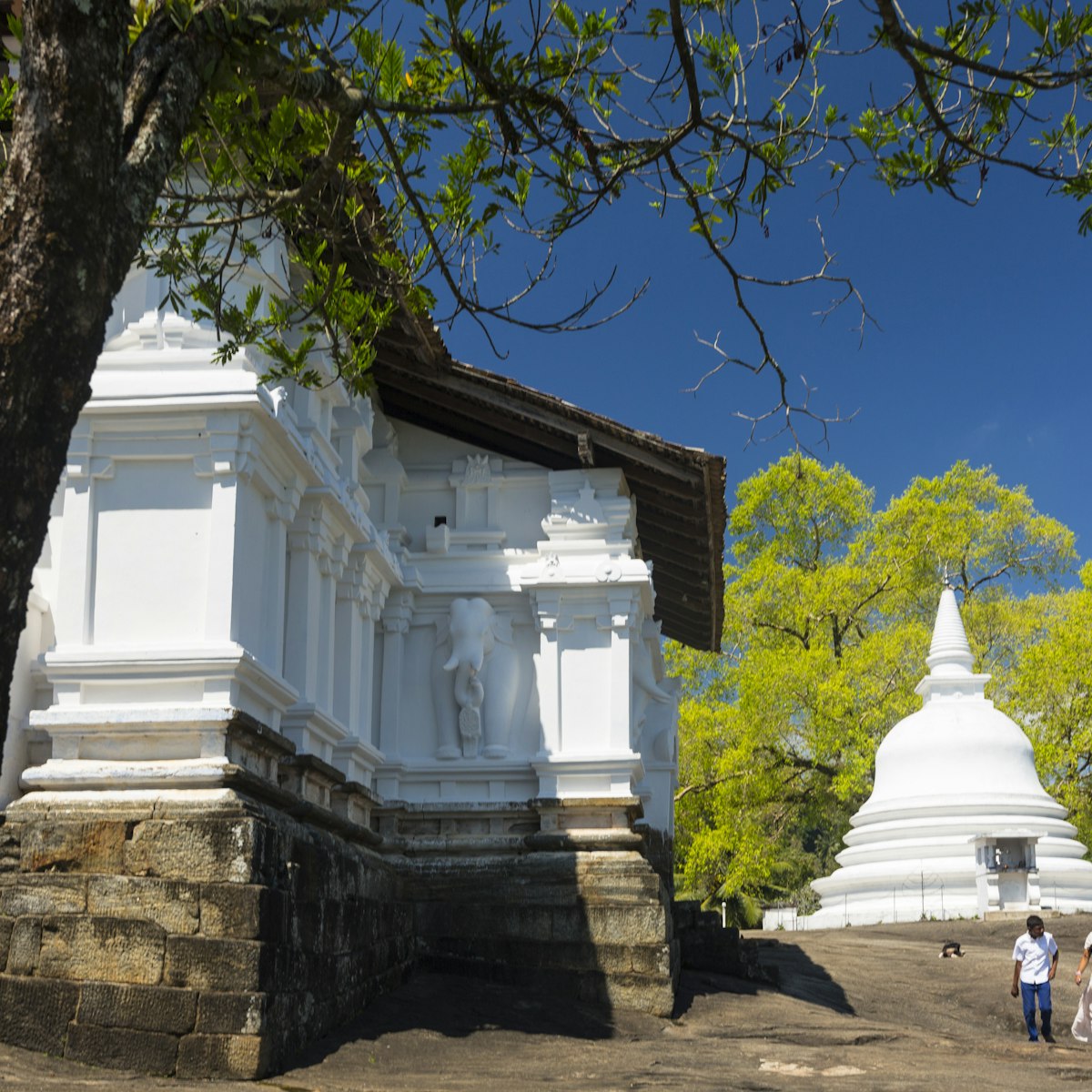
Lankatilaka
16.72 MILES
One of the most evocative structures in Polonnaruwa, the Lankatilaka temple was built by Parakramabahu I and later restored by Vijayabahu IV. This massive…

Halfway up the Sigiriya rock an open-air spiral stairway leads to a long, sheltered gallery in the sheer rock face. The paintings of the buxom, wasp…

Rankot Vihara
16.68 MILES
The 54m Rankot Vihara dagoba, the largest in Polonnaruwa and the fourth largest on the island, has been ascribed to the reign of King Nissanka Malla. Like…

Pidurangula
This prominent rock about 1km north of the Sigiriya site, offers amazing views of Sigiriya from its wide summit. It's a 20-minute hike up to the top, past…
Nearby Sigiriya attractions
2 . Frescoes
3 . Cobra Hood Cave
This rocky projection down in the Boulder Garden earned its name because the overhang resembles a fully opened cobra’s hood. The plastered interior of the…
4 . Mirror Wall
Beyond the Sigiriya frescoes, the path clings to the sheer side of the rock and is protected on the outside by a 3m-high wall. This wall (not the actual…
5 . Lion’s Paws
At the northern end of the rock, a narrow pathway emerges on to the large platform from which the site derives its name – Sigiriya (from sinha-giri) means…
6 . Boulder Gardens
At the base of the Sgiriya rock and most easily seen after a visit to the summit, this collection of natural boulders once formed the bases of monastery…
7 . Royal Gardens
The base of the Sigiriya rock is a beautifully landscaped area dotted with formal water features, terraced gardens and natural boulders that were once…
8 . Main Exit
Most people end up here after their visit to the Sigiriya rock.
Premium Content

- HISTORY MAGAZINE
The 'Lion Fortress' of Sri Lanka was swallowed by the jungle
Built in the fifth century, Sri Lanka’s Sigiriya fortress attracted the attention of British archaeologists in the 1800s, who were amazed by its leonine rock art and beautiful frescoes.
Perched on a slab of rock that juts dramatically over the forests of central Sri Lanka , Sigiriya is as imposing a sight now as it must have been when it was first built by a fierce king in the fifth century A.D. Meaning “lion’s rock,” Sigiriya (designated a UNESCO World Heritage site in 1982) is accessed by way of passageways cut into the rock face between a monumental pair of lion paws.
The fortress was later swallowed by the forest, and only familiar to local villagers. Outsiders used knowledge of its past, preserved in Buddhist texts, to search for the ancient site. British historians rediscovered its astonishing buildings and frescoes in the 19th century.
Kingdom to colony
Sigiriya was built by the fifth-century king Kashyapa I, who ruled the native Sinhalese dynasty, the Moriya. The imposing fortress was the capital of the Sinhalese kingdom until Kashyapa was defeated in A.D. 495. (Watch: An ancient palatial fortress overlooks this barren desert in Israel .)
After Kashyapa, dynasties rose and fell, their fortunes shaped by internal power struggles and conflicts between native Sinhalese and outside invaders from India .
The Lion People

The Mahavamsa, a fifth-century Sri Lankan epic, tells how the Indian prince Vijaya was the grandson of a lion. He traveled to the island of Sri Lanka and married Princess Kuveni. From their union was born the Sinhalese race ( sinhala means “of lions”). In the Sinhalese tradition, the lion is the mythical ancestor of kings and a symbol of royal authority. The photograph shows what remains of the monumental Lion Paws Gate at Sigiriya.
Various cities held the status of capital after Sigiriya, such as Polonnaruwa. By the 12th century, however, overall control of Sri Lanka progressively weakened. Sinhalese power retreated to the southwest of the island, abandoning the Rajarata region, and the former administrative centers, including Sigiriya, started to fall into disuse.
Sri Lanka’s position in the Indian Ocean made it vulnerable to Europeans looking to expand their control in the region. By the mid-1500s the Portuguese had thoroughly exploited dynastic tensions in Sri Lanka’s ruling elite and controlled much of the island.
A century later the Dutch had replaced the Portuguese as colonial masters, and they were in turn displaced by the British in the late 1700s. By 1815 the Kingdom of Kandy, the last independent, native state on the island, became part of the British Empire.

Knowledge is power
British imperial rule brought civil servant George Turnour to the island. An aristocrat, scholar, and passionate historian, Turnour worked with a Buddhist monk to translate an ancient fifth-century chronicle, the Mahavamsa, from the Sri Lankan Pali language into English. Based on this and other texts, he identified two ancient capitals: Anuradhapura and Polonnaruwa.
Turnour also studied a later chronicle of Sri Lankan history, the Culavamsa, which told the story of King Kashyapa. In the late fifth century, this Sinhalese prince killed his father, King Dhatusena, and seized the throne, usurping his brother, who fled to India. Fearing reprisals, he built the fortress Sigiriya—but in vain: His brother returned, defeating Kashyapa, and Sigiriya lost its brief status as capital.

In 1827 a Scottish officer, Jonathan Forbes, became friends with Turnour, and on hearing the story of Kashyapa and his palace, decided to look for it. In 1831 he set off to where locals told him he would find the remains of an ancient city.
His memoir, Eleven Years in Ceylon, describes “the rock of Sirigi [sic], . . . frowning defiance over the scanty fields and the far-extending forest of the surrounding plain.” As he approached, he could see platforms and galleries carved into the rock. Two of his party managed to scramble some way up but dislodged rocks, “which crashed among the boughs of the trees at a great depth below.”
Unsure as to whether he had found the Sigiriya mentioned in the Buddhist texts, Forbes abandoned the expedition. Revisiting a few years later, he traced the moat that surrounds the gardens at the foot of the rock but did not attempt to climb the cliff face. He doubted that the name Sigiriya was related to lions, as he had seen nothing to support that etymology.
Fabulous frescoes
British mountaineers eventually reached the top in 1851, but the task of surveying the site fell to the Archaeological Commissioner of Ceylon, Harry C.P. Bell. His survey at the end of the 19th century has formed the basis of all studies since.

Bell painstakingly ascertained the layout of Kashyapa’s fantastical city as well as detailed the magnificent carving of the lion’s paws at the entrance, which Forbes had not been able to see.

In addition to the elaborate water gardens at the foot of the rock, Bell’s survey also lavished attention on the galleries on the rock face. These are decorated with exquisite wall paintings that have become some of the most prized objects in Sri Lanka’s artistic heritage. A total of 21 surviving frescoes may depict apsaras, celestial singers and dancers. (See also: 40,000-year-old cave art may be world's oldest animal drawing .)
Nearby, also on the walls of the rock face, are well over 1,000 items of graffiti, scratched by monks and pilgrims who visited the site in the eighth to the 13th centuries. These messages from the past can cause a frisson when read by visitors today. One reads: “At Sigiriya, of abundant splendor, situated on the island of [Sri Lanka] we saw, in happy mood, the rock that captivates the mind of all people who come here.”
For Hungry Minds
Related topics.
- ARCHAEOLOGY
- PETROGLYPHS
- WORLD HERITAGE SITES
You May Also Like

See these 6 architectural wonders before they disappear

20 of the coolest travel adventures for 2024

The origins of this naked chalk drawing in England are still a mystery

Everything we thought we knew about the ancient Maya is being upended

Strange clues in a Maya temple reveal a fiery political drama
- Environment
History & Culture
- History & Culture
- History Magazine
- Mind, Body, Wonder
- Coronavirus Coverage
- Paid Content
- Terms of Use
- Privacy Policy
- Your US State Privacy Rights
- Children's Online Privacy Policy
- Interest-Based Ads
- About Nielsen Measurement
- Do Not Sell or Share My Personal Information
- Nat Geo Home
- Attend a Live Event
- Book a Trip
- Inspire Your Kids
- Shop Nat Geo
- Visit the D.C. Museum
- Learn About Our Impact
- Support Our Mission
- Advertise With Us
- Customer Service
- Renew Subscription
- Manage Your Subscription
- Work at Nat Geo
- Sign Up for Our Newsletters
- Contribute to Protect the Planet
Copyright © 1996-2015 National Geographic Society Copyright © 2015-2024 National Geographic Partners, LLC. All rights reserved

Stories by Soumya
The Travel Blog of a Culture Addict
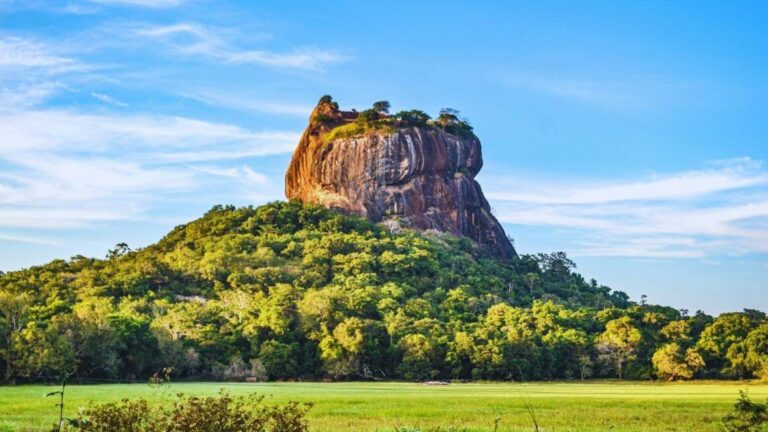
Sigiriya Rock Fortress Sri Lanka – The Best Travel Guide
Last Updated on January 10, 2023 by Soumya
Are you planning a trip to Sigiriya rock fortress in Sri Lanka? Wondering what to do in Sigiriya when you get there? Need to brush up on some Sigiriya history before planning your trip? Don’t worry. We have got you covered.
The rock fortress at Sigiriya has always been a dream destination for me. It is one of Sri Lanka’s most visited UNESCO World Heritage Sites and an integral park of the Sri Lankan Cultural Triangle . Needless to say, Sigiriya is an important part of every Sri Lankan itinerary. Whether you are visiting for 10 days or just 2, you have to see the mighty Sigiriya rock.
I have been to Sigiriya twice and experienced several amazing things on every visit. I have climbed the Lion’s Rock , done a Sigiriya viewpoint tour, gotten smitten by the frescoes, and clicked pictures at the famous lion paws. The Sigiriya rock fortress has surprised and inspired me every time I have been here.
Here’s an ultimate travel guide for Sigiriya Sri Lanka that includes the best things to do in and around Sigiriya, history, where to stay, and lots of tips from my personal experiences of traveling here.
Table of Contents
Quick tips for visiting Sigiriya rock fortress
Alert: This guide to Sigiriya rock fortress is going to be a long one. You know how I love getting into the depths of every historical site in the world! If you are looking for some quick tips before planning your Sigiriya visit, have a look at the list below.

- Things to do: There are tons of interesting things to do in Sigiriya including (but not limited to) visiting the ruins of the royal palace on the top, gazing dumbstruck at the gigantic lion’s paws, and appreciating the beauty of Sigiriya frescoes. Check out the best Sigiriya attractions here.
- The climb: Sigiriya rock has more than 1200 steps to get to the top. Planning for the climb can be a little overwhelming for anyone. That’s why, I created this “ Ultimate Guide to Climbing Sigiriya Rock ” which has got everything you need to plan your memorable Sigiriya climb.
- Guided tours: Here’s a Viator guided tour that takes you to Sigiriya and through a relaxing jeep safari in Minneriya National Park. Pick up is usually from Sigiriya or Habarana. For more options, look here .
- Accommodation: I highly recommend staying at Habarana Village by Cinnamon , a scenic 4-star property located by the lake. They have sustainable, cottage rooms and offer a lavish breakfast with both Sri Lankan and international choices every morning. And their pool is totally mind-blowing. For more accommodation options, have a look here .
Please note: This post may contain affiliate links which means I may earn a commission if you make a purchase by clicking a link on this post. This will be at no additional cost to you. Affiliate links help me keep this website up and running. Thanks for your support!
History of the rock fortress of Sigiriya
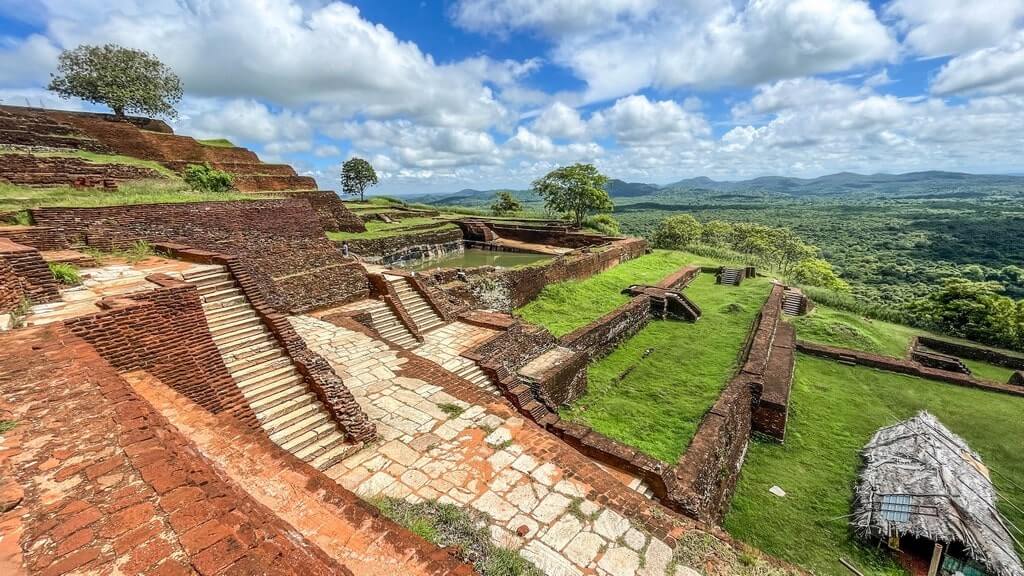
The history of Sigiriya rock fortress goes something like this. King Dhatusena, from the Moriyan Dynasty, had two sons – Moggallana I (legitimate heir) and Kashyapa I (illegitimate). Both of them had royal ambitions.
In 473 AD, Kashyapa I (locally Kassapa I) rebelled against his father, imprisoned him, and took charge of the throne. Eventually, he killed his father by burying him alive. His half-brother, Moggallana I fled to India. Kashyapa became the second king of Moriyan Empire and ruled from 473 – 495 AD. As you can guess, he was not a popular ruler. People often referred to him as Pitrughataka Kashyapa which meant “Kashyapa who killed his father”.
Kashyapa shifted his capital from Anuradhapura to Sigiriya amidst the fear of a rebellion. He chose this 600 feet, rocky outcrop in the middle of Sri Lankan jungles to construct his safe haven. He ruled from there for 18 long years, between 477 – 495 AD. And, that is how the Rock Fortress of Sigiriya came into being.
Prince Moggallana came back from hiding in 495 AD and defeated Kashyapa. The use of Sigiriya as a royal fortress ended in 495. Moggallana donated the rock to the Sangha (Sri Lanka’s Buddhist monastic order). It went back to being a Buddhist monastery for several years after that. Between the 6th and 14th centuries, many devotees, monks, and local people visited Sigiriya. Graffitti on the Wall of Mirrors stands testimony to the fact.
There is archaeological evidence to suggest that King Kashyapa I and his retinue were not the first inhabitants of Sigiriya. People, very often monks, lived in the caves and niches of Sigiriya rock, starting 3rd century BC.
The monumental rock was finally abandoned in the 14th century and was overrun by forests. Swallowed by the deep jungles of Sri Lanka, the Kingdom of Sigiriya was lost to the world for several centuries, only to be rediscovered by British archaeologists in the 19th century.
Sigiriya – An architectural masterpiece
Constructing an entire fortress on a massive rock column would not have been an easy task, especially in the 5th century. Add to it an interesting array of gardens, several layers of moats, walls covered with frescoes, galleries, staircases, and a rock face that looked like a lion’s – you are probably looking at one of the greatest creations in human history.
The ancient city of Sigiriya was declared a UNESCO World Heritage Site in 1982 for its mighty contribution to the world of urban planning.

Sigiriya and Ravana – Truth or Myth?
There’s a legend that says Sigiriya was home to Ravana, the prime antagonist of Ramayana, a Hindu epic. This was more than 5000 years ago. There are theories that suggest that Ravana and his court used a wooden elevator to go up and down the rock.
As fancy as this might sound, there is no empirical evidence to back this theory. However, there is ample scientific research that tells that the rock fortress of Sigiriya was a 5th-century creation. Unfortunately, the connection between Ravana and Sigiriya still remains a mere speculation.
Interesting facts about Sigiriya rock
Sigiriya rock has always been a source of intrigue and conjecture as is always the case with lost historical sites. Take the case of the Lost City of Teotihuacan or the Ancient Mayan Pyramid of Chichen Itza – each has interesting facts associated with itself. Needless to say, there are some intriguing facts about Sigiriya rock that you need to know before you visit.
- In the olden days, you had to enter a massive lion’s mouth to get to the royal quarters in Sigiriya. Don’t worry, it wasn’t a real lion but a huge brick lion structure that formed the northern face of Sigiriya. Even though much of it has been destroyed now, the paws of the lion still remain. This is the reason why Sigiriya is often referred to Lion’s Rock or Sinhagiri.
- Behind its powerful façade, Sigiriya hides a history that is stained by murder and betrayal. King Kashyapa of the Moriyan dynasty constructed the rock fortress as a sanctuary for himself after he had killed his father and usurped the throne from his half-brother. Read more in the history section here .
- Sigiriya rock was used as a Buddhist monastery before the reign of Kashyapa. It continued to be used for similar purposes after Moggallana defeated Kashyapa and moved the capital back to Anuradhapura.
- The royal citadel of Sigiriya stands on the top an enormous rock column that juts out 600 feet above the jungles of Central Sri Lanka.
- You need to climb more than 1200 steps to get to the top of Sigiriya rock fortress .
Things to do in Sigiriya
Visit the museum.
As soon as you enter the Sigiriya complex through the western gate, you will see a museum on your right. This is the Sigiriya Museum, a 2-storey building that you can access before entering the Sigiriya rock entrance gate.
I strongly recommend that you drop into the museum because it is really good despite having a rather plain exterior. The gallery contains really interesting displays that take you through the history of Sigiriya right from the prehistoric times to its restoration. You will get a good view of the fresco gallery too.
Dropping by will help you understand the ancient city of Sigiriya much better and appreciate various spots during the climb.
Walk through water and boulder gardens

As you enter the gates of Sigiriya rock fortress, you will notice a huge swathe of green gardens between you and the rock fortress.
Look around to see the beauty of the green spaces that surround you. There are miniature water gardens filled with pavilions, bathing pools, courtyards, and water courses. You will also see fountains which once used to work through the twin principles of gravity and pressure. Apparently, they still do but the moat needs to be quite full for it to happen.
Do not miss the octagonal pond at the end of the lane which is yet another impressive sight.
Check out Sigiriya’s caves and boulder gardens
Closer to the rock, you will see caves and boulder gardens that further add to the beauty and eccentricity of Sigiriya. You will see caves, boulder arches, and several rocks with drip-ledges to allow the passing of water.
Many of these caves were used by the monks that inhabited the complex before and after Kashyapa’s reign. You will see inscriptions in some and faint remnants of colorful frescoes in others. The Cobra Hood Cave and the King’s Audience Hall Rock are especially striking.
Be sure to notice small niches on outmarks on each of these boulders which are believed to have held other rocks/wooden platforms in position. It is quite possible that these boulders had other buildings on pavilions set up over them.
The boulder gardens almost feel like a transition from the water gardens to the bouldered-surface of Sigiriya rock.
Explore Sigiriya’s terraced gardens
Next up are the terraced gardens which once housed several wild and domesticated trees. Even though there isn’t much to see here, I would suggest enjoy your walk through this forested area until you get to the Lion’s Paw.
Get wowed by the Lion’s Paw
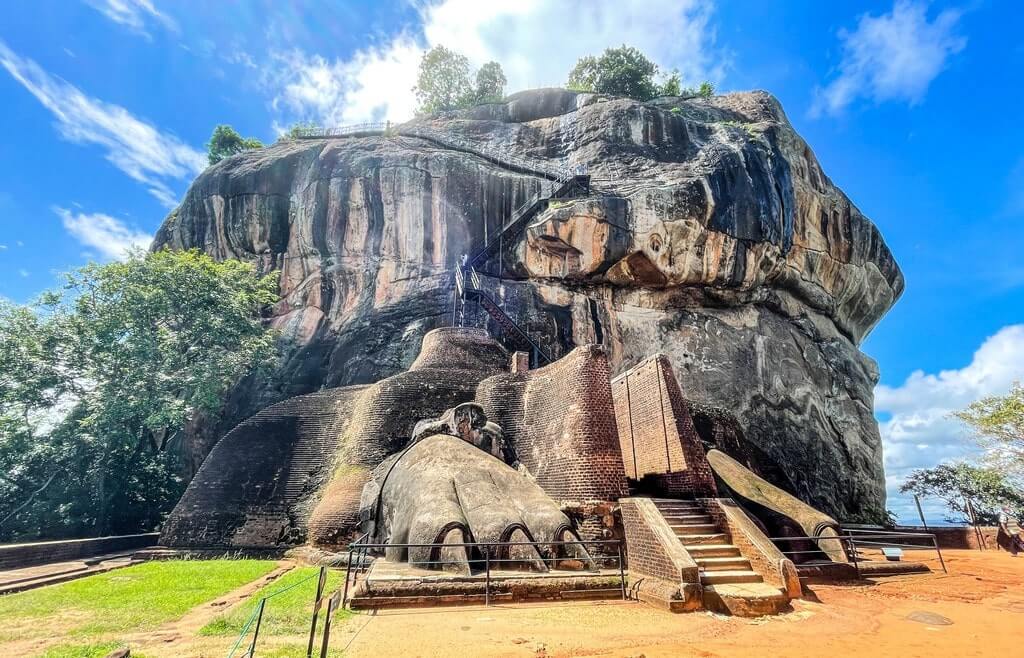
After climbing a steep flight of stairs from the terraced gardens in Sigiriya, you will get to the iconic Lion’s Paw. Remember the enormous lion sculpture that I spoke to you about? That begins here.
Located right before the summit, the Lion’s Paw is one of the most photographed locations in Sigiriya. It is believed that a full-fledged brick lion once sat crouching at this spot. You had to walk right up to the paws, climb the stairs into the lion’s mouth, and then begin your ascent into the Sigiriya citadel. The lion was colossal and could be seen from far away.
Visualize a huge lion staring out of a mountain – that’s how Sigiriya rock appeared to people centuries ago. Clearly, the rock was called Sinhagiri or the Lion’s Rock.
You can still climb the stairs but nothing other than the beast’s paws remain today though they are mighty impressive too!
Explore the ruins of a lost kingdom on the top
Once done with the Lion’s Paws, head straight up to the ruins on the top of the rock. The stairs to get to the top are numerous but not very steep.
On the top, you will find the ruins of the lost palace of King Kashyapa I. There are the remains of an Upper Palace, a large pond which was probably used for bathing purposes, a stone seat dubbed as the throne, and several living quarters. The place almost mirrors the ruins of Machu Picchu in Peru, albeit on a much smaller scale.
One thing that I did not quite enjoy up here was the general lack of information panels about the royal quarters. That made it literally impossible to understand what was what. Helps to get a guide up here who can explain.
From the top, you will also get stunning views of the Sri Lankan jungles as well as a bird’s eye view of Sigiriya’s gardens and the walkway. You will also find a plaque that describes the gardens as one of the oldest surviving ones in Asia.
Plan to spend at least 30 minutes on the top of the Sigiriya rock fortress.
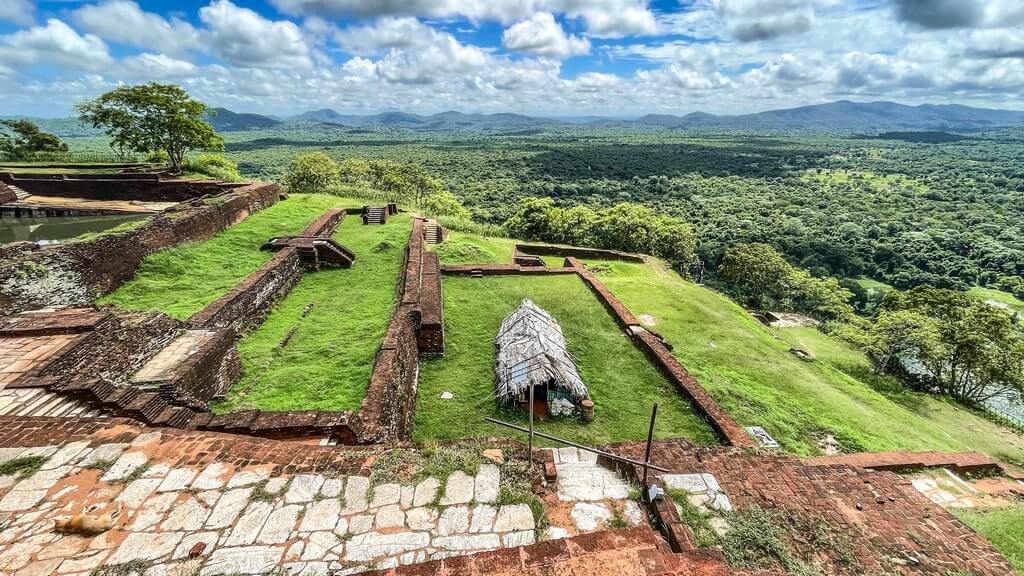
Check out the Mirror Wall
Next up on the Sigiriya bucket list is the Mirror Wall which once used to be polished and shiny. It was almost like a mirror where the king could check out his reflection and appreciate himself.
It is hard to say what material the wall was made of because nothing remains of the original wall today. Instead, we now have a wall covered with graffiti not from recent times but from the 6th – 12th centuries.
Remember when I told you that after Moggallana donated Sigiriya rock to the Sangha, monks and devotees thronged the place? They left their mark on the place by writing on the mirror wall which eventually came to be called the Sigiri graffiti. People usually wrote about the beauty of the damsels in the Fresco Gallery which is right next door.
Today, the wall has become an important piece in the research of medieval Sinhala language, phonetics, and literature.
Appreciate the damsels at the Gallery of Frescoes
After crossing the Mirror Wall, climb the spiral stairs that take you up to the Frescoes Gallery.
Here you will find paintings of the beautiful Sigiriya maidens that have been much talked about around the world. Almost 500 paintings once adorned several walls, caves, nooks, and corners of the Sigiriya rock fortress. Only 17 paintings remain today in the Frescoes Gallery.
These frescoes are one of the most valuable pieces of ancient Sri Lankan art. Photography is not allowed in the gallery.
Some say these women were King Kashyapa’s concubines. Others say they represent unearthly spirits called Apsaras or even Goddesses. It is hard to say for sure because there are no written records about the Sigiriya maidens.
End it with the Sigiriya viewpoint tour
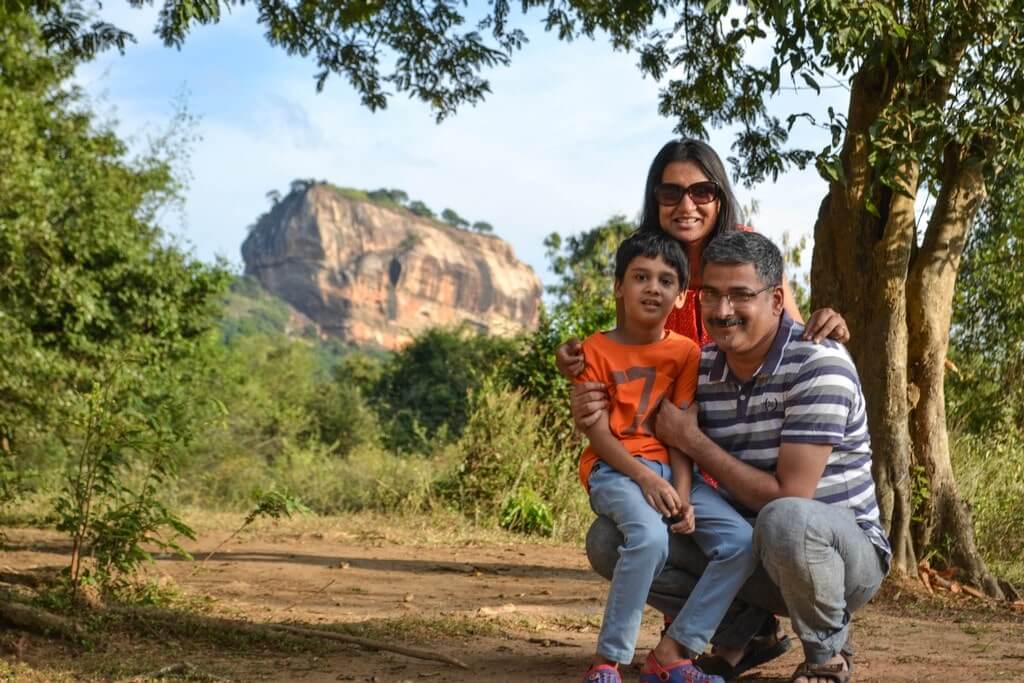
Now this is something unusual that I did when I first visited Sigiriya. I had just finished exploring the Ancient City of Polonnaruwa and reached Sigiriya around 4 pm. I had no energy to climb the fortress.
What I instead did was take a tuk-tuk tour of the 10 best views of Sigiriya.
At the entrance to Sigiriya, you will find tuk-tuk drivers ready to take you on the tour. They charge something around LKR 2500 – 3000 ($12-15). There is a big poster right at the gate showing you the 10 best viewpoints of Sigiriya.
The driver will take you to these points and will also click your pictures if you want him to. Some of these points are quite inaccessible but are well worth it. Always good to have a local with you.
Things to do after visiting Sigiriya rock fortress
Visiting Sigiriya usually takes half-a-day of your time. Once done, you can spend the second half of your day relaxing one of the amazing hotels near Sigiriya or make a short trip to one the of three locations below.
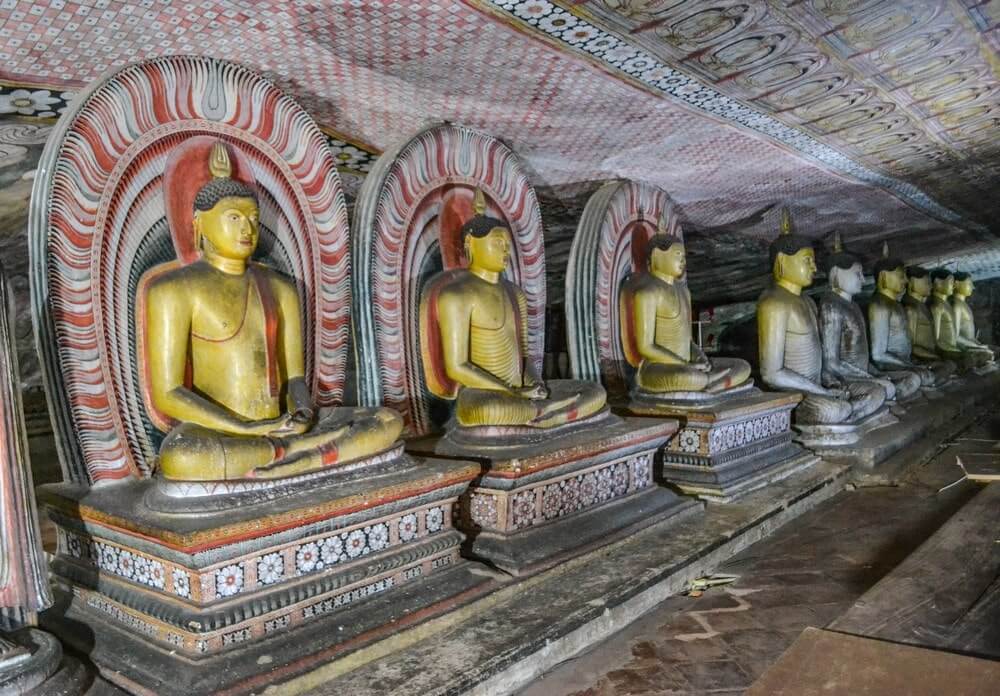
Visit the rock-cut caves of Dambulla
Distance from Sigiriya: 11 miles (18 km) – Takes 30 minutes to get here
The rock-cut cave temples of Dambulla are yet another UNESCO World Heritage Site that totally need to be on your Sri Lankan bucket list.
There are 5 caves in the Dambulla complex of which the first 3 are the most impressive. The 2nd cave, called Cave of the Great Kings, has 56 odd statues of Buddha. The cave is covered with colorful frescoes that depict the life and teachings of Buddha. These frescoes are nearly a 1000 years old.
Also read: Ultimate guide to visiting Dambulla Cave Temple in Sri Lanka
You will need to climb around 350 steps to get to the Dambulla caves. If that sounds a little too hectic after the long Sigiriya climb, pick any one of the options below.
Enjoy an afternoon safari
There are several national parks near Sigiriya where you can enjoy an afternoon safari. Minneriya, Kaudulla, and Hurulu Eco National Park are some of the famous ones. They are all closeby and reachable within 30 – 45 mins from Sigiriya. Kaudulla is probably a little further away.
This area is especially popular for its collection of Asian elephants that you will spot in herds. Sometimes, they number up to hundreds.
I did a safari at Hurulu Eco Park the last time I visited Sri Lanka in November. However, it was raining most of the time and we barely saw any elephants. Just a couple of them here and there. My two cents – don’t do a safari in the rainy season.
Head to Pink Quartz Mountain
A lesser-known but interesting place to visit near Sigiriya is the Pink Quartz Mountain. Locally referred to as Jathika Namal Uyana, this place is an absolute delight for nature lovers and naturalists.
Here, you will find Sri Lanka’s largest ironwood forest (a species unique to this region) and pink quartz hills. Apart from that, Namal Uyana also has a historical significance because it was once a sanctuary for Buddhist monks.
Practical information for visiting Sigiriya rock fortress
Sigiriya rock opening hours.
The rock fortress at Sigiriya is open between 7 am to 5:30 pm. The ticket office closes at 5 pm.
Sigiriya ticket price
Tickets to Sigiriya are on the higher side, especially for foreigners. They are priced at $30 (6090 LKR) for foreigners. This includes Lions Rock and Sigiriya Museum. Children, 5-12 years of age, need to pay half, $15.
In case you wish to do only the museum, you can buy a ticket at $5.
Good news for citizens of SAARC countries – you need to pay only half of the ticket price. That means Sigiriya ticket for adults is $15 and for children is $7.5.
Please note that the ticket office does not accept cards. They only do cash, either in LKR (Lankan Rupees) or USD. LKR is preferred.
Best time to visit Sigiriya rock
The best time to visit Sigiriya is early in the morning. Come here at 7 am, right when the gates open. You will not only avoid the midday heat but also get the entire citadel to yourself. No bobbing heads in your pictures!
Climbing between 3 – 5pm is also great. However, you won’t get a lot of time to explore the citadel because climbing up and down can take up to 1 hour each way. I would prefer morning over late afternoon.
All about climbing the mighty Sigiriya rock
Sigiriya rock fortress in Sri Lanka has more than 1200 steps. I was quite apprehensive if I could do the climb myself given my lack of fitness. However, I completed the climb in less than 1 hour with lots of breaks in between.
The best part about the Sigiriya climb is the fact that it is not one monotonous hike. There are several interesting things to do on the way such as wandering the gardens, checking out boulder arches, ancient caves, the Fresco Gallery, and the Lion’s Paw. I
Recommended guided tours for Sigiriya rock fortress
If you are staying in and around Sigiriya, I recommend you do the rock fortress with a local guide. Ask for a guide at the hotel reception and they will happily arrange for one.
If you are staying either in Colombo or Kandy , I would recommend taking a tour. You will cover more ground and see things that you might otherwise miss. Day trips usually include one more attraction along with Sigiriya. I would be wary if they have more than one because that would be just touch-and-go. I definitely don’t recommend that for Sigiriya.
Here are some highly-rated guided tours of Sigiriya. Note that these tours do not usually cover admission charges.
- On this day tour from Kandy , you will visit both Sigiriya and Dambulla in your own private vehicle.
- This full-day tour from Colombo takes you to two UNESCO World Heritage Sites – Sigiriya Rock Fortress and Dambulla Cave Temples.
- If you are staying in Sigiriya or Habarana, this full-day tour will take you to Sigiriya and Minneriya National Park for a relaxed wildlife safari.
Where to stay in Sigiriya?
There are many wonderful places to stay in both Sigiriya and Habarana , suitable for all budgets. I stayed at Habarana Village by Cinnamon , a beautiful 4-star property featuring bungalow-style rooms, a picturesque swimming overlooking the lake, and a wonderful spread for breakfast. Totally loved my stay here – the food, the hospitality, the ambience – everything here was amazing.
If you are looking for a more affordable stay, try The Otunna Guest House , a sustainable property that is very close to the Sigiriya rock. Also have a look at il Frangipane that has spacious rooms, a beautiful garden, and delicious food.
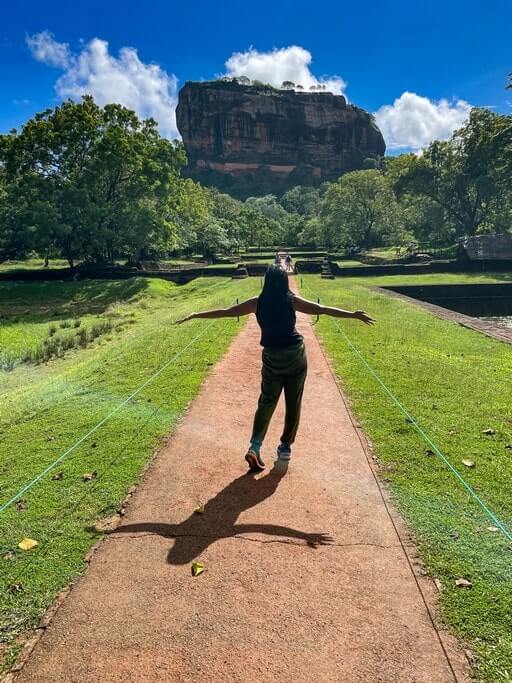
Sigiriya rock fortress FAQ
What is sigiriya famous for.
Sigiriya is UNESCO World Heritage Site in Sri Lanka that is famous for the mighty citadel that King Kashyapa I built on top of it in the 5th century AD. It is also home to the majestic frescoes of Sigiriya maidens as well as a colossal set of Lion’s Paws that once belonged to a crouching lion that adorned the rock’s northern face.
Who built Sigiriya?
King Kashyapa I, from the Moriyan dynasty of Sri Lanka built the Sigiriya Rock Fortress in 477 AD. Even before that (since the 3rd century BC), Sigiriya had been used as Buddhist monastery for centuries.
Why did King Kashyapa build Sigiriya?
King Kashyapa built Sigiriya rock fortress because it was inaccessible and made him feel secure from his brother and the people of his kingdom. Kashyapa had achieved the reign by unlawful means only after killing his father, King Dhatusena and usurping the rightful heir, his half-brother, Moggallana. He was always scared of being thrown over. That’s why he created the Sigiriya high castle from where he ruled for 18 long years.
When was Sigiriya fortress built?
Sigiriya fortress was built in 477 AD by King Kashyapa I of the Moriyan dynasty in Sri Lanka.
Is Sigiriya Ravana’s palace?
No, Sigiriya is not Ravana’s palace. There is no scientific evidence suggesting the presence of Ravana here.
How old is Sigiriya?
The Sigiriya rock, that was formed from a volcanic explosion, is billions of years old. However, earliest records of it being inhabited start showing up around 3rd century BC when it was used as a Buddhist monastery. Later, in 477 AD, King Kashyapa built the Sigiriya rock fortress over it. Therefore, Sigiriya rock is billions of years old, it has been inhabited for 5000 years, and it has been home to Kashyapa’s palace for more than 1500 years.
How tall is Sigiriya?
Sigiriya is 1144 feet (350 m) tall over sea level and 600 feet (180 m) tall over the nearby jungles of Sri Lanka.
How do you climb Sigiriya?
You can climb Sigiriya through a series of 1200 steps that lead all the way from the water gardens at the bottom to the rock citadel at the top. There are several stops in between where you can take a break and appreciate frescoes, architecture, and the scenery. Refer to our exclusive Sigiriya climbing guide for all details.

What are the Sigiriya frescoes?
Sigiriya frescoes are impressive paintings of maidens created more than 1500 years ago. They were drawn using natural colors on the walls of caves in Sigiriya. Apparently, more than 500 maidens once graced the walls of Sigiriya. Many of them were vandalized. Today, only 17 remain in a small niche of the Sigiriya rock.
What can visitors see in Sigiriya?
The best things that visitors can see in Sigiriya are the Sigiriya frescoes, a Mirror Wall with Sigiri graffiti, humongous paws of a brick lion, and the fascinating ruins of an upper palace on the top of the rock. Apart from that, there are also water gardens, boulder gardens, frescoed-caves, pavilions, and a Sigiriya museum to spend time at.
Loved our guide to Sigiriya rock fortress? Pin it for later!
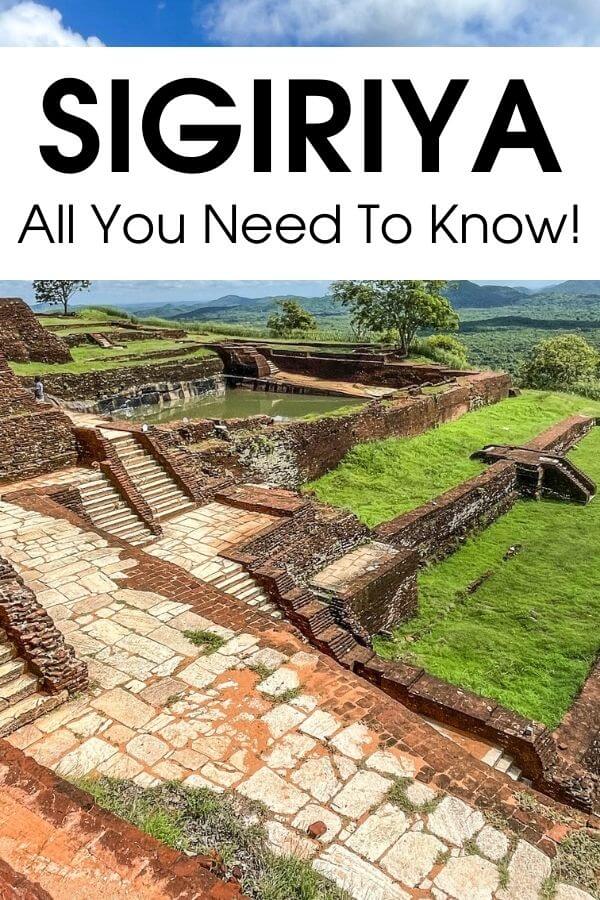
You may also like:
- Climbing Sigiriya Rock In Sri Lanka: Tips From A…
- Dambulla Cave Temple Sri Lanka: The Ultimate Travel Guide
- Exploring The Ancient City Of Polonnaruwa Sri Lanka
2 thoughts on “ Sigiriya Rock Fortress Sri Lanka – The Best Travel Guide ”
Beautifully captured Soumya. Sigriya is one of my best experiences on this trip and I am still overwhelmed with what we saw. Still digesting it all and ruminating over it. Super useful tips and lovely pictures.
Thanks Ami. Yes, Sigiriya was lovely for history lovers like you and me. It will take a lifetime to understand and digest, I believe.
Leave a Reply Cancel reply
Your email address will not be published. Required fields are marked *
Post Comment
This site uses Akismet to reduce spam. Learn how your comment data is processed .
Begin typing your search term above and press enter to search. Press ESC to cancel.
Sigiriya, Eighth Wonder of the World
Sigiriya is one of the most valuable historical monuments of Sri Lanka. Referred by locals as the Eighth Wonder of the World, this ancient palace and fortress complex has significant archaeological importance and attracts thousands of tourists annually. It is probably the most visited tourist destination in Sri Lanka.
The palace is located in the heart of the island between Dambulla and Habarane on a massive rocky plateau 370 meters above sea level. Entrance to Sigiria can only be purchased at the site! See available tours:
Sigiriya rock plateau, formed from the magma of an extinct volcano, is 200 meters higher than the surrounding jungles. Its view astonishes the visitors with the unique harmony between nature and human imagination.
The fortress complex includes remnants of a ruined palace, surrounded by an extensive network of fortifications, vast gardens, ponds, canals, alleys, and fountains.
The surrounding territories of Sigiriya were inhibited for several thousand years. Since the 3rd century BC, the rocky plateau of Sigiriya has served as a monastery. In the second half of the 5th-century king, Kasyapa constructed a royal residence here.
After his death, Sigiriya again became a Buddhist monastery until the 14th century, when it was abandoned.
The main entrance is located on the northern side of the rock. It was designed as a huge stone lion whose feet have survived until today, but the upper parts of the body were destroyed.
Thanks to this lion, the palace was named Sigiriya. The term Sigiriya originates from the word Sihagri, i.e., Lion Rock.
The western wall of Sigiriya was almost entirely covered by frescoes created during the reign of Kasyapa. Eighteen frescoes have survived to this day.
The frescoes depict nude females and are considered to be either portraits of Kadapa’s wives and concubines or priestesses performing religious rituals. Despite the unknown identity of the females depicted in the frescoes, these unique ancient paintings celebrate female beauty and have incredible historical significance.
One of the most striking features of Sigiriya is its Mirror wall. In the old days, it was polished so thoroughly that the king could see his reflection. The Mirror wall is painted with inscriptions and poems written by the visitors of Sigiriya.
The most ancient inscriptions are dated from the 8th century. These inscriptions prove that Sigiriya was a tourist destination over a thousand years ago. Today, painting on the wall is strictly prohibited.
Daily Tours at Sigiriya
Here, you can find available tours to visit Sigiriya.
Sigiriya Photos
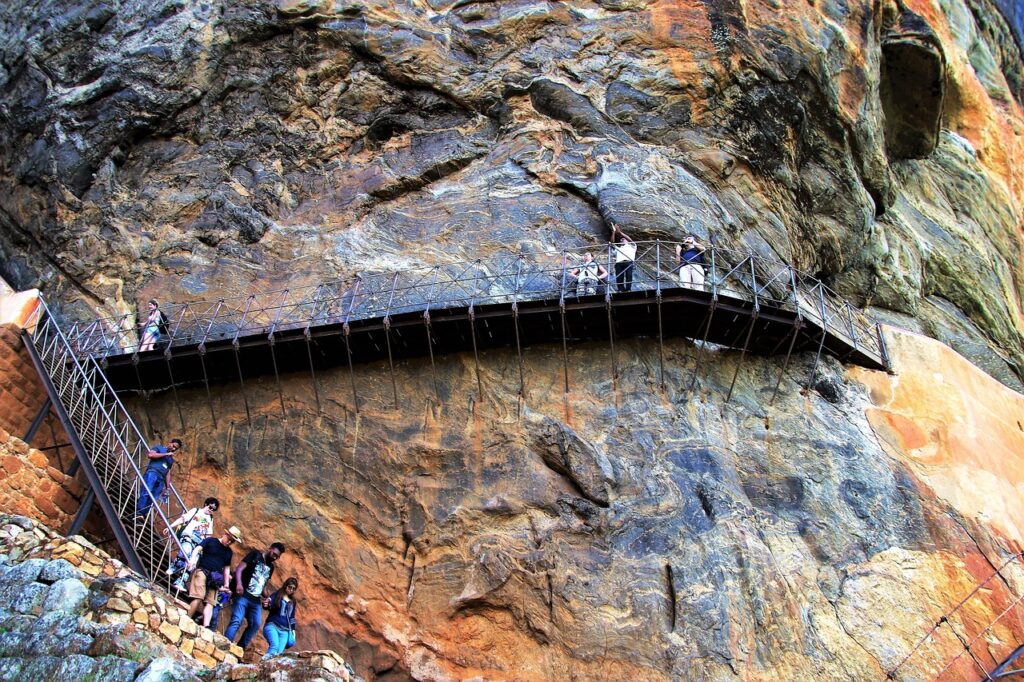
Table of Contents
Complete Guide to Sigiriya in Sri Lanka
A UNESCO World Heritage Site , Sigiriya in Sri Lanka, also known as Lion Rock, is a breathtaking architectural marvel located in the heart of Sri Lanka. This ancient fortress, built in the 5th century CE (AD), sits majestically atop a massive rock formation that rises to about 200 meters above the surrounding jungle.
This was built as the capital city of Anuradhapura, Sri Lanka by the second Moriya King Kasyapa I. The site is considered as one of the most important cultural landmarks in Sri Lanka and probably most the visited tourist attraction by both Sri Lankan and Foreign tourists alike.
Though magnificent, it was built at the end of tragic happenings, about which we will talk in a few minutes. However, if you are a history buff first and then a traveler, please click here for the historical events leading up to the building, of one of the finest examples of urban planning of that period called the rock fortress of Sigiriya in Sri Lanka. So here is our complete guide to Sigiriya based on our experience including the enchanting stories of Kings and Queens!
Click Here for a Get Your Guide: Sigiriya Walking Tour
What to see and what to do at the Rock Fortress complex of Sigiriya in Sri Lanka
Sigiriya city was the capital of Anuradhapura the reign of Kasyapa (also spelt as Kassapa or Kashyapa) for 18 years. After which the Capital returned to Anuradhapura. For the next 800 years it was used by the monks and later completely abandoned. Soon nature took over the whole place. In the early 19 th century, a young Bristish army officer called Jonathan Forbes, while hunting elephants, stumbled upon the ruins of the gardens at the foothill of the Sigiriya hill. The rest, as they say, history was rediscovered and restored. 😊
The remarkable Rock Fortress of Sigiriya in Sri Lanka is filled with a rich history, breathtaking architecture, and stunning art. From exploring the ancient ruins to climbing the seemingly impossible rock to the summit, there’s something for everyone when visiting this magnificent complex.
Here is athe Sigiriya blog, a complete guide to Sigiriya detailing what to see and do while at the Majestic Palace in the sky complex at Sigiriya in Sri Lanka.
First View of the Sigiriya fortress complex at Sigiriya in Sri Lanka
As you approach the main entrance of the Sigiriya Rock Complex, you are greeted by lush green landscapes and the towering rock that stands in the center. You will see a pathway that leads to the base of the rock, surrounded by water gardens and ponds. All these seem to lead your vision to the majestic rock mesa (tabletop or plateau), that seems to magically rise from the ground. There are no other rock outcrops in the vicinity.
Klook: Sigiriya and Polonnaruwa. Click here for more options
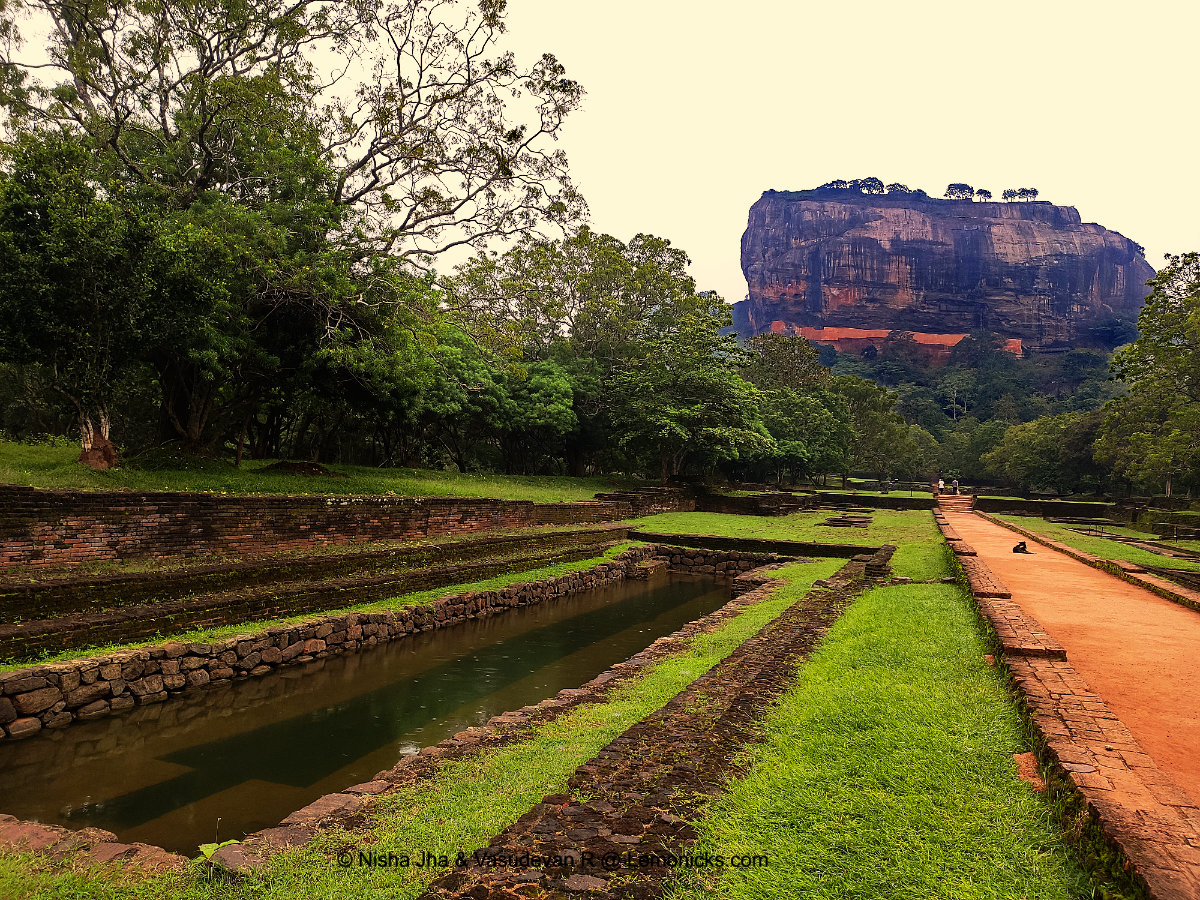
Imagine the whole rock is white in colour, like a cloud. Now imagine there are 100s of paintings and frescos of Apsaras and celestial maidens covering a strip of about 10 – 20 Metres high, encircling the rock at the middle part of the rock. You can see in your mind’s eye, these figures floating around, praying, cavorting and dancing. You are probably already in heaven.
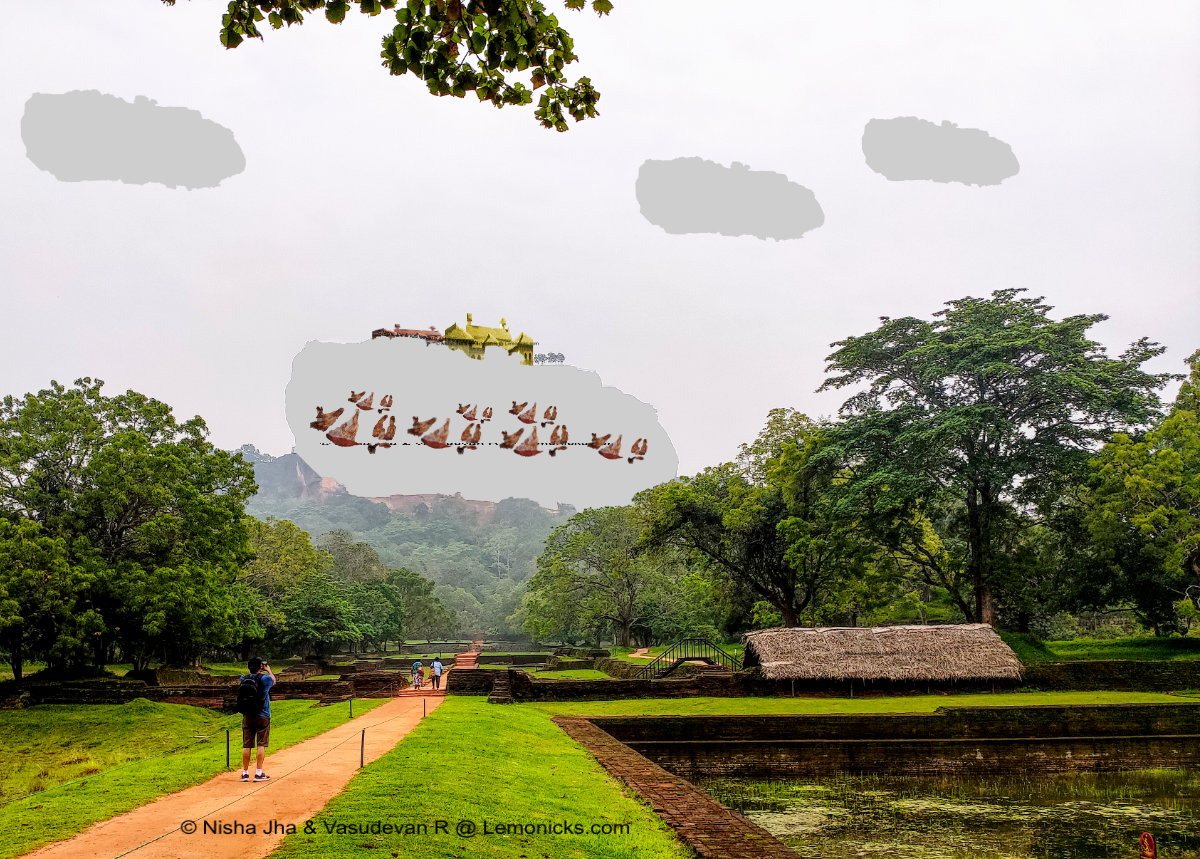
It is believed that King Kasyapa wanted to recreate the city of gods, Alakamandawa, with an ornate golden palace on top of the rock fit for Kubera or Kuvera, the god of wealth. He also wanted this fortress with the sky palace to be a pleasure place to entertain his royal guests and friends and their families.
Visit the Water Gardens, Fountains & Ponds
On either side of the dry-weather pathway leading to the bottom of Sigiriya rock, you will see the water gardens. These gardens are considered some of the most sophisticated in ancient Sri Lanka and are dotted with stone and brick structures and fountains, adding to the serene beauty of the complex. The ponds, pools and fountains are symmetrically laid out on both sides of the central path.

The artificial ponds, fountains and canals were used to create a cool atmosphere in summer. The pressure of water for the fountains was created by gravity. The water itself was fed from the rainwater collected by pools, moats, elaborate underground drains and terracotta conduits right from the top of the summit to the bottom most pool. Wow! Think of a gigantic “Rainwater harvesting” and you have it here.
As per the information board, an artificial serpentine stream was created to regulate the speed and volume of water. The more you see it the more you wonder, how did they achieve it 1500 years ago! There were also supposed to be summer palaces (in ruins now) in the center of the ponds.
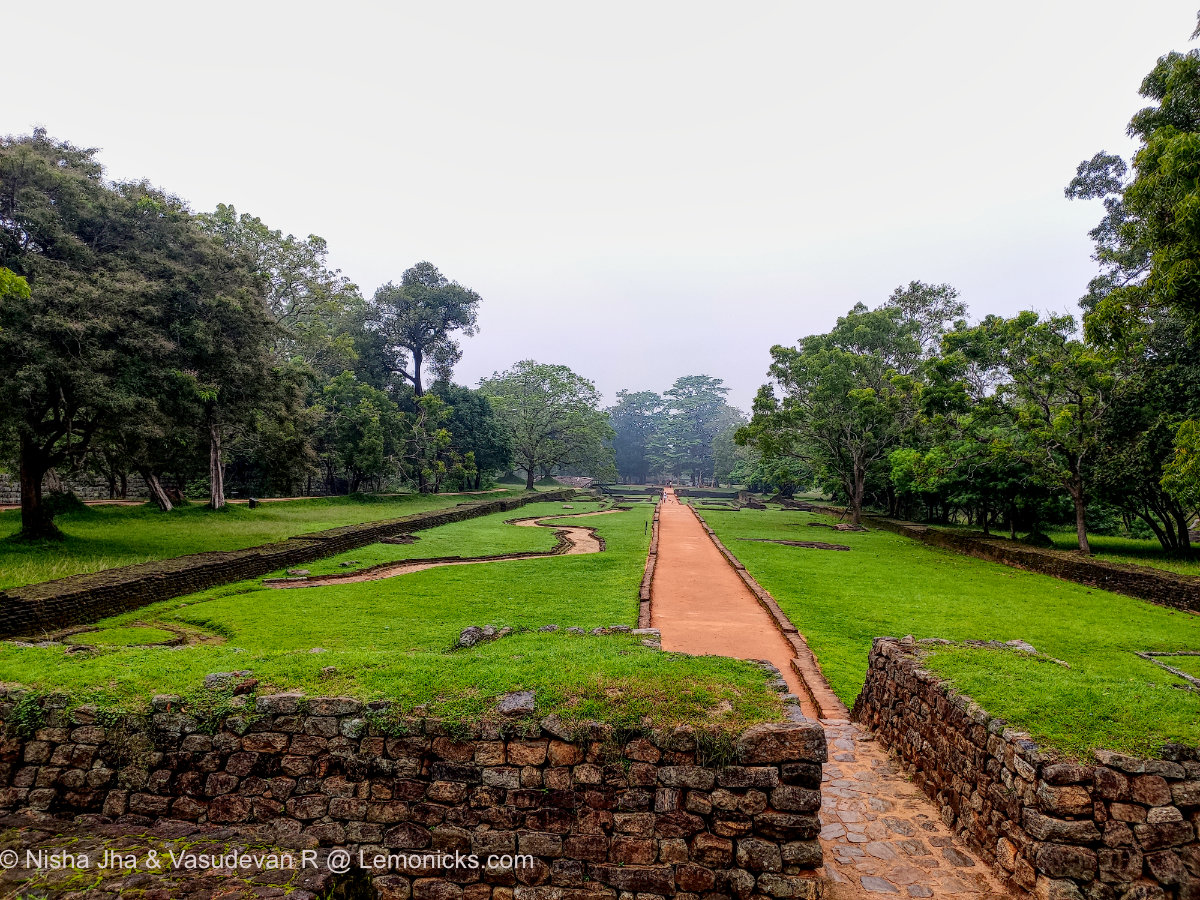
From the main entrance of Sigiriya rock fortress complex to the base of Sigiriya, it is about 1 KM.
Marvel at the Octagonal Pond, Moats, Boulder Garden and Ramparts
At the next higher level, after climbing a few steps, on the left side, is the octagonal pond. For some reason it is not duplicated on the other side. On one side of the octagonal pool is a boulder which carries tell-tale marks of a roof over this place, which the ravages of nature have destroyed.

As you cross the moats and climb on to the rampart, you will come across remnants of the old monastery. It is said that there was a monastery here before the Sigiriya fortress was built and again later when the capital was shifted back to Anuradhapura. While the images are not there in the Image house cave of the monastery, we could still see some paintings and plasters. The info board says that before Sigiriya was made the capital, this was dwelling for the monks and after Sigiriya period this was converted to the image house.
This is also called the boulder garden (boulder rampart) as we can see a lot of boulders strewn interspersed with pathways. This also provides protection against enemy attack as one can defend by rolling the boulders on the oncoming army of the enemy.
There are many caves, some of them still sporting faded old paintings on the walls and ceilings of the caves.
Climbing Sigiriya Rock
The climb to the summit of Sigiriya hill, which is about 180 Metres high, starts after entering an archway formed by two boulders leaning on each other. There are about 1200 steps to the top of the rock from the water garden. A series of galleries and staircases provide access to the summit, where the famed Sigiriya Sky Palace was situated.
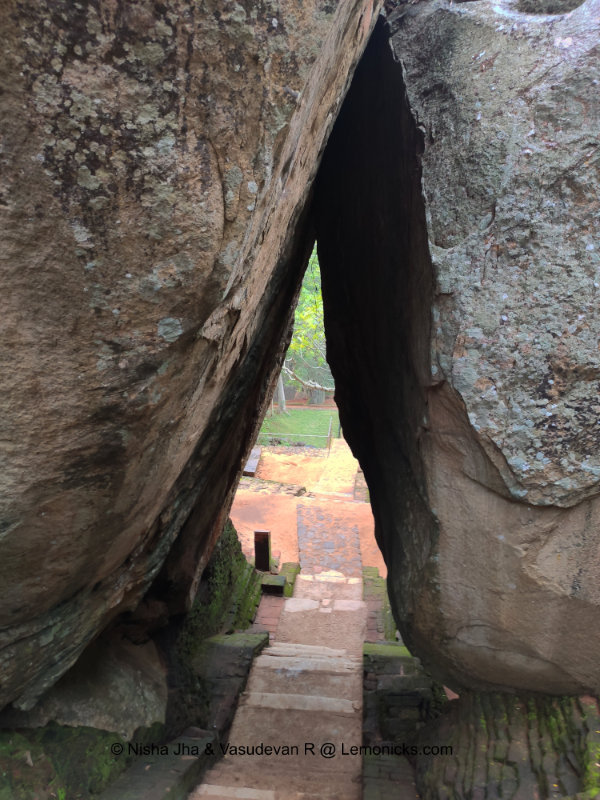
Once you start the climb there are very few places to stop and rest till you reach one of the most significant parts of Sigiriya, the Lion’s Paws Terrace. The climb is moderately difficult but the steps are quite well laid out and once can do this stretch in about 20-25 minutes.
Sigiriya is evolved word from the older Sanskrit word Simhagiri (सिम्हगिरी ) or the tamil word Singagiri (சிங்ககிரி). Simha means lion and giri is mountain. However, till now we had not seen anything that remotely resembles the lion or its features. Neither any paintings nor a sculpture of a lion.
It is said that HCP Bell (Harry Charles Purvis Bell), the archaeologist who first excavated this site, had the same question (!). From 1894 to 1898, they excavated most of what we can see today. The above question still persisted.
The Lion’s Paw Terrace
The only part they had not yet excavated was the last terrace before the final climb. The team had already installed iron ladders from the terrace to the top starting from a mound of what they thought was the debris of some earlier brickwork above. (Maybe a gallery). A mound is the most important starting point of any excavation and so they started digging into it and found some hard brickwork.
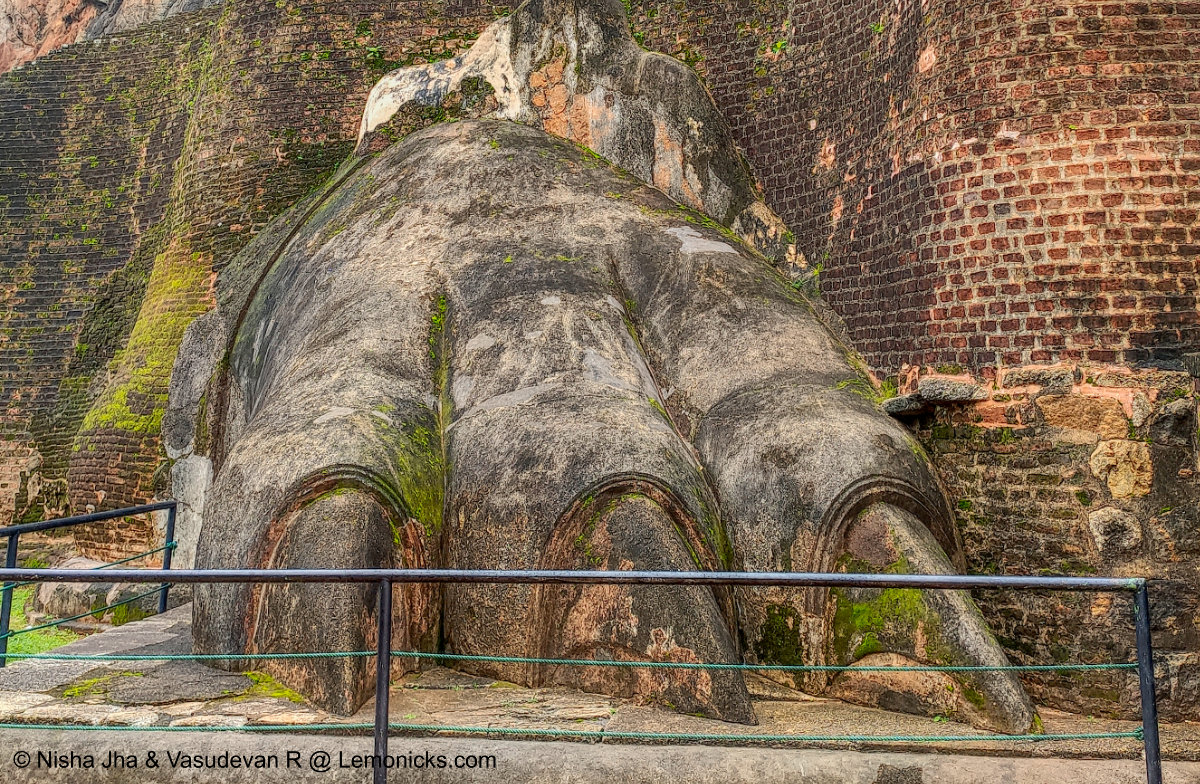
In his own words, HCP Bell, writes, “When following the curved ground line of the north façade to the massive brick structure, some stucco-covered work was uncovered. This at first seemed to represent very roughly moulded elephant heads – three on either side of the central staircase – projecting from the brick work in high relief, life size. Closer examination and the presence of a small boss further back than the ‘heads’ gave the clue to a startling discovery – the most interesting of many surprises furnished during the four season’s work at Sigiriya.
These alto relievos were not a variant form of the ‘elephant-headed dado’. They were none other than the huge claws – even the dewclaw – of a once gigantic lion, conventionalized in brick and plaster, through whose body passed the winding stairway, connecting the upper and lower galleries, towering majestically against the dark granite cliff, bright coloured and gazing northwards over a vista that stretches almost hill-less to the horizon, must have presented an awe-inspiring sight for miles around.
Thus, was clinched forever to the hill the appellation Sihigiri “Lion Rock.” …here then is the simple solution of a crux which has exercised the summaries of writers – the difficulty of reconciling the categorical statement of the Mahawamsa and the perpetuation to the present day to the name “Singha-giri” (Sigiri) with the undeniable fact that no sculpture or paintings of lions exist on Sigiri-gala”.
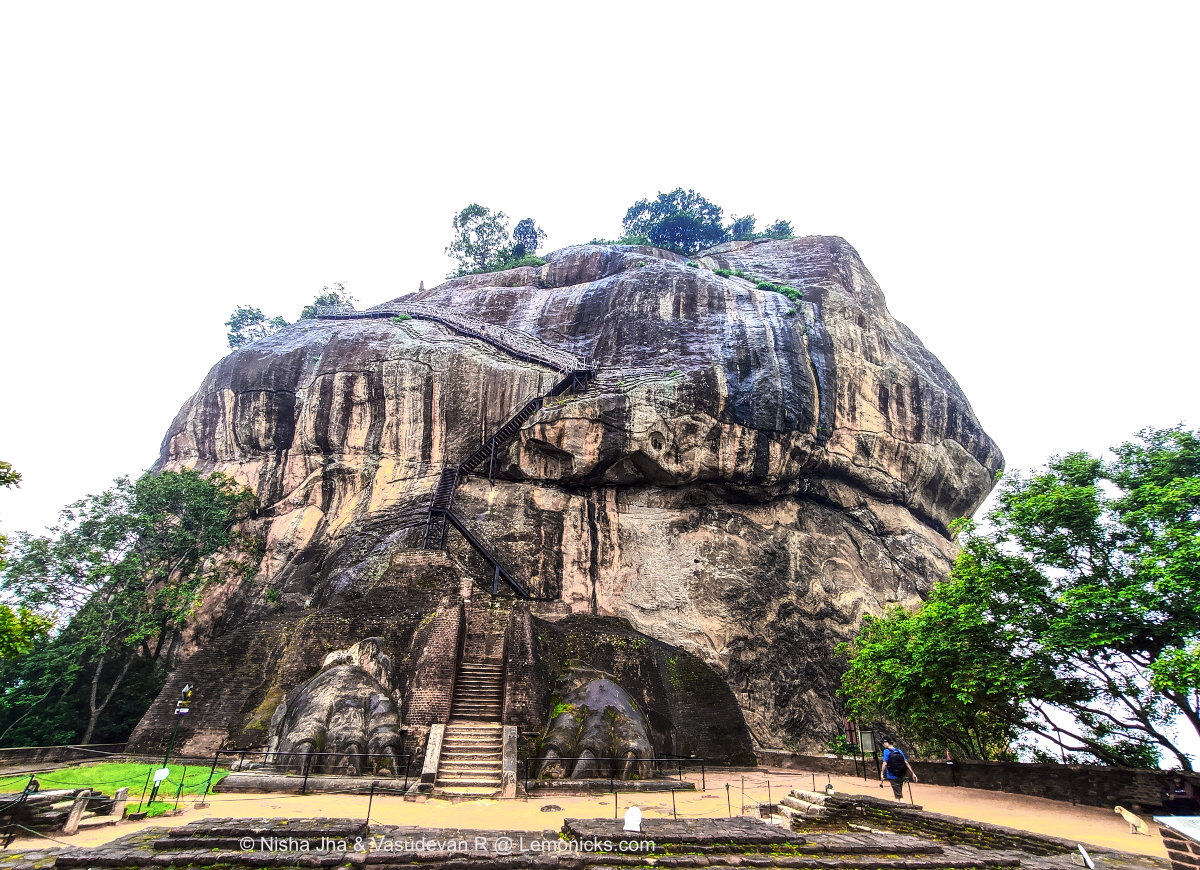
Wow! What an interesting life these archaeologists lead!
The lion’s paw terrace is the gateway to the summit and the royal palace. Not everyone was allowed to enter the “Den of the Lion”, so to speak!
The paws and the claws were gigantic. Just the claws were over one meter in height, chest high of an average male. This alone gives an idea of the proportions. the top is about 50Metres from this terrace. Just imagine a 50 Meters tall sitting lion.
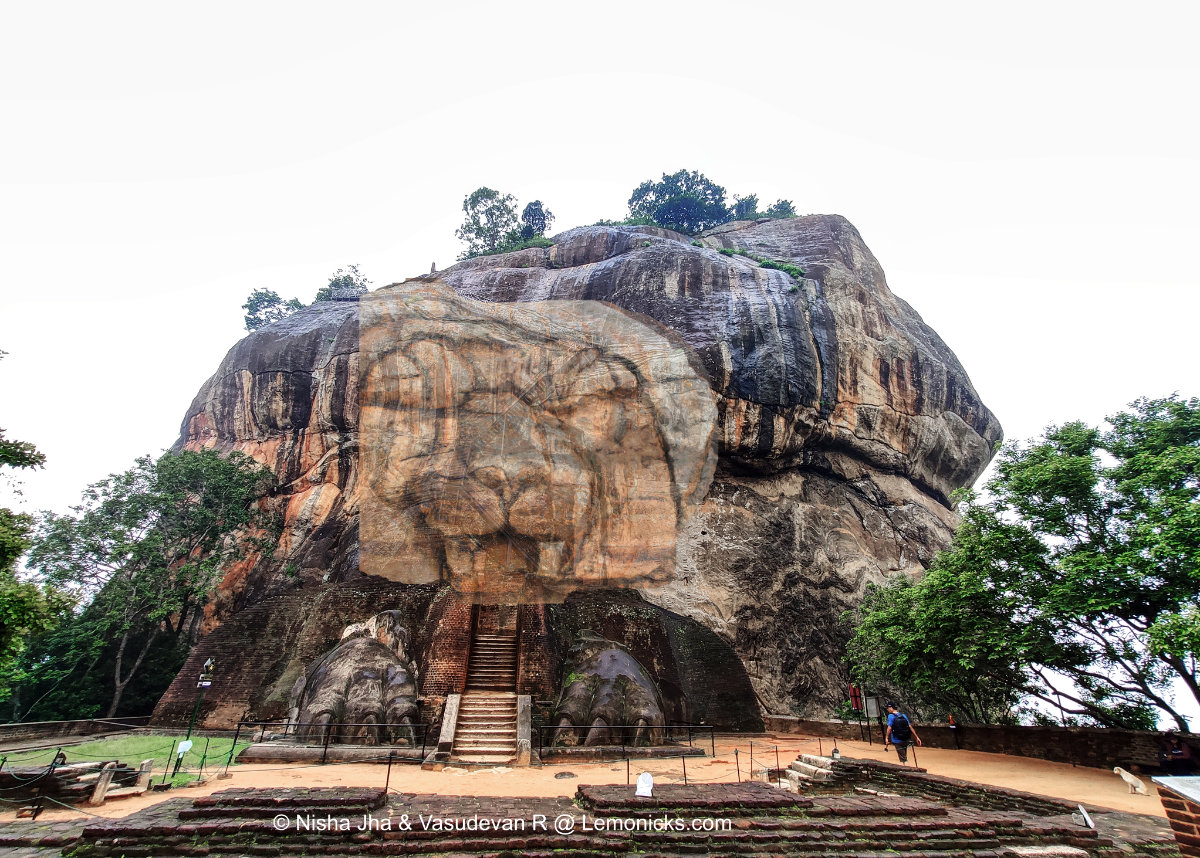
After resting for a couple of minutes, we started our final ascent with the steps in between the two paws. The steps and iron ladders were now steeper, made more perilous due to the intermittent showers which made the iron steps slippery. The iron ladders are well fastened to the rocks, but at least once thoughts would arise as to the safety of these contraptions. Well, I made it back to write about it! It took us 16 minutes to climb the final 50 metres! By far it was the most difficult part of the climb.
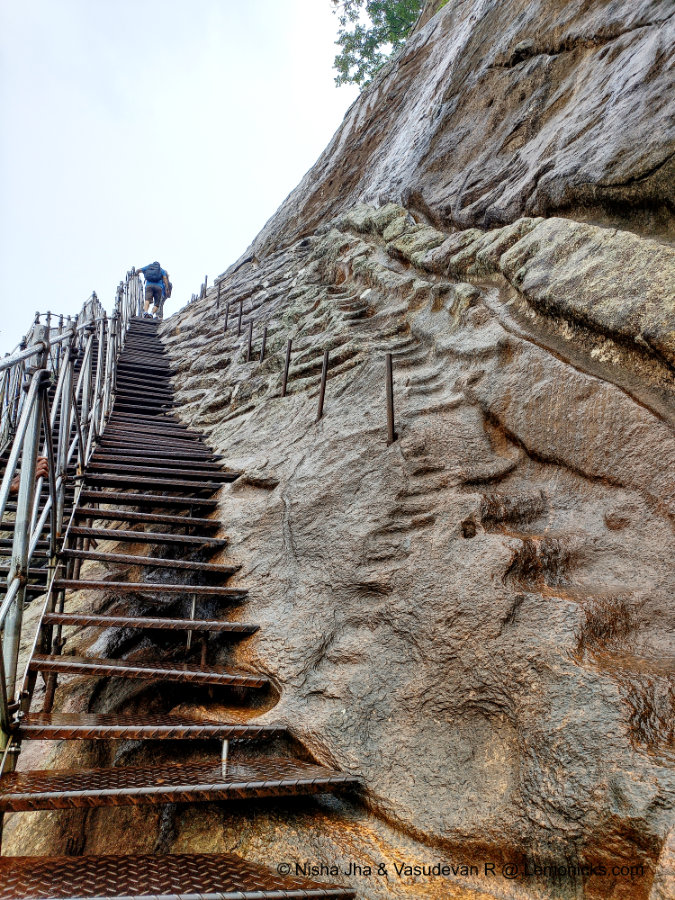
The staircases are often steep and made of steel clasped onto the sides of the rock. It is not very difficult to climb if you do not have any joint issues and lead a reasonably active life. It took me around 1 hour to reach the top, from the water garden, including taking photographs on the way and resting for a couple of minutes.
If you have enough time, you may want to stay back for a spectacular sunset at the Sigiriya Summit.
Explore the Ruins of the Royal Sky Palace
The tabletop summit was quite huge but not well marked. You would surely need a guide to explain stuff at this Palace on the sky also called Akasa Maligawa (Sinhalese – Alalamandawa, Tamil Agasa Maaligai , Hindi -Akash Mahal).
As expected, the place is in ruins, but one can make out the foundations of several levels of stairs, rooms, ponds, gardens, palaces etc. There is a huge bathing pool which serves multiple purposes of ablution and the water here is piped to reach the ground level by series of underground drains!
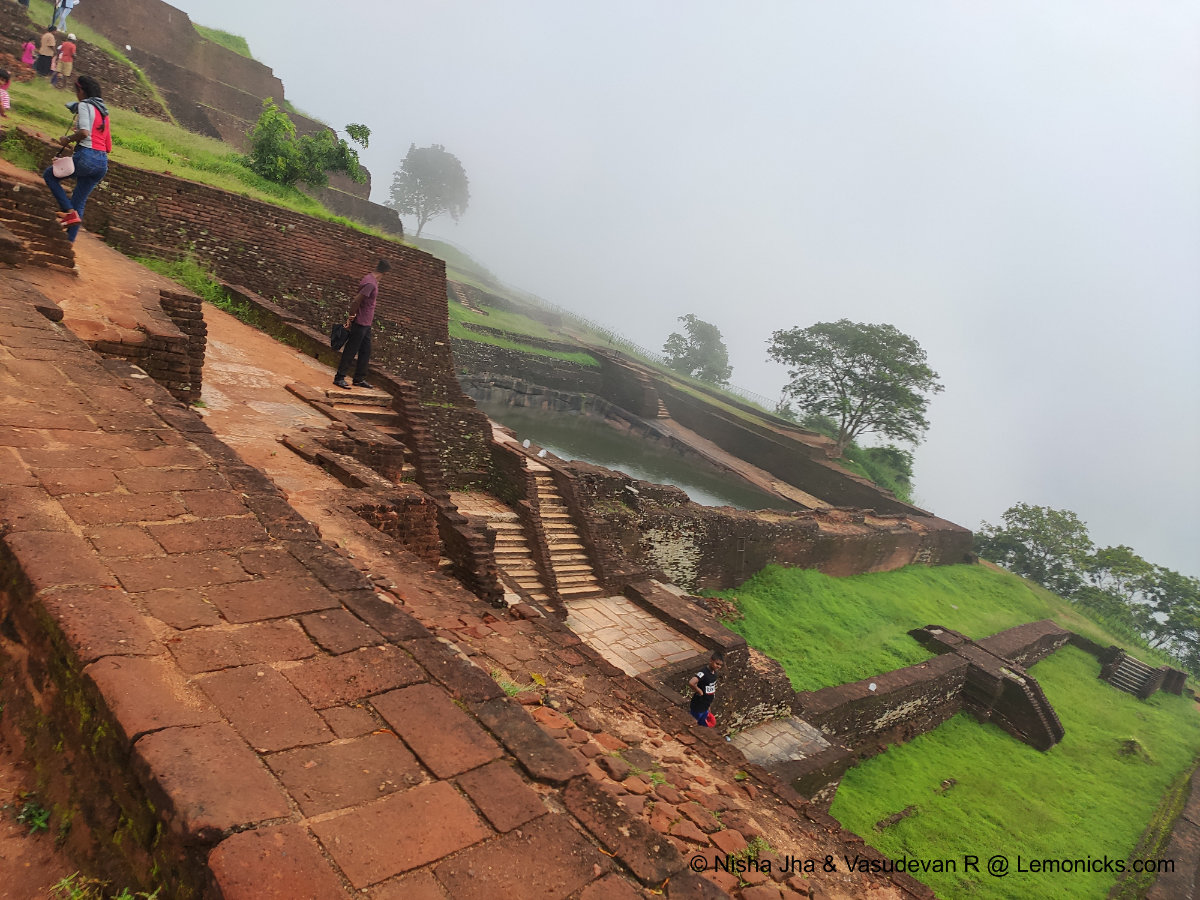
It is believed that a compound wall fully surrounded the summit rising from the rock’s slopes.
Since there are no walls or roof extant here, you would have to use your imagination to visualize several golden roofed rooms and the central palac e with the biggest golden roof of all. The central palace is also the highest point on the Sigiriya mesa summit.
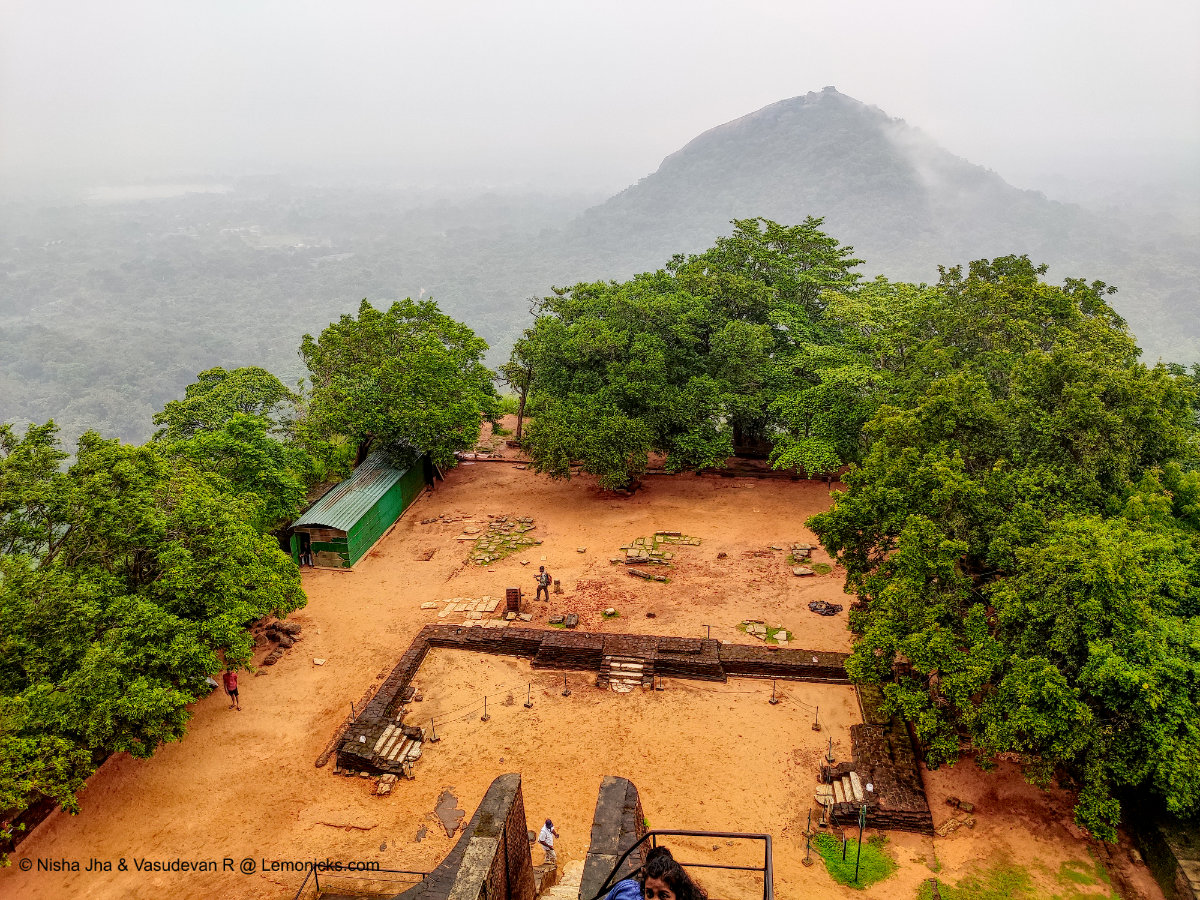
Take time to look around for some amazing views of the emerald forests and Pidurangala Hill. Do not miss the stunning view from the Western side. The view of the gardens below is just out of the world! If time is not a constraint you may want to climb Pidurangala Hill for a view of Sigiriya fortress.
Check out the Mirror Wall and its Ancient graffiti at Sigiriya Lion Rock
Descending the iron steps was a bit more challenging in the light drizzle. The slippery surface of the narrow metal tread meant one had to descend ever so slowly. The authorities had made sure after a point the route for descent was different to enable smooth traffic of tourists. Upon reaching the Lion’s Paw terrace we continued to descend to the staircase that led us to the next attraction, the famous Sigiriya mirror wall.
As per the original design, along a 100 M ledge about midway up the rock a protective brick wall was erected, plastered, smoothened and polished using special chemicals, to a point that it reflected like a mirror. It is said that this was done so that King Kasyapa could admire himself while passing by.
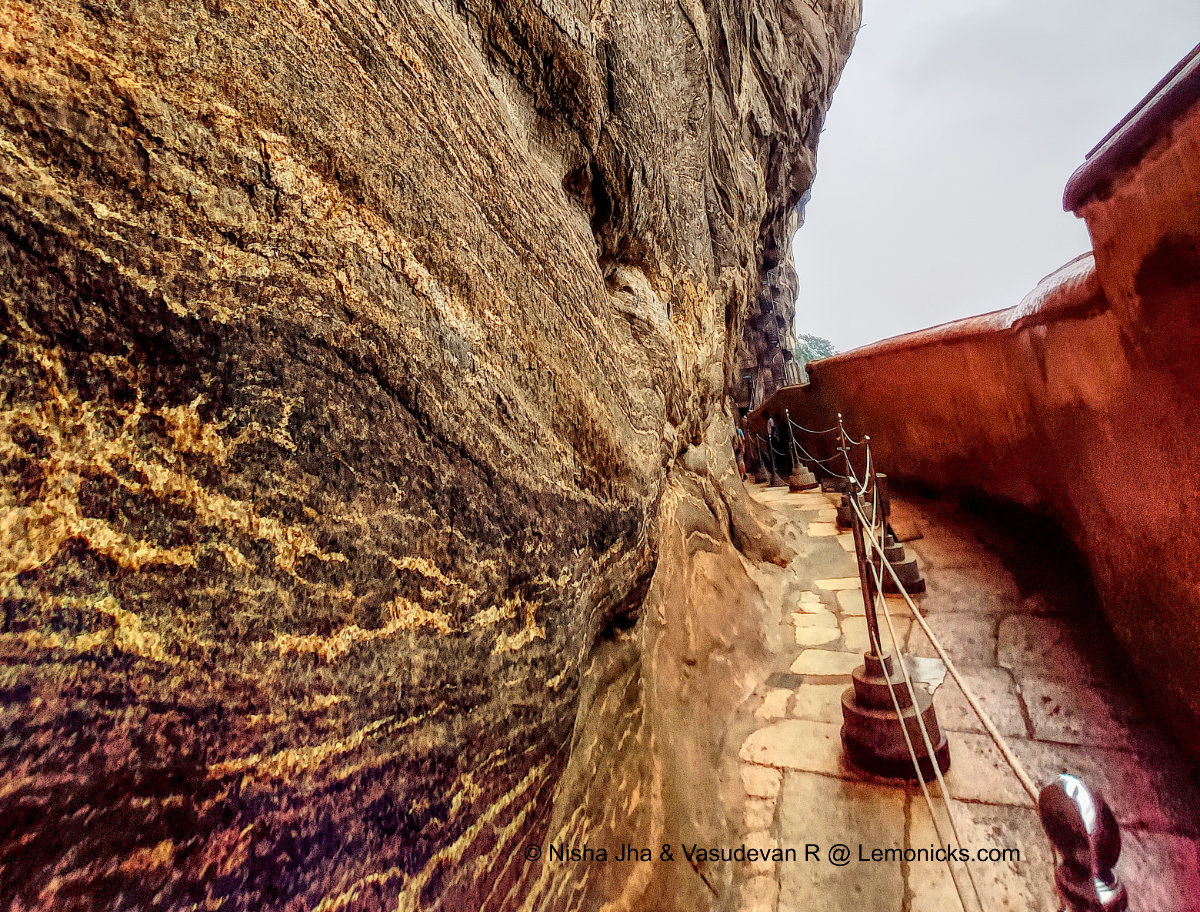
Over period, the sheen wore off and people and monks used it to post stuff (graffiti) on the wall (why am I reminded of social media!). Expert epigraphists have identified more than 1500 different messages, many of them poems in Sinhalese. The graffiti on the mirror wall is a rich source of original information about the Sinhalese people 800 or more years back. Many of these poems are about the Sigiriya Frescoes, on the rockface above. Some of them describe the lion on the western terrace.
Even though it is not shiny, the mirror wall did reflect people’s thoughts, wouldn’t you say!
On the internet I found this interestingly funny poem, scribbled on the mirror wall of Sigiriya. The English translation goes like this:
If you are interested in more on the graffiti poems, head here !
Admire the Frescoes of Heavenly Maidens or Apsaras or Celestial Nymphs or Cloud Maidens
The Mirror Wall Gallery leads us to an iron spiral staircase which takes us to the Frescoes of the cloud maidens.
When the ancient city Sigiriya was at its peak, researchers say that western side (main entrance side) of the rock was not only painted white but also frescoes of semi-nude Apsaras or the celestial damsels were created on a canvas of 40 Meters height by 140 Meters length! It seems, as per one of the messages on the mirror wall, there were 500 such figures.
We saw that only about 21 or so survived in this particular stretch of the overhang, called the “fresco pocket B”, in a depression in the rockface. As per our guide there are a few more but not allowed for tourists and not as beautiful.
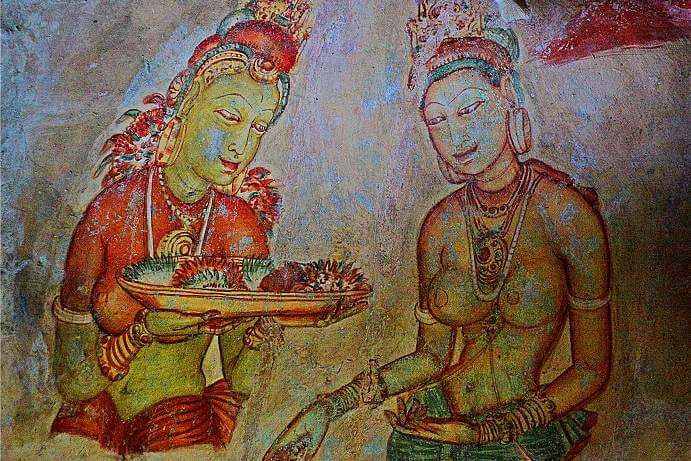
Some of the ladies are seen carrying flowers as if in a procession. One common factor is that all the figures start only waist up as if rising from the clouds. It is still a matter of debate if these mysterious ladies are from the harem of the king or depict the heavenly maidens or someone else! Some of the paintings are in pairs. One of them fair skinned and the other dark skinned. Some scholars say, the dark ones are the cloud ladies, and the fairer ones represent lightning. We don’t think we will have any definitive answer soon. 🙂
These paintings reminded me of Ajanta caves frescoes. Our guide mentioned the technique used to create these exquisite frescoes was quite the same. Only after getting on to the gallery, we realized that we were literally hanging in the air! There was no solid rock beneath us. Just a steel box covering the place.
Photography and Videography is Strictly prohibited in this fresco gallery. There are guards watching you!
It was not always so till a few years back when photography was allowed without flash. However, many tourists did not pay heed and often used flashes. The menace was so much that the authorities completely banned all forms of photography including the use of mobile phones.
Discover more Attractions at Boulder Garden level
The exit is by another spiral stairway that takes to a terrace on the Southern side. (Lion’s Paw is North). On reaching Boulder Garden we found there were more 5th century structures.
Audience Hall: This is probably the royal visitors waited before being escorted up. It once had a roof then but not anymore.
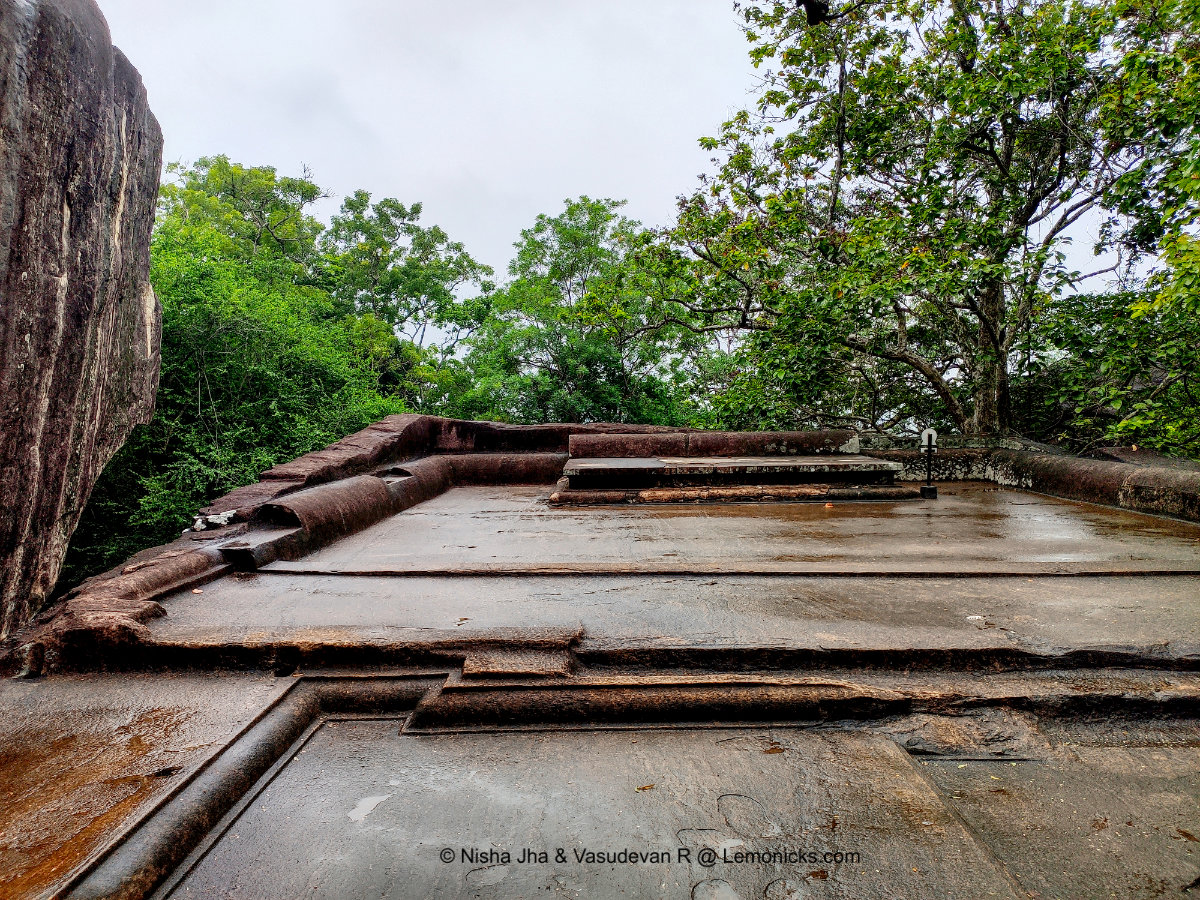
Asana Cave: Asana means a chair or a seat which has been carved out of the rock. This was made for use by meditating monks, when Sigiriya was a monastery.
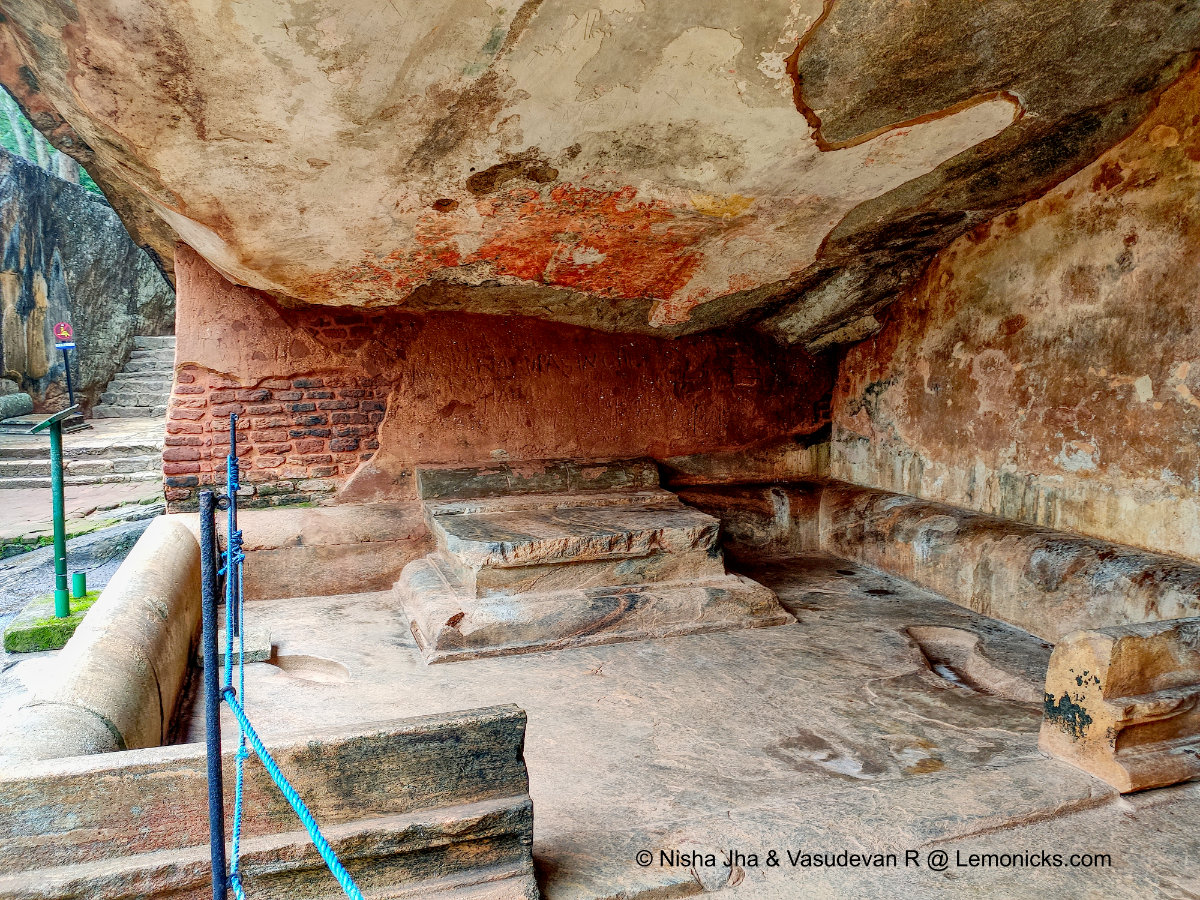
Cobra Cave: It is so called as the roof looked like a cobra ready to strike. Also used by monks.
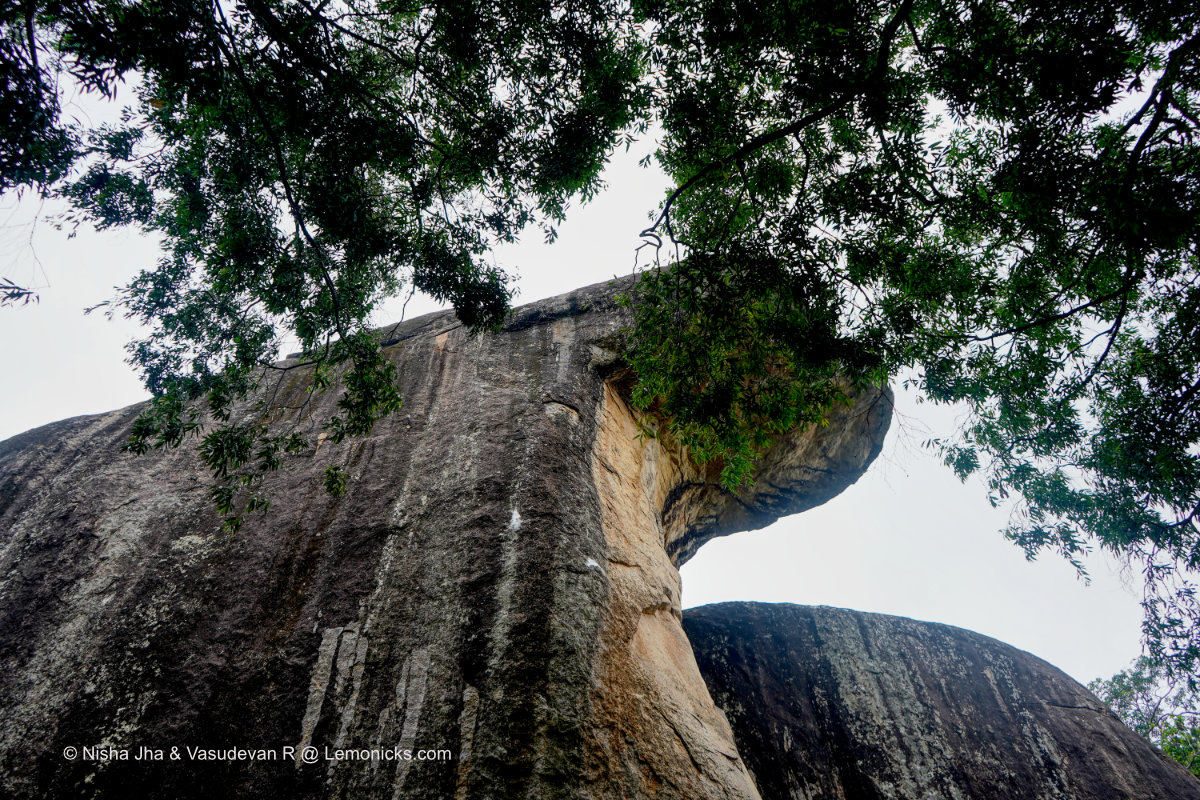
Visit the Archaeological Museum at the Sigiriya Lion Rock Fort Complex
For want of time we did not visit the museum at Sigiriya. However, if times is not a constraint, then it is very much worth a visit.
All artifacts such as clay pots, human skeletons, Jewelry, tools etc. discovered during the excavation of Sigiriya Lion Rock, are exhibited here.
For those who cannot climb to the top of Sigiriya Rock Summit, they must visit the Sigiriya Museum, near the entrance. The museum has been designed to mimic the look and feel of the Rock Fortress Complex of Sigiriya.
We are told that more information on and translations of the messages on the mirror wall are found here. Also, for those who would like to take home photos of the Apsaras, they can do so here. There are reproductions of the original frescoes for you to click away.
After returning to our vehicle, the only thought in my mind was how did they achieve this engineering marvel built during a period when almost everything had to be done by manual labor.
Story of Sigiriya in Sri Lanka
Sigiriya Rock Fortress is steeped in a fascinating history—some believe the complex dates to the 5th century CE and others relate it to the Ravana period.
There are various versions of the story of Sigiriya doing rounds. We will, however, stick with the one told to us by our guide and some research we did by studying the English translation of Chulavamsa (Culavamsa), one of the ancient chronicles delineating the history of Sri Lanka.
The Story of Sigiriya, the rise and fall of King Kashyapa I
Before diving into the history, let us know who the main characters are.
King Peetiya (Pithiya)- 458 CE to 459 CE: He was the last of the line of 6 Tamil kings who represented the Pandiyan Dynasty of Southern India. The island of Sri Lanka was split into two or three kingdoms traditionally. Of which Ruhuna in the south was always ruled by Sinhalese Kings and often provided refuge to the Sinhala Kings and their family when they were not in power. Anuradhapura was the more affluent and often the target of Tamil kings.
King Dhatusena – 459 CE to 477 CE: Anuradhapura was ruled by 6 successive Tamil kings. Dhatusena, when he came of age, three of them had already died of natural causes. Dhatusena, then called Lord of men, assembled a resistance movement in 455 CE and killed the 3 remaining Tamil Kings, King Peetiya being the last. From Lord of men, he became the King of Anuradhapura in 459 CE.
He was one of the most popular kings and credited with the all-round development of the Kingdom of Anuradhapura. Apart from all the constructions of reservoirs and viharas, he is also credited with building Vajra-Chumbata (Lightning conductor) on some of the Viharas. I am sure it is one of the oldest lightning conductors (lightning rods) in the world.
He founded the Moriya dynasty.
In the words of “the English translated version of Chulvamsa”, Dhatusena had two sons, Kasyapa (Kassapa, Kashyapa) and Mogaallana. Kassapa by a mother of unequal birth and the mighty Moggallana by a mother of equal caste (meaning royal blood).
Mother of Moggallana : She was the primary Royal Queen Consort. The ancient chronicle does not tell us more about her. In Hindi she would be पटरानी (Chief queen). In Tamil, பட்டத்து ராணி. As per the traditions it would be her son (Moggallana) in line for the throne.
Mother of Kasyapa: She was perhaps the favorite concubine of Dhatusena and of non-royal background. Her son Kasyapa was not in line for the throne even though he was the older son of the King.
Prince Kasyapa I – 477 CE – 495 CE : Born to King Dhatusena and a woman of non-royal background. Being the eldest, he did wield enough power in the royal corridors.
Prince Moggallana I – 495 CE– 512 CE : Moggallana was the heir apparent and the younger brother of Kassapa, born to Dhatusena and his chief queen.
Sister of Dhatusena : Mother of Migara, the senapati.
Princess – Daughter of Dhatusena : We could not find her name, but it is said that the King dearly loved her as his life.
Migara : Migara was the son of King Dhatusena’s Sister. He was married to the daughter of King Dhatusena. That is, he was the nephew and the General (Senapati) of Anuradhapura Army. A very powerful and important position in the Kingdom. He later married King Dhatusena’s daughter.
Events leading up to the creation of Sigiriya Rock Fortress
How did kasyapa become the king of anuradhapura.
The popular and powerful King Dhatusena gave his daughter in marriage to Migara, son of his sister (Nephew). Once it came to be known that Migara was ill-treating the princess, torturing and beating her too, the king was furious. He punished Migara by burning Migara’s mother (King’s own sister) alive…. (why man, why?)
Migara was angered but decided to wait for the appropriate time to take revenge.
Migara kindled a desire in Kasyapa’s mind, saying that Kasyapa should be the successor and not Moggallana. He also poisoned Kasyapa’s mind to the extent that Kasyapa started hating his father and nursing a desire to be the king sooner than later.
Kasyapa won over the subjects and some courtiers and imprisoned his father and crowned himself as the King of Anuradhapura. He also selectively punished all the people who were loyal to Dhatusena.
Mogallana could not fight back as he could not raise an army, fled to Jambudipa. We need to assume he took refuge under some friendly Tamil kingdom.
*Note: Jambudipa or Jambudveepa is the old name for mainland India in Sanskrit. In Chulavamsa, India is always referred to as Jambudipa. While performing Havans in India and chanting sanskrit mantras, we Indians also refer to our location as Jambudveepa.
Why did Kasyapa build Sigiriya?
As far as Migara was concerned, he wanted further revenge. He again went to the now King Kasyapa and said there was an untold amount of wealth which Dhatusena had hidden for use by Moggallana. In reality, there was no treasure.
When Kasyapa confronted his father in the prison with this information, asked Dhatusena to reveal the treasure’s hiding place. He kept his silence even after being asked repeatedly, day after day. Dhatusena thought this was a new ploy to kill him. After a few days finding no other choice, he asked the soldiers to take him to Kalavapi or Kalavewa reservoir (one of the biggest reservoirs built by Dhatusena), he would reveal the hiding place of the wealth.
The erstwhile king was taken to the tank where he spent time enjoying the refreshing bath. He then called the soldiers and told them that this tank was his entire wealth.
The soldiers took him to Kasyapa and related the events to him. Kasyapa thought Dhatusena was keeping the treasure for Moggallana, which was why he did not reveal its place. Kasyapa just could not believe that there was no treasure.
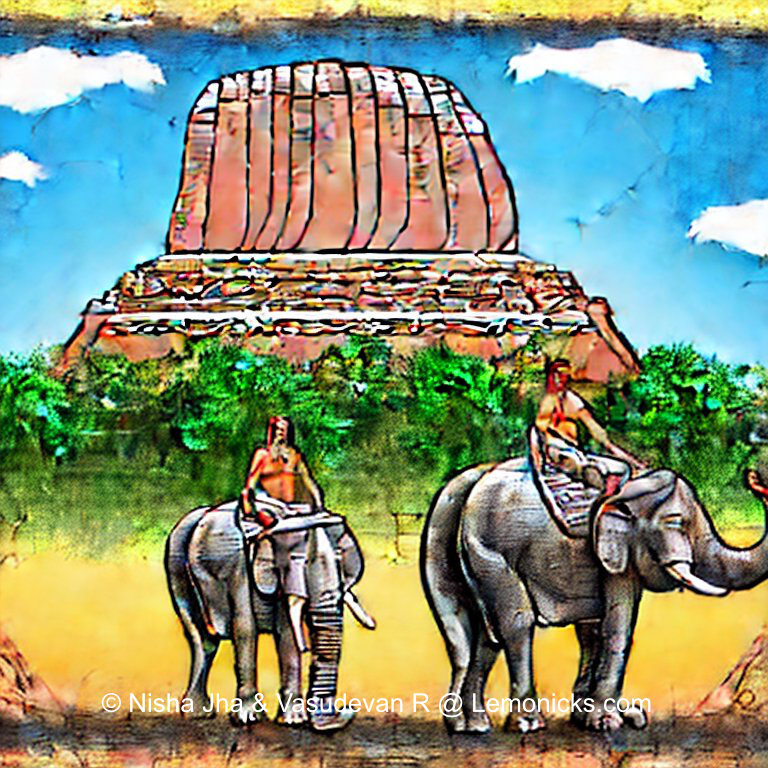
He ordered Migara to take Dhatusena away and kill him. Migara decided not to give him an easy death. This was the time for revenge. He chained Dhatusena and immured him in a wall. (World history is full of such atrocities). It is to be noted that Kasyapa did not order his father to be immured.
When word got out that he was a patricide, the people and the monks were not too happy. Slowly he was afflicted with fear that one day Moggallana would return with a big army and kill him.
So, he decided to create a new capital with a fortress that would not be easy to breach. On seeing the Sigiriya rock outcrop, he knew this was where he would build his new capital. He got the area cleared, built a wall around it. He wanted the whole complex to look like Alakamandawa (Palace in the sky), as it was described in one of the scriptures. It had gardens, the lion gate and the palace on the clouds. He built the mirror wall to admire himself as he passed by, probably to reinforce his thought that he was the most powerful king…. as powerful as Kubera himself!
Note: Some scholars say that part of construction of Sigiriya as a pleasure place for the people was already completed by Dhatusena, an ardent builder. That is how Kasyapa was able to complete the project quickly .
Death of King Kasyapa and return of the capital to Anuradhapura.
As time passed King Kasyapa was ashamed of his past actions and repentant. He did a lot of good for his subject including building orchards, reservoirs, viharas and such. He is known to have expanded the Isurumuni Raja Maha Viharaya to 10 times more than what it was.
On the 18th year of his reign, what Kasyapa feared happened. Moggallana had collected a huge army and was coming towards Sigiriya. In due course a mighty battle ensued between the two brothers of a scale not seen before.
Kasyapa noticed while progressing, a swamp in front of him and turned his elephant to find another route. The soldiers following him thought that their king was fleeing, which brought down the morale of the soldiers and all of them retreated.
King Kasyapa was astonished and cried out to the army to return but it was too late. Kasyapa knew that in no time Moggallana would arrive and take him prisoner. Kasyapa took his dagger out and cut his throat, raised the dagger high and sheathed it, before he fell dead.
In due course, Moggallana collected all the treasures from Sigiriya, handed over the Sigiriya complex to senior Buddhist monks, to be converted into a monastery, and moved the capital back to Anuradhapura and ruled for 17 years.
Legendary Past of Sigiriya Sky Palace, the Ramayana Connection
…….. Involving Ravana, the villain of the Epic Ramayana
There are older histories and legends involving Sigiriya.
One researcher, Dr Mirando Obesekera, says that Sigiriya with its golden palace itself was the abode of Kubera (the god of wealth) several centuries ago. It was called Alakamandawa (Akasa Maligawa, Sky Palace).

Kubera was the ruler of Lanka Island. He was also the half-brother of Ravana, the notorious villain of Ramayana, the grand old epic.
In time Kubera was sent to the Himalayas to find a place near Mount Kailash and Ravana took over the reins of Lanka.
It is also said that Ravana had kept Sita as prisoner at the Cobra Hood Cave at Sigiriya.
Useful Information on the Lion Rock Fortress of Sigiriya in Sri Lanka
Tidbits, snippets, trivia.
- Duran Duran’s song video “Save a Prayer” was completely shot in Sigiriya and other parts of Sri Lanka. Don’t say a prayer for me now Save it ’til the morning after No, don’t say a prayer for me now Save it ’til the morning after
- The Ancient city of Sigiriya is one of the 8 UNESCO world heritage sites accorded in the year 1982.
- Yet another myth doing rounds is that the flat topmost part of the Sigiriya Summit, which is as big as a small helipad, was used to land the Pushpaka Vimana, which Ravana had stolen from Kubera. Some others say that the airfield was in Wariapol.
- Locals call Sigiriya, the 8th wonder of the world.
- From the sources, it does not look like this Moriya Dynasty is not related to the Mauryan Dynasty of India. They are about 700 years apart.
Tips on Sigiriya
- Better to arrive early in the morning before 9am or late in the afternoon. It may be hard to climb during noon due to hot weather during some parts of the year.
- Wear a hat or a cap to protect you from heat at the summit. There are no shelters on the top of Sigiriya.
- Carry an umbrella (Locals always do), raincoat or a waterproof poncho as it may rain without much warning.
- Book your tickets online to avoid standing in long queues
- Monkey Menace. There are a lot of monkeys in the complex right from the ground level to the Lions Paw terrace. Be careful when you open a bag of chips. That may be the last you will see of it. We did not see any at the summit.
- There are also Bees and Wasps. There are enough notice boards warning of wasp or bees attacks. The best way not to disturb them is to be as quiet as possible, wherever the warnings are there. It is even more difficult when you have school tours on the premises.
- Having a guide is surely a plus. Alternately you may read this article just the night before the climb and refer to it while climbing. This, I am sure is one of the most comprehensive guides on Sigiriya in Sri Lanka
- If you keep a whole day for Sigiriya, then we strongly suggest using morning time to climb Pidurangala, then the museum and finally Sigiriya and stay till sunset. We are sure to do it during our next trip.
- We stayed at Dambulla, as it was more central to visit various attractions like Dambulla Rock Temple, Anuradhapura, Sigiriya, Minneriya Elephant Reserve etc.
- However, if you want to reach Sigiriya very early, then you may want to stay closer to Sigiriya. See our section accommodation options.
Opening Hours
From 6.30 AM to 5.30 PM every day
Last entrance is 5:00 PM
Ticket Price
- Non Saarc Foreign Adults – 30 USD
- Non Saarc Foreign Children – 15 USD
- Saarc Foreign Adults – 15 USD
- Saarc Foreign Children – 15 USD
- Local Adults – 100 LKR
- Local Children – 50 LKR
- Please note that Museum tickets are separate and costs 5 USD
- Pidurangala Rock – 500 LKR buy at site only
Can I Buy a Sigiriya Lion Rock Entrance Ticket Online?
The short answer is yes. In fact, it is better to buy online to avoid standing in long lines at the ticketing booth.
Where to stay near Sigiriya Archaeological Complex ?
There are a lot of accommodation options like hotels, guest houses and homestays too, around Sigiriya, Dambulla and Habarena.
Please Click here for other accommodation options in Sigiriya, Dambulla and Habarena
We Stayed at Jetwings Lake. Click here to book .
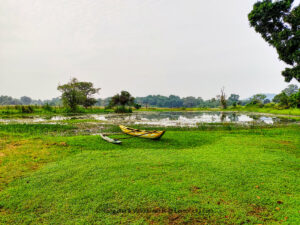
Book Your Tours Here
Get Your Guide: Sigiriya Walking Tour
FAQ on Things to do in Sigiriya
Where is the Rock Fortress of Sigiriya in Sri Lanka?
Sigiriya is located in Matale District and is about 175 KM North-East of Colombo.
How to Get to the Ancient City of Sigiriya in Sri Lanka?
We suggest staying at Dambulla or Habarena, which is central to a lot of other attractions like Dambulla cave, Sigiriya, Minneriya elephant reserve etc. Sigiriya is just about 18 KM from Dambulla by road. There are tuk-tuks and regular buses to Sigiriya. Checkout the last bus back and plan accordingly. We had hired a cab for our entire Sri Lanka trip of 7days which was comfortable, convenient and time-saving. Alternatively, it’s also possible to hire a taxi or join a guided tour from Colombo or other nearby cities.
How much time does it take to explore the Rock Fortress complex of Sigiriya?
On an average it would take about 3 hours give or take a few minutes to explore the water garden, lions paw, Sigiriya summit, Mirror Wall, Fresco gallery and boulder garden. The museum is likely to take an hour or so, depending on your interest.
What is Sigiriya?
Sigiriya is an ancient royal palace located in the central Matale District of Sri Lanka, built by King Kashyapa in the 5th century A.D. It was originally developed as a fortress-palace complex and is renowned for its beautiful gardens and amazing architecture. The site consists of impressive ruins, archaeological remains, artworks, and sculptures.
What is the meaning of Sigiriya?
The name ‘Sigiriya’ translates from Sinhala to mean ‘Lion Rock’ as it resembles a lion that stands guard over its kingdom at the top of the cliffs surrounding the royal palace complex below. It seems to be adapted from Sanskrit word Simhagiri. Simha (Lion) + Giri (mountain)
What is the best time to visit Sigiriya?
The best time to visit Sigiriya is during Sri Lanka’s dry season which is s between December and April when temperatures and humidity levels are lower, making it more comfortable for the arduous climb with no cover.
Is Sigiriya rock a wonder of the world?
Sigiriya is not part of the top wonders of the world. However it is one of the 8 UNESCO heritage sites in Sri Lanka. The locals, however, do call Sigiriya as the 8th wonder of the world!
Why is Sigiriya rock famous?
Sigiriya Rock is famous for its ancient rock fortress, stunning frescoes, and breathtaking panoramic views, making it a must-visit destination for history buffs and nature enthusiasts alike.
Who built Sigiriya rock?
Sigiriya Rock was built by King Kasyapa in the 5th century AD as his royal palace complex, featuring elaborate architecture and intricate water gardens that showcase the ingenuity of ancient Sri Lankan civilization.
What is Sigiriya rock made of?
Sigiriya Rock is primarily made of volcanic rock, specifically a hardened magma plug, known as ‘trachyte,’ which provides the fortress with its formidable structure and enduring presence amidst the lush greenery of Sri Lanka’s landscape.
Other Articles on Sri Lanka
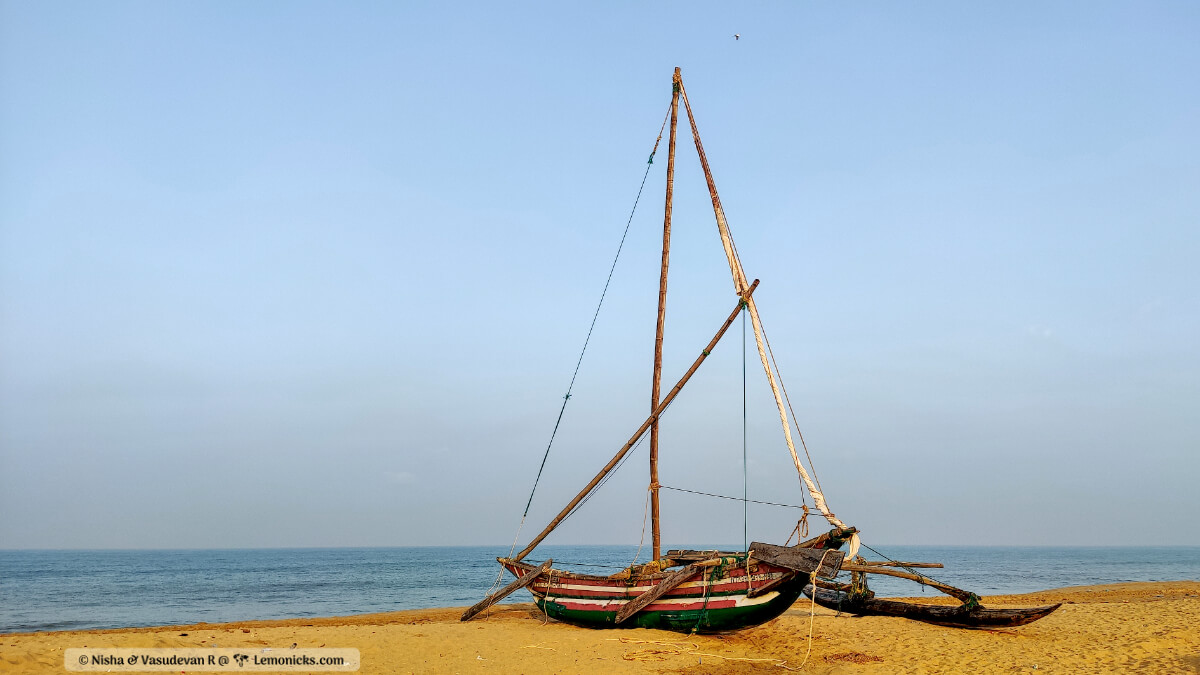
Top 8 Things to do in Negombo Sri Lanka in a Day
Making the Most of 24 Hours in Negombo Sri Lanka Negombo Sri Lanka, located on its Western Coast abo…
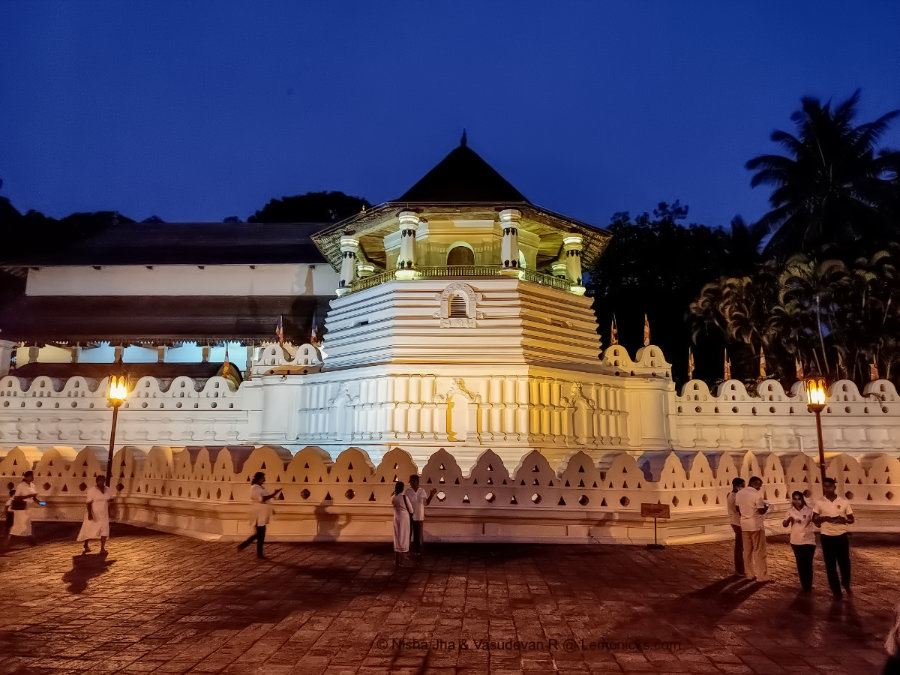
15 Best Things to Do in Kandy : Unforgettable Experiences
Nestled in the central hills of Sri Lanka, at an altitude of 500M above sea level, Kandy is a city s…

Complete Guide to Sigiriya in Sri Lanka A UNESCO World Heritage Site, Sigiriya in Sri Lanka, also kn…
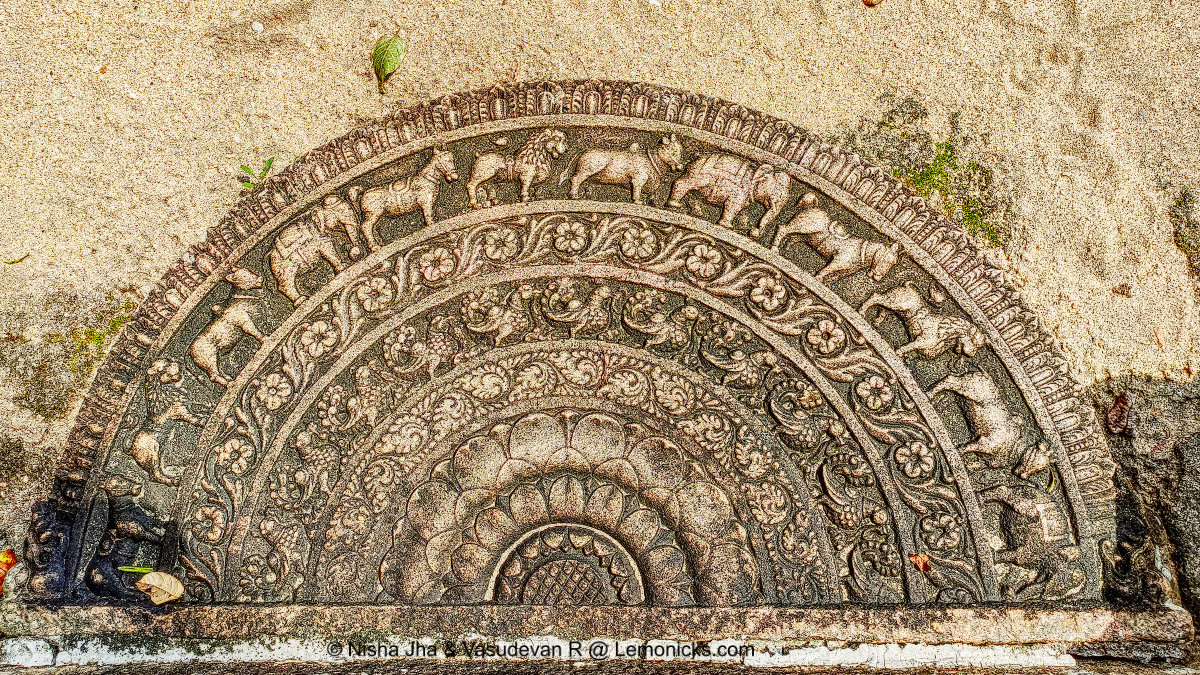
Complete Guide to the Fascinating Ridi Viharaya Silver Temple, Sri Lanka
Ridi Viharaya or Ridee Viharya at Rideegama, near Dambulla in Sri Lanka, is one of the most importan…
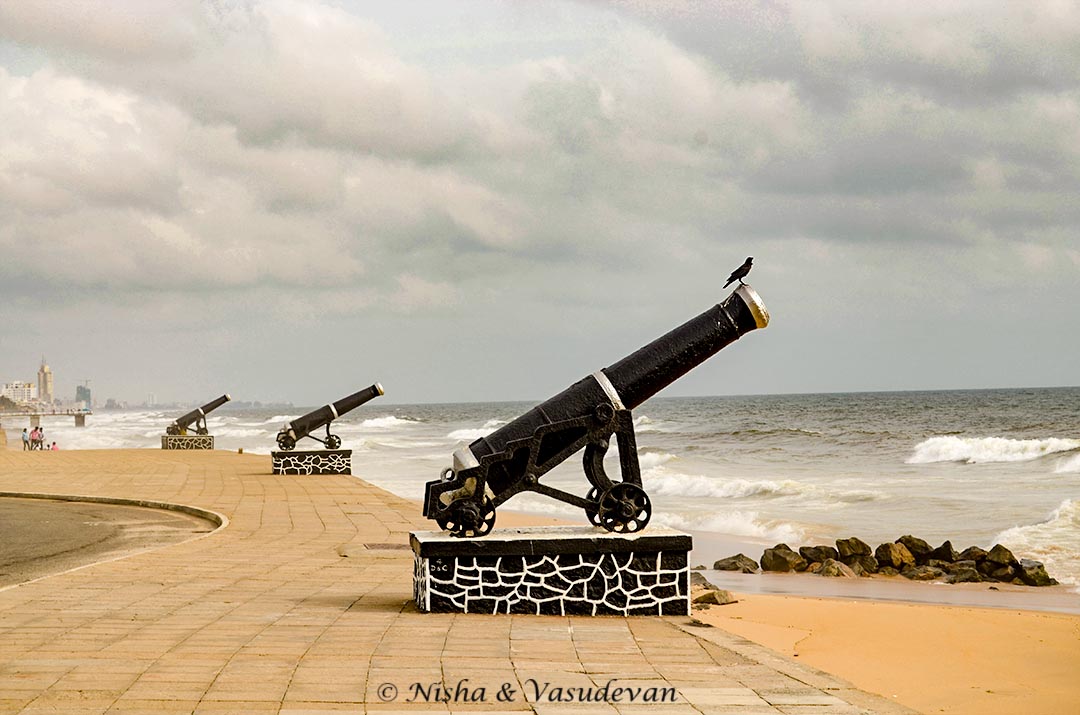
New and Improved Online Sri Lanka ETA Application Process
Cannons at Colombo beach, Sri Lanka Sri Lanka ETA application The new Sri Lanka ETA application is q…
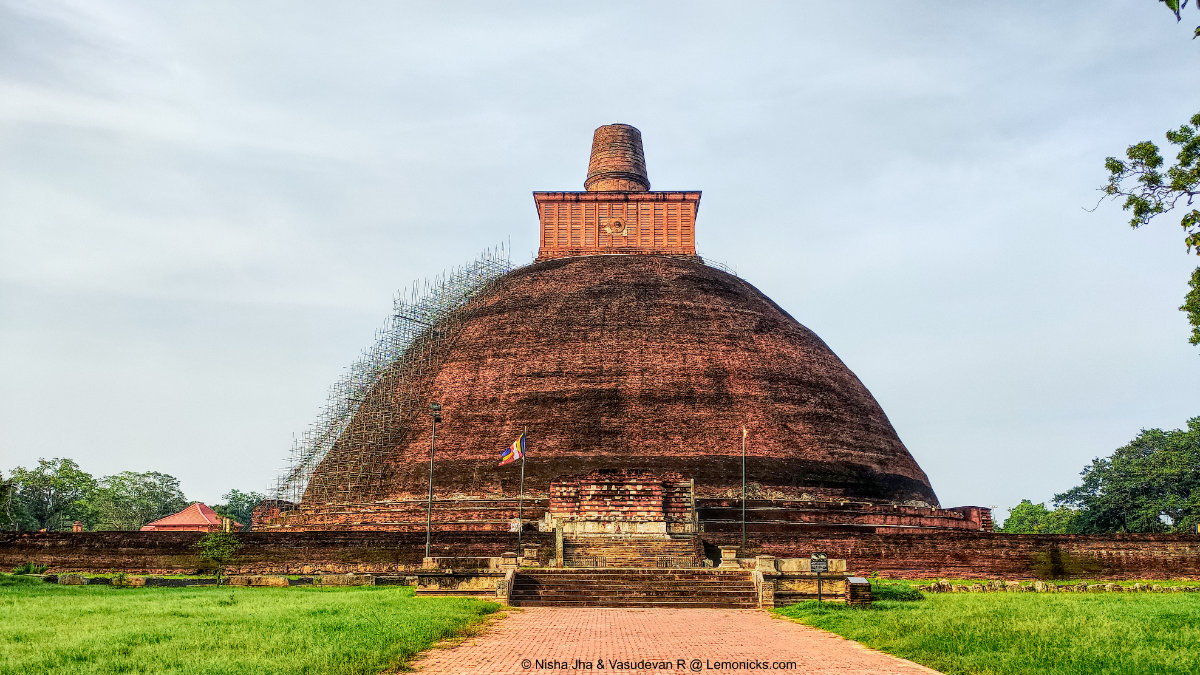
5 Top UNESCO World Heritage Sites in Sri Lanka
During our recent visit, we were fortunate to visit several UNESCO world heritage sites in Sri Lanka…
Photograph Copyright
All photographs used in this article belong to the owners of this website www.lemonicks.com unless otherwise specified. Copying or using them without explicit permission is prohibited and will amount to copyright infringement.
If you want to travel places with us, we invite you to join our feed or Facebook travel page .
P.S.- This article, Exploring Sigiriya in Sri Lanka, the Remarkable Rock Fortress Complex belongs to Le Monde, the Poetic Travels , one of the top Indian Travel Blogs , published by the traveling couple bloggers, Nisha & Vasudevan . Reproduction without explicit permission is prohibited. If you are viewing this on another website other than the RSS feed reader or www.lemonicks.com itself, then that website is guilty of stealing our content. Kindly do us a favour by letting us know via Contact Us . Thank you.
13 thoughts on “Exploring Sigiriya in Sri Lanka, the Remarkable Rock Fortress Complex”
Very interesting article. And very detailed too!
Why don’t you write a novel? You have a knack for writing very well about these historical stories.
Thank you for the compliment! Writing a novel sounds like a great idea, but I’m not sure I’m ready for that level of commitment. I think I’ll stick to shorter pieces for now, but who knows what the future holds? Maybe one day I’ll be the next bestselling historical fiction author!
Your detailed guide provided me with invaluable information about this UNESCO World Heritage Site and has inspired me to plan a visit there myself. I particularly enjoyed learning about the tragic events that led to the construction of the rock fortress, and how it was rediscovered and restored in the 19th century.
I’m glad to hear that my detailed guide on Sigirya Rock Fortress in Sri Lanka, was able to provide you with invaluable information about the UNESCO World Heritage Site, and even more so that it has inspired you to plan a visit there yourself. It’s always rewarding to hear that our knowledge and insights can have a positive impact on someone’s travel plans. The history behind the rock fortress is truly fascinating, and it’s wonderful that you enjoyed learning about it, particularly the tragic events that led to its construction and the restoration efforts. I hope you have a fantastic trip and enjoy exploring this incredible site firsthand!
Sigiriya in Sri Lanka looks looks like such a fascinating place to visit. I would really love to check out the murals and the water garden.
Sigiriya in Sri Lanka, is indeed a marvel, with its beautiful murals and refreshing water garden.
This is such a neat historical feature to visit. It reminds me a little bit of the Mayan ruins in Mexico. I love exploring these old structures.
Well, it’s always great to discover a piece of history, whether it’s in Mexico or right in our own backyard! Archaeologists are still exploring our ruins, trying to piece together the mysteries of our civilization.
I’ve been to Sri Lanka a couple of years ago and loved it! I would love to visit it again, a gorgeous country.
It’s wonderful to hear that you enjoyed your visit to Sri Lanka! With its stunning natural beauty, rich cultural heritage, and warm hospitality, it’s no surprise that the country is a popular destination among travelers. If you do have the opportunity to visit again, you may want to explore some of the other regions or attractions that you may have missed on your previous trip. Sri Lanka has so much to offer, from ancient temples and historical sites to breathtaking beaches and wildlife reserves. I hope you get the chance to return and create even more amazing memories! Please checkout our other articles on Sri Lanka https://lemonicks.com/category/asia/sri-lanka/
Sigiriya in Sri Lanka is such an interesting and unique place to visit! It looks so unusual from the distance – and something I’d love to see in real life.
It’s great to hear that you find Sigiriya in Sri Lanka interesting and would like to see it in person! There’s nothing quite like experiencing a unique destination firsthand and being able to take in all the sights, sounds, and the experience that make it so special. If you do end up visiting, I hope you have a wonderful time and make lots of unforgettable memories!
Definitely going to visit here one day. Such a phenomenal place.
Leave a Reply Cancel reply
Your email address will not be published. Required fields are marked *
This site uses Akismet to reduce spam. Learn how your comment data is processed .
Related Posts

- March 20, 2024
- 29 Comments

- May 30, 2023
- 35 Comments

- April 20, 2023
- 18 Comments

- Sri Lanka , Travel Tips
- April 15, 2023
- 23 Comments

- December 11, 2023
- 14 Comments
Be the first to read our travel stories!
Thanks, I’m not interested
Saturday May 04, 2024
Group News Sites
Dailymirror
Sunday Times
Tamil Mirror
Middleast Lankadeepa
Life Online
Home delivery
Advertise with us

Sigiriya: A sustainable wonder to the world
Wednesday, 4 August 2021 00:00 - - {{hitsCtrl.values.hits}}
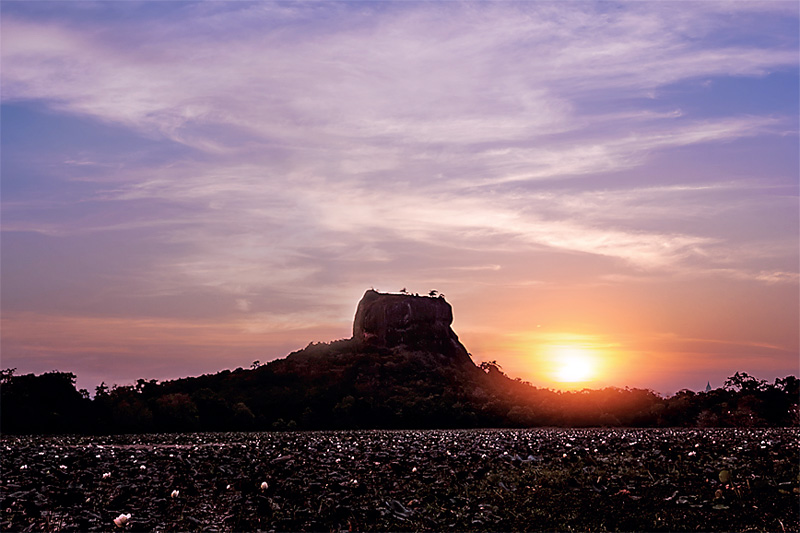
- Redesigning Sri Lanka’s Tourism to be sustainable, green and resilient.
Sigiriya: The Lion Rock fortress
Sigiriya, considered to be one of the most valuable historical monuments in Sri Lanka, has long been renowned as an architectural wonder of urban planning and engineering, and a UNESCO world heritage site since 1982. Converted into a royal palace following King Kashyapa’s flight from the then capital Anuradhapura, the inner-city tiers, water gardens and moats are credited for their advanced, ingenious design. The richly decorated frescoes and mirrored wall have also led Sigiriya to become one of Sri Lanka Tourism’s most prominent archaeological attractions. The latest addition to Sigiriya’s accolades is the recent announcement by Bloomberg, that listed the Lion Rock fortress, as one of the new seven wonders of the world. Bloomberg’s announcement is timely for Sri Lanka, as the island plans to take advantage of the new behavioral patterns that are expected to emerge among post-pandemic travelers. According to experts from the United Nations World Tourism Organization (UNWTO), travelers are now more likely to demand a focus on sustainability, connections with local communities, open-air and nature-based cultural experiences—in other words, the ethos of travel in our little island home. Before global travel restrictions, the tourism sector in Sri Lanka was the third-largest export earner accounting for around 5% of the Gross Domestic Product (GDP) in 2018 with the sector directly employing 250,000 people and up to two million, indirectly. The number of tourists visiting Sri Lanka nearly doubled from 1.5 million to 2.3 million from 2014 to 2018. Revitalising this sector through a speedy, clean and green recovery has the potential to provide tangible benefits to the Sri Lankan economy and communities across the island.
Building back tourism
The United Nations Development Programme (UNDP) in Sri Lanka in collaboration with the Sri Lanka Tourism Development Authority (SLTDA) has been focused on just that: building back tourism as a resilient and sustainable sector. The newly developed Tourism Roadmap, ‘Putting People First: Building a More Resilient Tourism Sector in Sri Lanka,’ aims to rebrand Sri Lanka which, for decades, has been pegged as a mass low-spending market, to an unmissable, signature experience recognised for its niche, indigenous products and services around nature, wellness, culture and adventure. It also aims to redesign the industry to protect it’s people. Sri Lanka’s tourism is still reeling from the devastating Easter attacks in 2019, and are only just getting its bearings together from the global travel collapse and effects of COVID-19. This roadmap for Sri Lanka, aims to provide social protection nets for those in the industry to withstand such untimely events in the future. UNDP will continue to assist the Government of Sri Lanka in updating the Tourism Development Strategic Action Plan 2021-2024, while also enabling Sri Lanka to transition to sustainable tourism by creating guidelines and standards for nature-based tourism. Prior to the pandemic, SLTDA put sustainability at the core in reviving this sector, by launching the National Sustainable Tourism Certification in 2018 with financial and technical assistance from the Biodiversity Finance Initiative (BIOFIN). Such programmes are essential, as tourism is often a source of pollution and biodiversity degradation with the benefits of tourism not trickling down to local communities. This certification scheme is geared towards promoting sustainable accomodations, destinations and tour operators. The first phase of obtaining certification for accommodations was successfully completed, while SLTDA and UNDP are currently focused on obtaining Sustainable Destination Certifications for 9 destinations across the 9 provinces in the island. This certification scheme enables tourist destinations to be rated based on the overall quality of service and exclusiveness of the experience. Currently, 28% of total revenue from visiting international tourists is generated through biodiversity related attractions. This certification will further contribute to tourism, by attracting more eco-conscious tourists which will generate more revenue to help improve the biodiversity of these destinations. Despite the high value of these attractions, hardly any revenue is put back into developing and conserving these attractions and its surrounding habitats. The Destination Certification looks at sustainably managing the existing biodiversity, by encouraging key tourist destinations to invest 0.5% (equivalent to $ 5 million per annum) back into biodiversity management. The scheme injects cash back into conserving natural resources and the surrounding local communities, ensuring tourism will be for the people and planet, leaving no one behind.
Sigiriya: The path to sustainability
Sigiriya, already a popular attraction amongst tourists, has been targeted for the sustainable destination certification particularly given issues noted by tourists such as overcrowding, congestion, and plastic pollution among many others. UNDP Sri Lanka Climate and Environment Team National Project Coordinator Ramitha Wijethunga also notes, “the importance of protecting Sigiriya for future generations is very clear now. Under the Sustainable Destination Management Certification programme, the Ministry of Tourism and SLTDA together with the UNDP-BIOFIN project has taken steps to develop a plan to support the implementation, to ensure the sustainability of this cultural excellence and looks to extend this beyond Sigiriya into other wonders across the island.”
Nature-based solutions
Some of these plans include the creation of a plastic free zone, upskilling neighboring communities to be interpreters, management of tourist flow through digital technology, development of neighboring attractions such as Pidurangala and Kaludiya Pokuna for visitor overflow and distribution. Tourism depends on the preservation of an attractive environment and certification acts as an incentive to tourism providers to rebuild these locations to be more eco-conscious. The National Sustainable Destination Certification is a first step in promoting nature-based solutions for the country’s green development. As flagged by the UNWTO, a green recovery is essential post-pandemic, in catalysing the responsible recovery of the tourism industry, balancing the needs of the people, and the planet for Sri Lanka’s green growth.


What are you looking for?
15 amazing things to do in sigiriya (sri lanka).
Sigiriya is easily one of the most famous places to visit in Sri Lanka .
2 words … Sigiriya Rock.
It is a landmark that has been photographed and shared by hundreds of thousands of people from all around the world.
As well as this, there’s plenty more to see and do, which is why Sigiriya is such an important stop on any tour of this spectacular country.
So, to help you plan your stay and get the most out of your visit, here a list of our 15 top things to do in Sigiriya this year.
But first ...
How To Get To Sigiriya, Sri Lanka
Getting around Sri Lanka is actually surprisingly easy, and there’s plenty of options available to you.
For Sigiriya, here’s a look at the 3 best options:.
1. Bus - Buses run regularly all across Sri Lanka from all major towns and cities. They are probably the cheapest option available to you, especially if you are travelling solo. We always try to use 12GoAsia for booking bus journeys in Asia. You can check bus times and prices on 12Go Asia here.
2. Taxi (or Uber ) - There are plenty of taxis all around Sri Lanka, and even Uber in Colombo. I would recommend using Uber more, as you know exactly what price you will be paying and can ensure you get a good quality vehicle. They are also usually much cheaper than taxis.
3. Tuk tuk - We rented a tuk tuk in Colombo for 4 weeks and used this to get around the whole of Sri Lanka. They are pretty cheap and fuel costs about $3-5 a day. They have the added benefit that you can visit places that are a little off-the-beaten-track and you never have to rely on anyone else.
If you’re flying into Sri Lanka and only plan on visiting Sigiriya for the whole of your trip, then it’s best just to grab some transport straight from the airport, rather than heading into a busy city like Colombo.
Personally, I would probably opt for an Uber which, at the time of writing, is coming in at around 5,000 to 7,000 LKR.
Between 2 or more people, that is very affordable and the ride should take no more than 4 hours.

For transfers around Sri Lanka, we always recommend using 12GoAsia .
Getting Around Sigiriya
You've got a couple of options when it comes to getting around Sigiriya.
- Tuktuk : We had our own tuk-tuk to get around the best tourist attractions in Sigiriya, but even if you are not driving your own, you can make use of tuk-tuk taxis which are readily available and cheap.
- Tours & private driver: If you aren't comfortable driving your own vehicle or organising your transport, then you can make sure of a private driver which area easily arrange via your accommodation, or opt for tours when available.

More Info: Our Complete Guide To Getting Around Sri Lanka
Where To Stay In Sigiriya
There are tonnes of hotels, hostels and resorts available in and around Sigiriya.
Prices range from as little as $8 a night for a double room, up to a few hundred dollars for a luxury resort.
We stayed at Cassandra Culture Resort and had the most wonderful time, so can highly recommend it.
Here’s some good recommendations based on different budgets.
Budget Choice

Wish Prabha Lakeview Lodge

Cassandra Culture Resort
Luxury Pick

Water Garden Sigiriya
$320 (pppn)
The 15 Best Things To Do In Sigiriya, Sri Lanka
Okay, now it’s time for the part you came for, an ultimate guide on the best things to do in Sigiriya!
1. Climb Sigiriya Rock (Aka Lion Rock)

This is by far the best thing to do in Sigiriya.
And we were incredibly excited to climb, seeing as we’d spent a whole day staring at it from our hotel balcony.
And we really weren’t let down by the experience!
If you’re short on time, you can take a tour from Colombo to visit the amazing Sigiriya Rock . It's an experience that shouldn't be missed as it really is the best thing to do in Sigiriya.
As the most popular thing to do in Sigiriya, I thought I’d include answers to some of the most common questions you might have:
What Is The Best Time To Visit Sigiriya Rock?
The morning time is best, as it is much cooler than it will become at midday.
The ideal time would be to arrive about half an hour after they have officially started letting people in. That way, you avoid walking up behind large crowds.
How Long Does It Take To Climb Sigiriya Rock?
Probably around an hour. However, if you head up during peak times, you might take a bit longer. Especially if you want to see sights along the way and stop for photos.
What Are The Sigiriya Rock Opening Hours?
Throughout most of the year, Sigiriya Rock is open from 7am till 5:30pm.
How Much Does It Cost To Climb Sigiriya Rock?
As with most things in Sri Lanka, this comes down to whether you’re a local or a foreigner. For locals it’s 50 Rupees and for all foreigners its 30 USD (5000 Rupees).
Is Sigiriya Rock Hard To Climb?
As long as you head up early, before it gets too hot, then most people should be able to climb it. The only tricky part is the last ascent when you go up metal stairs. These can be a little treacherous when wet, so some might find this a bit daunting.
What Should You Wear When Climbing Sigiriya Rock?
Good shoes are a must. Flip flops aren't a smart idea, as you risk slipping at some point. Other than that, shorts and t-shirt should be fine. There aren’t any religious clothing requirements for Sigiriya Rock (p.s. be sure to check out our full Sri Lanka packing list ) .
How Do You Get To Sigiriya Rock?
We went by Tuk Tuk, and it's pretty easy to find. In fact, I’ve included a screenshot below of where the car park is. Google maps or Maps.me should get you there no trouble. Other than that, there are lots of tours that run to Sigiriya Rock . Your hotel/hostel should be able to help you out with arranging transport.
How Was Sigiriya Rock Formed?
This is actually the most surprising thing about Sigiriya Rock. It turns out, it was made around 2 billion years ago! It is actually a large block of molten magma that hardened and plugged a volcano. The area was once full of volcanoes but these have long gone. Now it is just Sigiriya Rock and Pidurangala Rock left.
For more information on when to visit and how to get the most out of your trip, check out our full guide on visiting Sigiriya Rock .

2. Enter Pidurangala Rock

Pidurangala Rock is hard to miss, as it’s situated right next to Sigiriya Rock! However, it is in itself a very impressive site to behold.
It is almost as high and also offers breathtaking views out across the surrounding forestland.
Many people choose to climb Sigiriya Rock early in the morning and then walk up Pidurangala Rock to catch the sunset.
You’re welcome to do each one after the other, but it will be tiring and you’d be walking in the midday sun.
This is a popular place to visit for sunrise, and it’s less expensive than Lion Rock (although I do think you should visit both).
Price: 500 LKR/person
Book: Pay when you visit
Opening Times: 5 am to 5 pm
3. Discover More At The Sigiriya Museum
The Sigiriya Archaeological Museum is situated in the same compound as the Sigiriya Rock ticket office.
Once you’ve paid your $30 entrance fee, this then covers you to visit the museum as well .
And you might as well, as it offers more in depth history about the Sigiriya Citadel, as well as information about the Lion Rock Fortress and ruins they have unearthed nearby.
Many recommend visiting the museum before you begin your climb.
That way you will better appreciate everything you see on the way up and will have an understanding of the rock’s historical importance.
4. See The Elephants At Minneriya National Park

If seeing elephants is on your list of things to do in Sigiriya, then you have to go on a day tour of Minneriya National Park .
It’s famous for attracting massive herds of elephants all throughout the dry season.
It is also well known for its wide array of other wildlife, in particular, birds.
As of writing, the cost of entering the park is $15 per person, and then you'll need to rent out a jeep safari for the day.
The more of you that go, the cheaper it is. And your hotel or hostel should be able to help you in finding a good local provider.
Book: Check GetYourGuide
5. See Even More At Kaudulla National Park

Not far from Minneriya National Park, you’ll find Kaudulla National Park.
It is similar in that it is also one of the country’s most important locations for birds and is becoming increasingly popular with tourists choosing to visit Sigiriya.
It also draws in large herds of elephants during the dry season.
And with no guarantee when and where you will see these herds passing through, it’s always a good choice to hedge your bets and head out for 2 safaris, instead of just 1!
Read more : Our full guide to planning a safari in Sri Lanka
6. Go On Your Own Cycling Tour Of Sigiriya
With so much to see and do in the area, many visitors instead opt to hire out bicycles and explore all of the Sigiriya attractions themselves.
Much of the beauty of Sigiriya can be found in the surrounding countryside, so you don't need to be at an actual site in order to have a great time.
It’s worth speaking to your chosen hostel or hotel as there’s a chance they will have some bicycles you can take out for free.
7. Go On A Hot Air Balloon Ride!
The Sri Lankan ballooning season runs through from November to April, and is certainly one of the most unique things to do in Sigiriya!
A few companies operate throughout the area, each offering sunrise hot air balloon rides.
If you catch it on a clear, sunny day, then the views of the sun rising out over the surrounding jungle canopies is truly incredible!
More Info: Official Website
8. See What Polonnaruwa Has To Offer

Only about an hour's drive from Sigiriya, you have the town of Polonnaruwa.
The two spots are very intertwined and guests choosing to stay in either Polonnaruwa or Sigiriya will choose to take day trips to see the other sites on offer.
Some of the most popular things to see in Polonnaruwa include Parakrama Samudra , Gal Vihara and the Thivanka Image House .
If you leave early you can spend the day exploring Polonnaruwa then head back to Sigiriya to catch the sunset.
9. Dambulla Cave Temple

The small town of Dambulla is a nice place to visit, though you are limited in what to do there.
We stayed for one night, but it is possible to simply stop off for a few hours.
It only takes about an hour to get from Dambulla to Sigiriya.
And what do you do whilst there? See the Dambulla Cave Temple of course!
It is a very unique spot that houses more than a hundred Buddha statues, all perfectly carved and preserved inside of individual cave temples.
There are 5 caves in total, each containing unique designs.
It’s worth hiring a guide to show you around.
They charge around 1,000 LKR and can teach you more about the spot’s incredible historical significance.
10. Take A Day Tour To Anuradhapura

If you are staying in Sigiriya all throughout your time in Sri Lanka, then there are 3 key places that you should be sure to make day trips to.
The first is Anuradhapura , which is a wonderful city that is perhaps one of the most historically significant parts of the country. In particular, Mihintale .
It is an ancient capital of Sri Lanka and includes some of the best preserved temples and monuments from ancient Sri Lanka.
If you head up there with your own transport then it costs just $25 to gain access to all of the many sites available in the Old City.
11. Relax In The Sun At Trincomalee

Trincomalee is our favourite seaside location in Sri Lanka. There isn’t a lot of surf , if that’s what you’re interested in.
However, there are still so many wonderful places to visit in Trincomalee .
What they do have is one massive long stretch of clean, sandy beach and a vast array of bars and resorts you can stay in for the day.
The weather in Trincomalee is typically far hotter than in Sigiriya and there are a few things to do there.
But we recommend heading up, getting yourself a sun lounger outside Fernando’s and spending the day sipping cocktails and swimming in the warm sea.
12. Don’t Forget Kandy!

The third and final city I recommend visiting outside of Sigiriya, is Kandy .
Almost all backpackers stop off there on their journey backpacking through Sri Lanka .
But for those staying exclusively in Sigiriya, it is a spot you simply cannot afford to miss.
The area is higher in the mountains than Sigiriya and is most famed for its numerous ancient Buddhist monuments.
It is also a haven for tea plantations and is home to some of Sri Lanka’s most diverse and natural rainforests.
Don’t forget to visit the Royal Botanical Gardens whilst you’re there.
13. Meet the Legendary Local Craftsman
Want something to remember Sigiriya by? What better way than visiting an authentic local workshop that has become so popular recently?
Fondly known by some as the “Sigiriya Handyman”, he fashions a wide range of products from metal. Silver, brass, copper... You name it!
You can find anything from simple bookmarks to fancy jewelry boxes. And when we say this is a workshop, it truly is one.
There are tools scattered around the room, with just a single shelf displaying his unique crafts. He will show visitors how he designs and works those metals.
It’s totally fine to stop by without buying a souvenir, but we have to say it may be hard not to do so! His metal products are very charming and relatively affordable.
How can you find this famous handyman, you ask? His shop is nestled where Hotel Rd and Sigiriya Rd meets, in a small market in the corner.
If you’re having a hard time locating it, we’re positive locals will be happy to show you!
14. Try the Roti from Pradeep Restaurant
Roti is one of Sri Lanka’s culinary treasures. It just so happens that Sigiriya is home to Pradeep Restaurant , which makes some of the nation’s most scrumptious Roti.
If you haven’t tried Roti, did you ever really visit Sri Lanka!?
Out of hundreds of places and confirming testimonies from customers, we can guarantee that this will be one of the best Roti you’ll taste.
At Pradeep Restaurant, this local flatbread is thin and brimming with a range of filling. Nothing beats the classic vegetable and cheese Roti.
With that said, the chocolate and coconut variety is also an excellent choice to satisfy your sweet tooth.
Opening Times: 7.30am – 10pm
15. Day Trip to Rose Quartz Mountain (Jathika Namal Uyana)
Yes, it’s a little out of the way and will take 45 minutes to drive from Sigiriya to Jathika Namal Uyana . From there, you can see the Rose Quartz Mountain, the biggest one in Southeast Asia.
This mountain is made up of pure Rose Quartz and climbing it has got to be the most magical thing you can do here.
While the mountain itself isn’t really pink, there is a dusty rose shade to it. You can even see the quartz sparkling under your feet.
It takes US$5 and about an hour to climb up the mountain. Don’t forget to wear some trainers and a bottle of water!
Price: US$ 5
Opening times: 7am - 5pm
How Long Should You Spend In Sigiriya?
We only stayed for one night in Sigiriya, but spent another night just up the road in Dambulla.
If you really want to relax and enjoy your time here, then I'd recommend staying for 4 or 5 nights, and in that time fitting in day trips to all of the stops listed above.

Where to after Sigiriya?
All in all, I truly do believe visiting Sigiriya is one of the top things to do in Sri Lanka .
And, from reading above, you can see that there really are so many wonderful places to visit in Sigiriya for all kinds of travellers.
If you’ve been to Sigiriya before and have anywhere else to recommend, then please do let me know below!
From Sigiriya, it's worth heading south, up into the hill country of Nuwara Eliya and Ella .
Here, the landscape changes dramatically and you get to enjoy glorious tea plantations for miles in all directions.
For help planning your full route, you can check our our amazing 3 Week Sri Lanka Itinerary .
Now over to you ...
Which one of these things to do are you most excited for?
Or do you have any more recommendations?
Leave a comment below ...
Leave a comment
Let us know what you think.

5 million people can't be wrong
Things To Do In Sigiriya
Top hotel collections.

Guest Houses
- Filter (14)
- National Park (2)
- Historical Site (2)
- Cycling (1)
1. Sigiriya Rock Fortress

0 km from city center 1 out of 14 Things To Do in Sigiriya
Sigiriya Rock or the Lion Rock is the ancient fort that Sigiriya is known for. It is a UNESCO World Heritage Site and consists of a citadel and has ruins of palaces, the Lion Gate, gardens, moats, the Mirror Wall, and many beautiful frescoes (paintings made in wet plaster on walls).
2. Sigiriya Museum

1 km from city center 2 out of 14 Things To Do in Sigiriya
Sigiriya Museum is at the base of the Sigiriya Rock Fortress and was established in 2009. The exhibits at Sigiriya Museum are not limited to the artifacts—they include photographs depicting Sigiriya's history, several informative videos, and models of the fortress. The highlight of the museum is the stunning and accurate recreation of the frescoes found at the fort.
3. Pidurangala Rock

1 km from city center 3 out of 14 Things To Do in Sigiriya
The Pidurangala Rock is a few kilometers away from the famous UNESCO site, the Sigiriya Rock. It is known for the view of Sigiriya Rock from the top of the rock, the white temple situated at the base of the cliff, and the enormous reclining Buddha statue located under an ancient boulder.
4. Lion's paws

0 km from city center 4 out of 14 Things To Do in Sigiriya
Perhaps the most iconic structure of the Sigiriya fortress, Lion’s Paws is situated just before the summit of Sigiriya Rock. As the name suggests, the structure is composed of two gigantic paws, flanking a staircase that leads to the royal palace.
Sigiriya Travel Packages
Compare quotes from upto 3 travel agents for free
Experience Sri Lanka in 4 Nights Tour Package
Magical sri-lanka tour package for 5 nights, 6 days 5 nights sri-lanka tour package, beautiful sri-lanka 6 days 5 nights tour package, sri lanka tour packages - white river rafting & train ride, sri lanka 13 nights tour package - a visit to turtle farm, 5. dambulla royal cave temple.

16 km from city center 5 out of 14 Things To Do in Sigiriya
The Dambulla Cave Temple, also called the Golden Temple of Dambulla, is a UNESCO World Heritage Site. It is the best-preserved and most extensive cave temple complex in the country, comprising five main caves, each possessing numerous statues of Lord Buddha and some figures of kings and statues of Lord Vishnu.
6. Minneriya National Park

0 km from city center 6 out of 14 Things To Do in Sigiriya
The Minneriya National Park is just 30 minutes away from Sigiriya. It is famous for its herds of elephants migrating for food, water, and shelter and forming a 'gathering' that can be witnessed by the visitors. The dry season is the best time to visit this place, as the majestic elephants migrate to the Minneriya Tank for water.
Top Hotels In Sigiriya
₽ 460 onwards
₽ 829 onwards
₽ 1,381 onwards
₽ 736 onwards
7. Royal Gardens of Sigiriya

0 km from city center 7 out of 14 Things To Do in Sigiriya
The stunning royal gardens surround the imposing rock fortress of Sigiriya comprising of lush greenery scattered with beautiful pools, fountains, giant boulders, and picturesque terraces. It is one of the oldest landscaped gardens in the world.
8. Cycling in Sigiriya

8 out of 14 Things To Do in Sigiriya
Enjoy cycling through the picturesque rural landscapes surrounding Sigiriya. The area is dotted with lush greenery, paddy fields, and traditional villages, providing a serene backdrop for exploration. Cycle towards the famed Sigiriya Rock Fortress, an ancient UNESCO World Heritage site. Several local shops offer bicycle rentals in Sigiriya or you can join guided cycling tours.
9. Polonnaruwa

0 km from city center 9 out of 14 Things To Do in Sigiriya
Polonnaruwa is a UNESCO World Heritage Site and an ancient city in Sri Lanka. The distance between Sigiriya and Polonnaruwa is approximately 50 kilometers, making it a convenient day trip from Sigiriya. Explore the ancient ruins, archaeological sites, and well-preserved monuments that showcase the grandeur of the ancient Kingdom of Polonnaruwa.
10. Kaudulla National Park

0 km from city center 10 out of 14 Things To Do in Sigiriya
Kaudulla National Park is renowned for its elephant gatherings, especially during the dry season (from August to December). It is also home to various bird species, making it a paradise for bird enthusiasts. It boasts picturesque landscapes, including serene lakes, lush forests, and grassy plains. Located around 40 kilometers northeast of Sigiriya, it is easily accessible for a day trip.
11. Spice Garden Inamaluwa

9 km from city center 11 out of 14 Things To Do in Sigiriya
Located in the Central Province of the country, the Spice Garden in Inamaluwa houses a wide range of spices such as cardamom, black pepper, cloves, ginger, nutmeg, turmeric, cinnamon and cardamom. Visitors can gain insights on how these spices are grown on such a large scale.
12. Elephant rides

0 km from city center 12 out of 14 Things To Do in Sigiriya
Apart from hiking to the summit of Sigiriya Rock or merely marvelling at this imposing structure from below, an unconventional way to sightsee at Sigiriya is by the elephant rides.
13. Anuradhapura

0 km from city center 13 out of 14 Things To Do in Sigiriya
Anuradhapura is a historical paradise as it houses several heritage monasteries, palaces and monuments. It is known for its vast dagobas or brick stupas, ancient ponds and pools and magnificent temples. The city was established as the first capital of Sri Lanka in 377 BC. It was also at this time that Anuradhapura rose to prominence as a seat of political and economic importance.
14. Ritigala

14 out of 14 Things To Do in Sigiriya
Ritigala, situated between Polonnaruwa and the old town of Anuradhapura in Sri Lanka, is a hilly forest and Buddhist worship. The monastery is named after the 40m tall Ritigala trees in the mid slopes of the hill; this Buddhist monastery has inscriptions that date back to 1st century BC.
Things To Do In Nearby Places

FAQs on Sigiriya
What are the top hotels in sigiriya, what are the top sightseeing places in sigiriya, how can i commute within sigiriya, browse package collections, nearby destinations for packages.
Anuradhapura
Nuwara Eliya
Polonnaruwa
Trincomalee
Similar Places

Filter ( 0 selected)
Get the best offers on travel packages.
Compare package quotes from top travel agents
Compare upto 3 quotes for free
- India (+91)
*Final prices will be shared by our partner agents based on your requirements.
Log in to your account
Welcome to holidify.
Forget Password?
Share this page

Sigiriya Rock: The Ancient Fortress
The magnificent rock fortress of Sigiriya is Sri Lanka's most iconic landmark. Once the palace of a Sri Lankan king, this rock fortress is a masterpiece of engineering, urban planning, irrigation, and landscaping. This UNESCO World Heritage Site was even named the 8th wonder of the world at one point. This travel guide will take you through Sigiriya's history, culture, and engineering, providing you with detailed information to make the most of your visit.
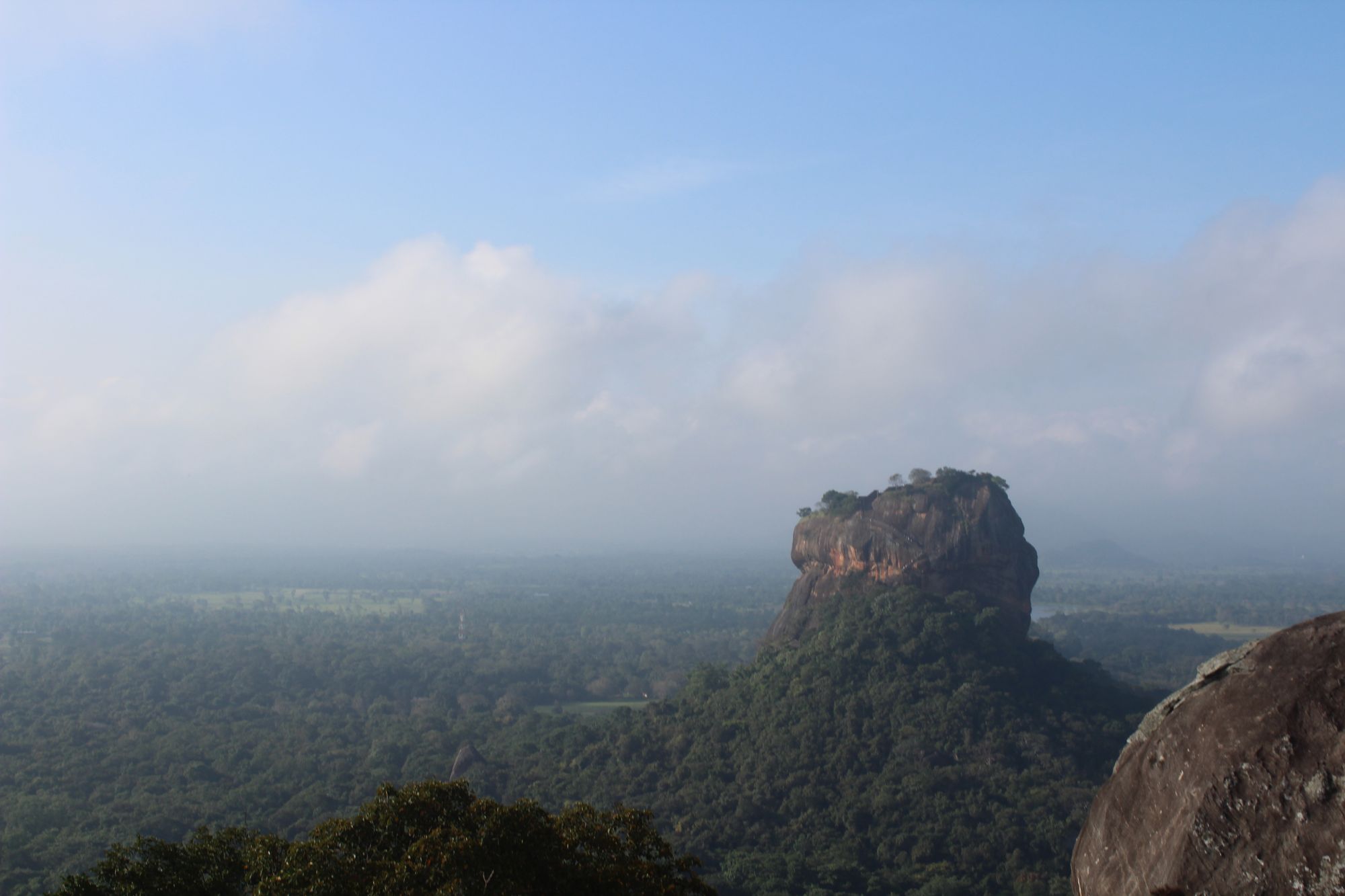
History of Sigiriya
Sigiriya, also known as Lion Rock, is an ancient fortress in the Matale District of Sri Lanka. The fortress was built in the 5th century AD by King Kashyapa, who chose this location as his new capital and fortified palace. The fortress is a massive rock formation that rises over 200 meters.
The history of Sigiriya is rich and fascinating. According to historical records, King Kashyapa built the fortress as a refuge from his brother, Prince Mugalan. Kashyapa killed his father to take the throne for himself, and his brother sought vengeance.
Despite the heavy fortifications, Prince Mugalan managed to invade the fortress, which resulted in King Kashyapa's suicide. Albeit the brutality it has seen, this magnificent structure endured the test of time. It is now known as an icon where culture, history, engineering, and art unite to showcase the wonders of civilization.
The hike to the top of Sigiriya is a must-do for anyone if he or she is capable. The hike is moderate to difficult, taking about 1-2 hours, depending on your fitness level. The path to the top is well-maintained and has steps, handrails, and platforms to help you along the way. The climb is steep in some places and can be challenging, but the views from the top are well worth the effort.
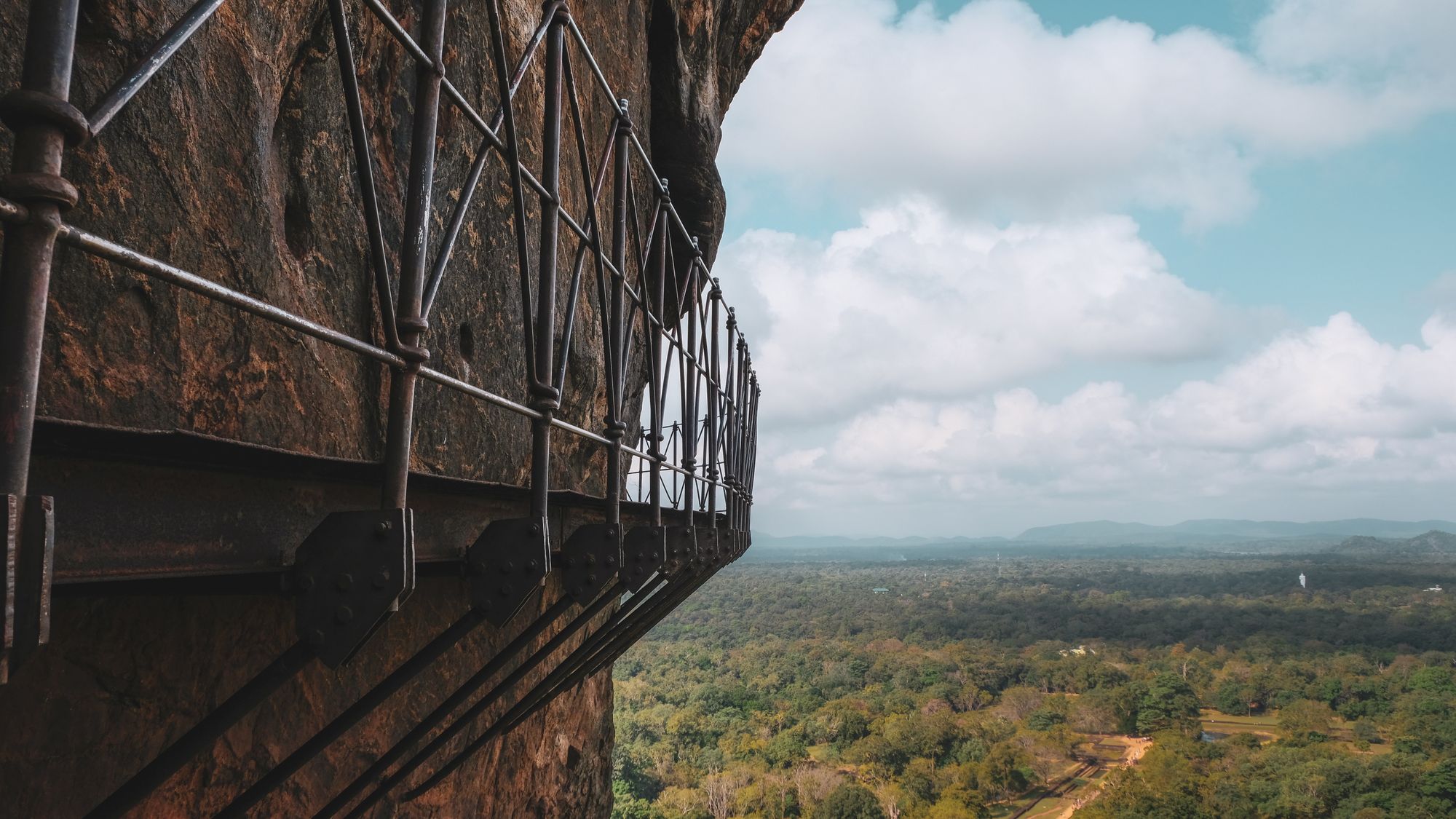
As you make your way up Sigiriya, you'll come across many intriguing sights that speak to the site's historical and cultural significance. One such feature is the ancient frescoes gallery, where you'll need to traverse a narrow, spiral staircase to access the vivid paintings. You'll also pass through the Lion's Gate, once guarded by a massive lion sculpture that lent the fortress its name. Today, only the lion's paws remain, but they provide a striking reminder of the grandeur and power that Sigiriya once represented.
The climb is a perfect opportunity to admire the natural beauty of the surroundings and the impressive engineering of the fortress.
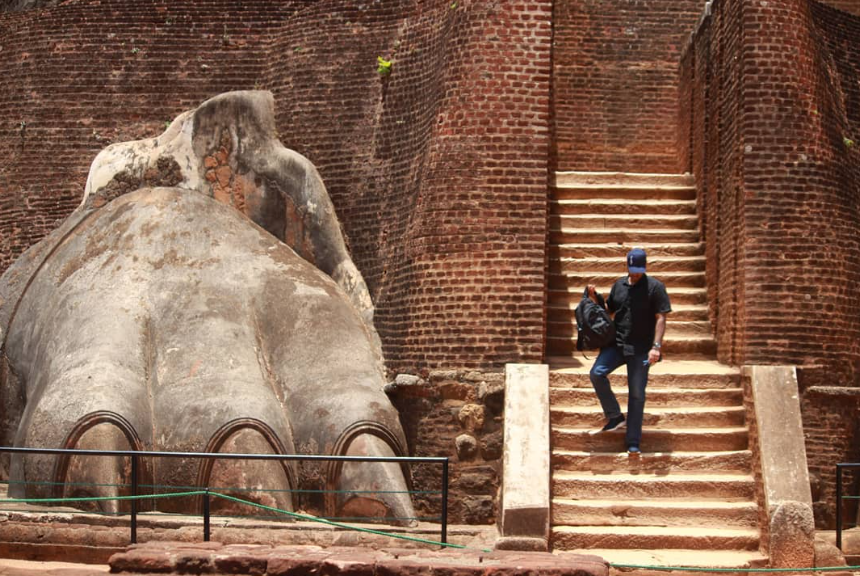
Exploring the Sigiriya Rock Fortress
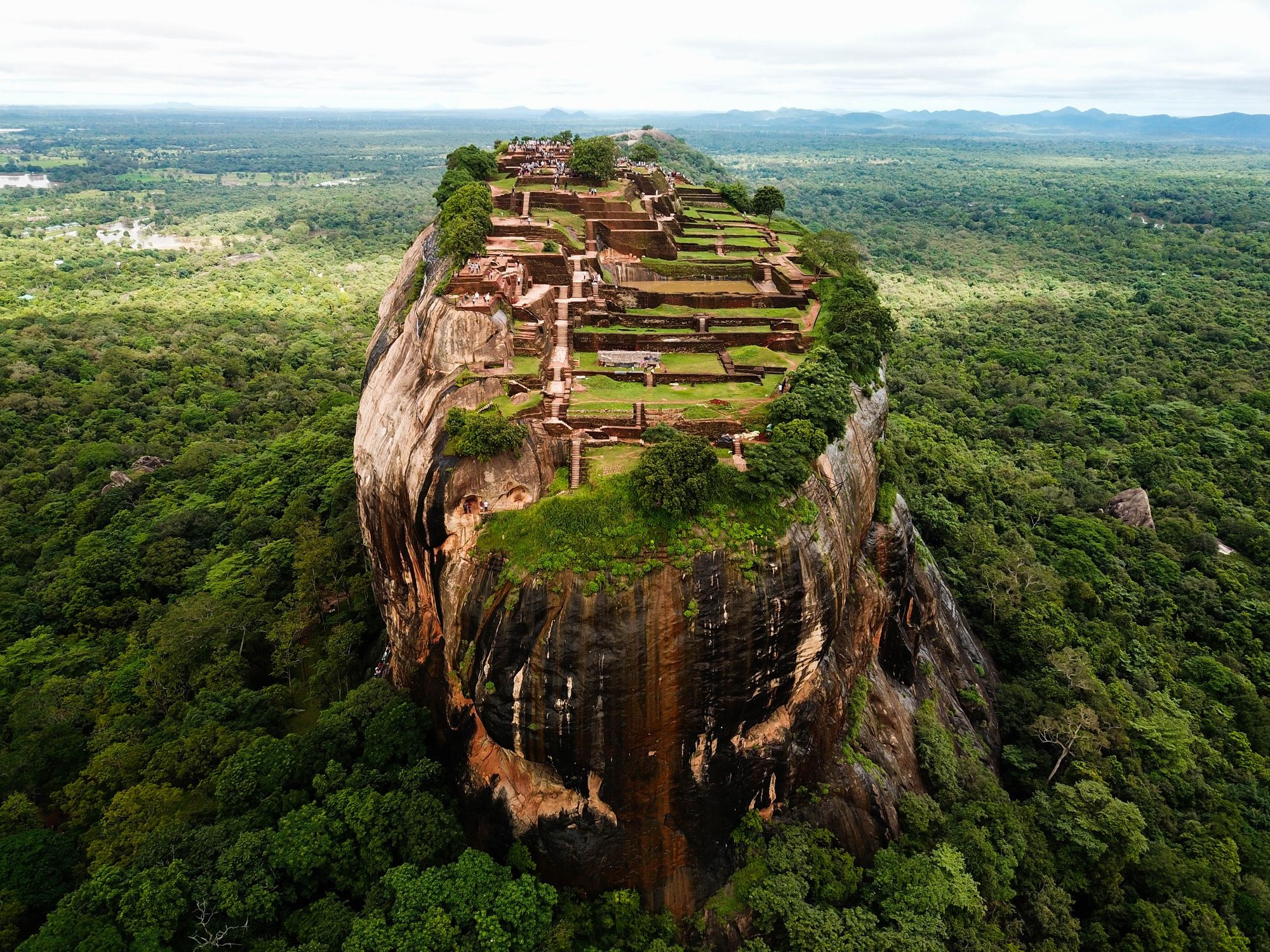
Once you reach the top of the rock, you will arrive heart of the fortress. The fortress is a complex of buildings, gardens, and pools that were once the palace of King Kashyapa. Sigiriya's palace complex is a marvel to behold, as it was ingeniously designed to maximize the limited space available atop the rock. The palace features many well-preserved buildings, including the Audience Hall, the Lion Staircase, and the Mirror Wall. The palace is an architectural masterpiece and gives visitors a glimpse into the lifestyle of the ancient Sinhalese royalty.
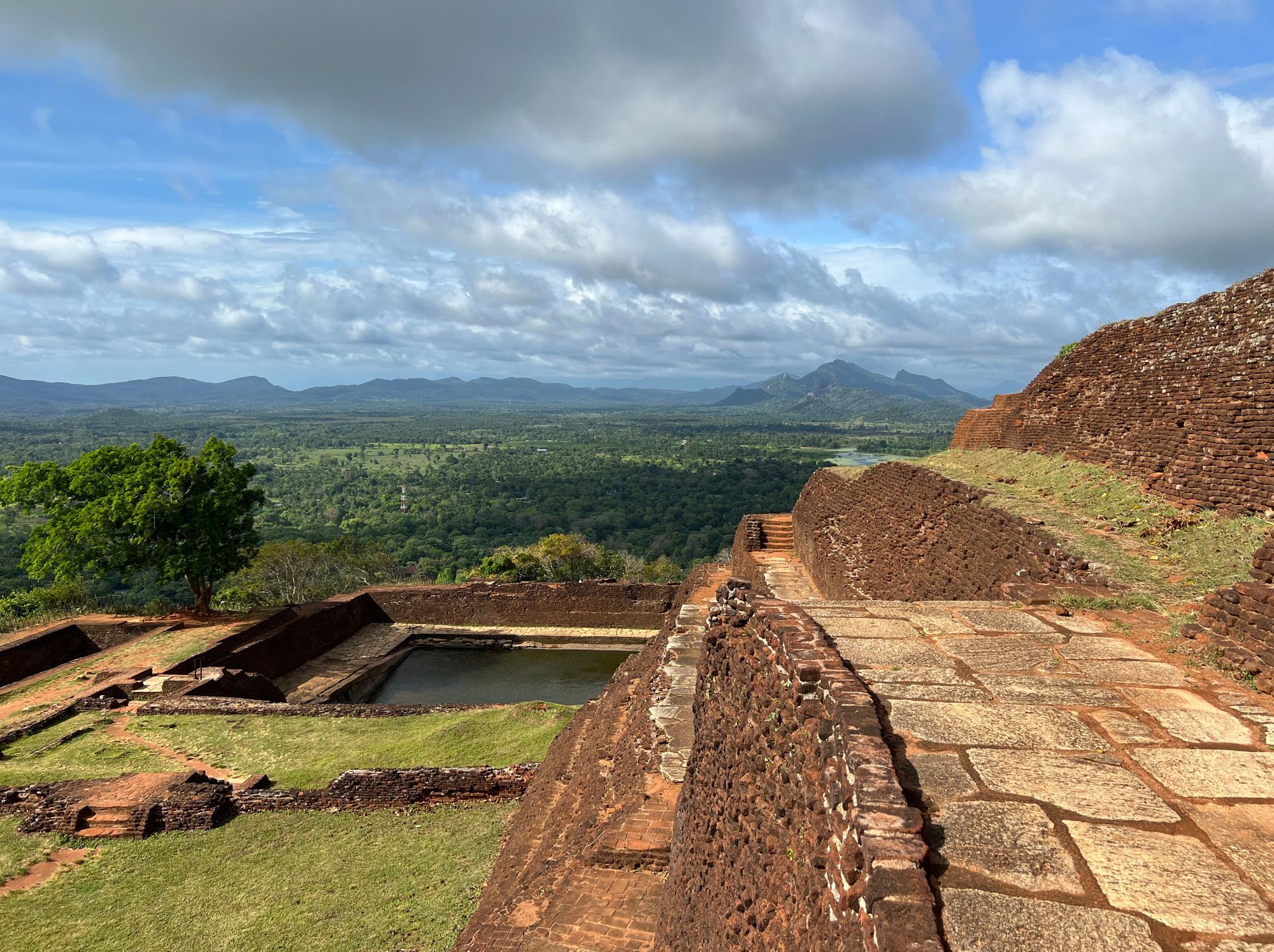
The Water Gardens
The water gardens at Sigiriya are a true testament to ancient engineering and design. The intricate system of pools, fountains, and streams is absolutely stunning. However, the true marvel of these gardens lies in the engineering that makes them function. The fountains, for example, are pressure-operated, functioning without the need for modern pumps. Pipes carved through the rock bring up the water to the top. How this was actually achieved is a mystery to this day.
The Sigiriya Frescoes
One of the most fascinating features of Sigiriya is the frescoes that adorn the rock face. The frescoes are located on the western face of the rock, and they are best viewed in the morning or evening light. The frescoes are a series of paintings of women thought to be the king's wives or divine beings. The paintings showcase an advanced understanding of human anatomy and movement, with each figure gracefully poised and adorned with intricate jewelry and colorful garments. The skillful use of shading, color, and perspective in the frescoes is truly awe-inspiring and will leave you with a lasting impression of the artistic heritage of ancient Sri Lanka. They are considered some of the finest examples of ancient art in Sri Lanka.
The Mirror Wall
Sigiriya's mirror walls are another feature of the fortress. They were supposedly so well polished in ancient times that one could see his reflection. Ancient visitors wrote inscriptions and poems on these walls. The inscriptions found on the wall range from poetic verses to declarations of love, offering a unique perspective on the thoughts and emotions of those who visited Sigiriya centuries ago. As you walk along the mirror wall, take a moment to appreciate the connection between the past and the present, and imagine the countless individuals who have stood in the same spot, marveling at the splendor of Sigiriya. This graffiti provides a glimpse into the thoughts and experiences of visitors from ages ago, offering a unique perspective on the history and significance of the fortress and the Sinhala language.
There is an entrance fee to visit Sigiriya, and tickets can be purchased at the site or in advance through a travel agency.
Accommodation
There are plenty of accommodation options in the Sigiriya area. The area around Sigiriya is especially known to have several luxury hotels and resorts. But accommodations for any kind of budget, such as hostels, Airbnbs, and homestays, are available. Booking your accommodation in advance is recommended, especially during the peak tourist season.
Transportation
Sigiriya is well-connected to other parts of Sri Lanka by road. You can reach the site by your own vehicle, taxi, tuk-tuk, or bus.
Guided tours
To get the most out of your visit to Sigiriya, we advise that you hire a knowledgeable local guide. A guide can provide valuable insights into the history, culture, and engineering of the site and ensure that you don't miss any important features.
Photography
While photography is allowed in most areas of Sigiriya, certain sections may have restrictions, especially where frescoes and other delicate artworks are present. Be respectful of the site and follow any posted guidelines or instructions from your guide.
Supporting the local community
Consider supporting the local community by purchasing souvenirs, handicrafts, or food from nearby vendors. This not only provides an authentic experience but also contributes to the local economy and helps preserve the heritage of the region.
Tips and Advice
- Wear comfortable shoes and clothing, as the climb to the top, can be strenuous.
- Start your climb early in the morning to avoid the heat and crowds.
- Carry plenty of water with you.
- Respect the cultural and historical significance of the site by not littering or causing damage to the fortress or its surroundings.
- If you are not fit for this climb, an alternative route is available to reach the top. Or you can simply admire the view of the fortress from the bottom.
- Make sure to take your camera to capture the stunning views and beautiful frescoes.
- The climb is filled with many smaller sites offering a wealth of cultural and historical knowledge. So make sure to hire a guide to get an in-depth understanding.
- The nearby Pidurangala Rock is a famous viewpoint and offers one of the best views of Sigiriya, so consider hiking there as well.
Nearby Attractions
- Pidurangala Rock: Just a few kilometers away from Sigiriya, Pidurangala Rock is an ideal destination for those looking to escape the crowds and experience a more serene hike. The climb to the summit offers breathtaking views of Sigiriya Rock and the surrounding jungle. Pidurangala Rock also has its own historical significance, as it once served as a monastery for Buddhist monks.
- Dambulla: Dambulla is a fascinating city situated in close proximity to Sigiriya, rich with historical, cultural, and religious significance. This enchanting destination is home to the iconic Dambulla Cave Temple, a UNESCO World Heritage Site renowned for its stunning rock cave murals and intricate architecture. There are also several other wonderful attractions, such as the Rose Quartz Mountain, the Kandalama reservoir, and the Ibbankatuwa Megalithic Tombs. Find out more about the top things to do in Dambulla.
- Minneriya National Park: Approximately 34 km from Sigiriya, Minneriya National Park is an excellent place to experience Sri Lanka's wildlife. The park is home to a variety of animals, including elephants, leopards, sloth bears, and many species of birds. Minneriya is best known for "The Gathering," an annual event where hundreds of elephants congregate around the park's central reservoir during the dry season. This is the largest gathering of Asian elephants in the world.
- Anuradhapura: About 73 km from Sigiriya, Anuradhapura is another UNESCO World Heritage Site that displays the rich history and culture of ancient Sri Lanka. The city was the first capital of Sri Lanka and flourished for over a thousand years. Today, visitors can explore the well-preserved ruins of ancient palaces, temples, and stupas that provide a fascinating insight into the past.
- Polonnaruwa: Located about 60 km from Sigiriya, Polonnaruwa is another UNESCO World Heritage Site that features the ruins of an ancient city. Polonnaruwa was the second capital of the island and served as the royal capital from the 11th to the 13th century. The site is home to well-preserved palaces, temples, and other structures that showcase the skill and craftsmanship of the ancient Sinhalese civilization.
Sigiriya is one of the world's most iconic landmarks and, without a doubt, Sri Lanka's number one travel destination. It is revered by Sri Lankans and hailed as a national treasure. If you visit Sri Lanka, this is one place you definitely should explore. Explore the ancient architecture, history, and culture while taking some incredible photos. It will be a journey to remember!
Wonders Of Ceylon
Worldwide Walkers
Sigiriya Rock: How to Visit Sri Lanka’s Iconic Landmark

In the middle of Sri Lanka, you’ll find the ancient rock fortress known as “Sigiriya Rock” or “Lion Rock”.
To get there, you need to pass a jungle with wild elephants, cross a moat with crocodiles, and climb the 1200 steps to the top of the rock. It doesn’t get more Indiana Jones-like than this.
Climbing Sigiriya Rock was one of the highlights of our trip to Sri Lanka, and we can’t recommend it enough.
That’s why we’ve decided to make this travel guide to help any future travelers to visit Sigiriya Rock. We’ll include some historical facts, all the practical information you need, and we’ll share what to expect at Sigiriya Rock.
Hopefully, when you’re done reading this, you’ll be ready to visit this extraordinary place in Sri Lanka.
AFFILIATE LINKS DISCLOSURE: Dear Reader, this blog post contains affiliate links. If you click on them, we may earn a commission at no extra cost to you. Learn more here .
Why visit Sigiriya Rock
Some people are inclined to skip Sigiriya Rock because the entrance fee is a bit high ($30 for foreign tourists), especially when you compare it to the low entrance fee of Pidurangala Rock, which is located right next to it.
However, we really recommend you to visit! Not visiting Sigiriya Rock is like skipping Angkor Wat when in Cambodia or skipping the pyramids when in Egypt.
It’s such an iconic and historical monument in Sri Lanka that you just have to experience it. Sigiriya Rock is even an inscribed UNESCO World Heritage Site since 1982.
There is so much to see on the way up to Sigiriya Rock such as the gardens, the frescoes, and the lion’s paws. All the while the views become more phenomenal by every step towards the top.
Once you reach the top of Sigiriya Rock, there is a lot of ruins to explore, and you get to see one of the best viewpoints in Sri Lanka, which in itself is reason enough to visit this extraordinary place.
- Related blog post: Great things Sri Lanka is famous for

History of Sigiriya Rock
Sigiriya Rock has a very interesting history, and it’s good to know a thing or two about this landmark before ascending it.
The story begins around 3rd century BC when monks moved into the caves at the rock. The monks lived here in peace until King Kassapa, also known as Kasyapa, took the throne of the Anuradhapura Kingdom in 477 AD, and this is where the story gets interesting.
When King Kassapa learned that his younger brother would be the heir to the throne, King Kassapa imprisoned and later killed his father to seize the throne. This obviously caused quite a stir, and to deal with the constant threats to his life, King Kassapa wanted to build a complete inaccessible palace.
And what better place to do that than an almost 200 meter tall rock in the jungle?
So King Kassapa pushed the monks out, giving them the neighbouring Pidurangala Rock instead, and started building his palace. He wanted to form the palace after a lion, which is why we see the two lion paws at the entrance to the top. That’s why Sigiriya Rock is also called Lion Rock.
The palace consisted of beautiful gardens, impressive sculptures, a few pools, and possibly the best views in the kingdom. We can only imagine how impressive this palace must have been.
King Kassapa was indestructible when living atop the rock. However, his past eventually caught up with him and his rule ended after 18 years. King Kassapa descended the rock to go fight his brother, Mogallana, who was the rightful heir to the throne.
Eventually, Mogallana won, King Kassapa died, the monks were given back Sigiriya Rock, and all that’s left of the palace are the ruins we see today.

How to visit Sigiriya Rock
How to get there.
If you stay in Sigiriya, then it’s super easy to get to Sigiriya Rock. Just get a tuk tuk to drive you to the entrance that’s located close to the ticket office.
So let’s focus on how to get to the Lion Rock if you’re not staying in Sigiriya. If you take public transportation, then the closest big city to Sigiriya is Dambulla, so you might have to get here first. From Dambulla it’s only half an hour ride to Sigiriya.
From Kandy to Sigiriya
- Public Transport: Get directions
- Private Transfer: Book a transfer
- Tour options: Book a tour
From Colombo to Sigiriya
Where to stay in sigiriya.
Instead of just doing a day trip from Colombo or Kandy, then consider staying in Sigiriya for a couple of nights.
We stayed in Sigiriya for 2 nights at Sigiriya Paradise Inn , and it was our absolute favorite accommodation during our time in Sri Lanka. Luckily for us, it was also the cheapest place we stayed in.
This hotel is located right by a big rice field, which means you have the most amazing bird sightings around you, and you can even spot Sigiriya Rock from afar.
The hotel is run by a friendly family that goes out of their way to help you and ensure that your time in Sigiriya is successful. We were driven to both Sigiriya Rock and Pidurangala Rock by the friendly owner for a small fee, plus he took us on a fantastic tour around the neighbourhood.

Opening hours 2024
The official opening hours to the Sigiriya Rock Fortress is 6:30 AM – 5:30 PM . However, some people have managed to visit as early as 5 AM and as late as 7 PM. So we can’t say for sure about the opening hours.
Entrance fee 2024
The entrance fee to Sigiriya Rock depends on whether you’re a tourist, a local, and how old you are. Entrance fee for children below 6 years old is free, children tickets are considered age 6-12, and adult tickets are everyone who is 12 years old or older.
Below is a table over the different ticket types and ticket prices to Sigiriya Rock in 2024:
How to buy your tickets
You buy your tickets directly at the main ticket office. Notice that it’s not possible to pay for your tickets with credit card, so you have to bring cash with you.
We paid 11160 LKR per person during our visit in 2023 because that was the currency rate at the time for $30. So make sure to check the current currency rate for when you’re visiting and bring enough Sri Lankan Rupees with you.
Rules and recommendations
It’s not like there are a lot of rules you need to follow in order to visit the Sigiriya Rock. However, there are a lot of wild animals in the area and you are walking in a cultural place which is important to Sri Lanka’s history, so please be respectful of this.
There is one place in particular where you aren’t allowed to take pictures, and this is at the historical frescoes and mirror wall, which you’ll find at part of the rock climb. So please put your camera away during this part of the climb. You’ll see the no-camera signs when you approach the area.
We’ve just mentioned that there are a lot of wild animals in the area around Sigiriya Rock, so please think about this during your visit.
While on the grounds, you may see signs that indicate you’re in a “WASP ATTACK AREA”, if you see these signs then you have to be silent. There are also crocodiles in the moat around the Sigiriya Rock and wild elephants in the surrounding area. So just be mindful of this when you’re visiting.
But please don’t be nervous about it, you most likely won’t see a crocodile or an elephant. However, you’re almost guaranteed to see monkeys!

What to expect at Sigiriya Rock
Now that we’ve covered all the practical information about how to visit Sigiriya Rock in Sri Lanka, it’s time to manage expectations. So below are 5 points on what you can expect during your visit.
1. Walking the gardens towards the rock
After you get your tickets at the official ticket office and cross the moat with the ticket control, you’re in!
The first part of experiencing Sigiriya Rock is walking through the water gardens. At first, it may not look like much considering the towering Sigiriya Rock takes all the attention from the garden. However, the water gardens are truly spectacular.
They’re some of the oldest landscaped gardens in the world, and they’re very well designed and preserved considering how many centuries ago they were founded.
Unfortunately, we were more intrigued about climbing the big rock ahead of us, so we never really gave the gardens much attention. But we encourage you to have a little walkabout before ascending the rock.
- Learn more: Sri Lanka’s Ancient Water Gardens
2. Ascending to the Lion’s Paw Terrace
While crossing the gardens, you’ll find yourself getting closer and closer to Sigiriya Rock. Right until you’re standing in front of two big boulders that are leaning on each other. This is where the ascent to the top begins.
From here, you’ll start walking up the steps until you finally reach the Lion’s Paw Terrace.
This particular terrace is where you’ll find the ancient entrance to Sigiriya Rock. The entrance is marked by two big lion paws on each side of the staircase. It’s believed that the staircase began at the lion paws and ended at the top, leading through a lion’s open mouth.
It must have been an intimidating sight back in time when you had to ascent Sigiriya Rock through a lion. Today, all you can see are the two big paws that marks the bottom of the entrance.
- Fun fact: “Sigiriya” is named after the word “sinha-giri”, which means Lion’s Rock.

3. Ascending to the top of the rock
The next part of exploring Sigiriya Rock is going to the top of the rock. When you take that first step in between the majestic lion paws, the ascent has officially begun.
This part is both exciting and scary at once because you’re literally walking outside the rock, which means you have breathtaking views… but at the same time you realise you’re quite far up without much protection around you.
So just take it easy if you’re afraid of heights. I’m afraid of heights and I didn’t find it that intimidating, but some people on the stairs definitely did.
But maybe I wasn’t intimidated because the incredible view of Pidurangala Rock took all my attention. In our opinion, you get the best view of Pidurangala Rock when you’re ascending to the top of Sigiriya Rock because the view changes bit by bit the higher you go.
Pidurangala Rock is another massive rock located closely to Sigiriya Rock. It’s less touristy, cheaper, and great for sunsets! So we definitely recommend you to go here after exploring Sigiriya Rock.
- Related blog post: Pidurangala Rock

4. Exploring Sigiriya Rock Fortress
The ascent doesn’t take that long, and sooner or later you’ll find yourself on top of Sigiriya Rock.
You kind of get the feeling that you’re on top of the world, like Leonardo DiCaprio in Titanic you feel like screaming: “I’m the king of the World!”
We can definitely see why King Kassapa chose this particular rock for his home. The views are spectacular, there is jungle as far as the eye can see, and it truly is impenetrable by enemies.
The palace itself is long gone. However, there are several ruins you can explore on the top of the rock including the big pools. We honestly wish we knew more about the ruins on Sigiriya, but we had a hard time knowing what we were looking at, and it’s hard to find information about it online.
So, if you want to dive deeper into the palace ruins on the incredible Lion Rock, then we suggest you hire yourself a guide.
One thing is certain, you can still spend plenty of time walking around and exploring the top of Sigiriya Rock without knowing much about the ruins. We almost spent 2 hours here just taking some pictures, enjoying the incredible views, and watching monkeys play.

5. Watching the frescoes & Mirror wall
Most people who climb the Sigiriya Rock normally ascent from a different place than we did and thus begin their journey here. However, we didn’t see the historical frescoes and Mirror Wall until at the very end of our journey on the Sigiriya Rock.
So notice that you’ll most likely see this first, and not last like described in this blog post.
Apart from the palace ruins, the Lion’s Paw Terrace, and the beautiful water gardens at the ground level, Sigiriya Rock has one more surprise in hand – the historical frescoes and the Mirror Wall, which are both found on the Western walls of the rock.
The frescoes were created under the rule of King Kassapa, and they are paintings of naked women, which are said to celebrate the beauty of women. There used to be 500 of these frescoes, but today only 18 are left.
Right by the frescoes, you’ll find the Mirror Wall. This incredibly strong wall is still standing after so many centuries, and it got its name because of how the wall plaster was polished in a certain way that created a mirror-like effect. It’s also on this wall that you’ll find the ancient poems.
Sigiriya Rock had many visitors during the centuries that followed King Kassapa’s fall. These visitors wrote poems on the wall, which are now invaluable to understand the historical frescoes, because some of the poems describe frescoes which aren’t here anymore.
So make sure to see the frescoes and the Mirror Wall while visiting the Sigiriya Rock in Sri Lanka. I can’t believe we almost missed it!
- Important notice: You’re not allowed to take pictures at this part of Sigiriya Rock.

Sigiriya Rock is such an incredible place, and we really encourage you to see it if you have the opportunity.
We hope you enjoyed this guide to climbing the iconic Sigiriya Rock, and that you found it helpful in planning your own visit in Sri Lanka. Let us know if you have any questions in the comment box below.
Thanks for reading and happy travels!
Not sure whether you’re heading to Sri Lanka for your next holiday? Read this: Why visit Sri Lanka
Hi, I'm Cecilie! And I'm the writer behind our travel blog. I only write about places that we've personally been to and want to recommend to you. I'm passionate about creating truthful travel guides, which can help you plan your own trip. When I'm not traveling or writing, you'll find me on a hiking trail, in a coffee shop, or in a shoe store around Copenhagen.
Similar Posts

14 Things to do in Galle Fort: 2024 Travel Guide
Galle Fort is like nowhere else in Sri Lanka. We’ll never forget walking into the colonial streets of the fort and wondering where all the cars, street vendors, and tuk…

13 Fantastic Things to do in Colombo in 2024
When planning our trip to Sri Lanka, we discussed whether or not to skip Colombo. A lot of the information we found online about the city didn’t really appeal to…

Pidurangala Rock: How to Visit Sigiriya’s Best Viewpoint
Climbing to the top of Pidurangala Rock is one of our best memories from Sigiriya. Atop Pidurangala Rock, you get incredible views over the lush, green jungle surrounding you, you…

Why you need to Visit Sri Lanka in 2024
Doubting whether or not you should visit Sri Lanka on your next trip? We’re here for you. Hopping on a plane to this wonderful country was one of the best…

22 GREAT Things Sri Lanka is Famous and Known for
During our last trip, we learned that Sri Lanka is famous for so many great things! Nobody told us that you can experience several ancient wonders, visit national parks full…

10 Things to do in Kandy: 2024 Travel Guide
Kandy was a mouthful. At first. After spending several days in serene Sigiriya, it seemed like we had arrived somewhere complete opposite. Life in Kandy was fast-paced, so I was…
Leave a Reply Cancel reply
Your email address will not be published. Required fields are marked *

- Privacy Overview
- Strictly Necessary Cookies
This website uses cookies so that we can provide you with the best user experience possible. Cookie information is stored in your browser and performs functions such as recognising you when you return to our website and helping our team to understand which sections of the website you find most interesting and useful.
Strictly Necessary Cookie should be enabled at all times so that we can save your preferences for cookie settings.
If you disable this cookie, we will not be able to save your preferences. This means that every time you visit this website you will need to enable or disable cookies again.
- Share full article
Advertisement
Supported by
Chacarita Is Buenos Aires’s Quirkiest Neighborhood. Get There Soon.
Strolling through this once-traditional nook of the Argentine capital, the author found Art Deco houses on cobblestone streets, decadent churros and pizza slices, and whimsy around every corner.

By Seth Kugel
To become a city’s coolest new neighborhood, there are certain prerequisites: a crop of cafes that toe the line between cozy and snobbish, chefs combining the innovative with the Instagrammable, and shops so sincere that they are doomed to close when rents rise, which they inevitably will.
But then it must also have quirks. Chacarita, long seen as a low-slung, low-profile neighborhood in north-central Buenos Aires, has plenty.
There’s the cafe that doubles as a museum of photography and triples as a jazz club. Two cavernous, mysteriously indistinguishable pizza halls, both opened in 1947, stand side by side near a subway stop and serve thick-crusted slices draped with mozzarella and onions. And then, in Chacarita’s southwest flank, a cemetery has elegant monuments to the 20th century tango legend Carlos Gardel and the pioneering aviator Jorge Newbery amid vast fields of simply marked, working-class graves. It plays a pretty good second fiddle to Recoleta Cemetery , one of the top 10 tourist attractions in Argentina and housing the pantheon of the country’s revered former first lady, Eva Perón.
Just a 10-stop subway trip from the Obelisk downtown — the fare recently raised to 125 pesos is still under 15 U.S. cents even at the official market’s rate of 878 Argentine pesos to the dollar — totally walkable Chacarita is one heck of a great place to shop, eat and simply wander for a few days, which I did earlier this year, both on my own and with my (then) 19-year-old nephew, Leo, who was studying, or more accurately, “studying,” in Argentina.
Irresistible shops
Chacarita, which means “small farm,” is so-named because its land once served as a kitchen garden and recreational site for Jesuit school students. It eventually became a transportation hub and working-class neighborhood, roughly 100 square blocks. I was utterly charmed by Chacarita’s cobblestone streets, lined with colonial-style single-family homes with interjections of Art Deco and Brutalism. They were the very opposite of late-game Monopoly board monotony, with heavy wooden doors featuring old-fashioned mail slots labeled “CARTAS” and wrought-iron window guards framing the snouts of pet dogs and cats variously curious and agitated by infrequent passers-by.
Though many commercial streets still have a working-class vibe, Jorge Newbery Avenue does not. The street, named for the aviator, is the hipster center of gravity, with shops, cafes, vermouth bars and one vegan restaurant, Donnet , serving a tasting menu for about 19,000 pesos per person that revolves almost entirely around mushrooms.
Several Newbery shops are irresistible. What I thought was a bakery because the name means the Pastry Chef’s Boutique, La Botica del Pastelero turned out to be a delightfully mammoth bakers’ supply shop, selling artsy marble-cutting boards, creative cookie cutters and lots of utensils.
While La Botica is a baker’s dream, Facón is a tourist’s. The shop’s owner, Martín Bustamante, has set out to show that Argentina is much more than Buenos Aires (and the vineyards of Mendoza and the penguins of Patagonia), offering items that are sourced from local masters as well as some high-design items. For 60,000 pesos, I took home a soulful yet playful scarlet-red wooden horse with a wispy mane created by Juan Gelosi , an artist from north-central Tucumán province.
(Others will want to stop by Falena, a buzz-to-enter bookstore and wine bar hidden behind brick walls and an ancient-looking wooden door. Alas, it was closed for vacation when I was in town.)
Slightly more hidden spots dot the side streets. I wandered through the open doors of a large warehouse space run by LABA , an arts and culture center. Inside I found young people splayed out Vitruvian-man-style, rolling around inside large wheels. It was a class of what in Spanish is known as “German wheel,” but we know (to the extent we know) as wheel gymnastics.
On one corner, I caught a glimpse through ground-level windows of a basement stuffed floor-to-ceiling with racks of used clothing. Had I discovered a sort of speakeasy vintage shop?
No. After I rudely peered in the window to catch someone’s attention, I was told it was a business that rented out costumes for film productions. Down another block, I saw a poster for a business called Fina Estampa which, when I looked it up on Instagram , turned out to be an engraving workshop that gave classes and housed a tiny shop, which was opened only on Tuesdays. Good luck, it was Tuesday! And a print of a gin and tonic in a glass — that also appears to be a tiny swimming pool — now adorns my wall at home.
Burned onions and dulce de leche
The old school side of Chacarita is worth a wandering, for its more down-to-earth vibe and cheaper eats. Santa Maria’s fugazzetta slice, draped with mozzarella and just slightly burned onions, is 1,600 pesos and well worth it; a churro filled with dulce de leche from Fábrica de Churros Olleros — around 60 years old and looking its age — is only 350. But I particularly enjoyed my steak and fries lunch, costing 3,400 pesos, at Colonia 10 de Julio, the sort of place where the floor looks grimy even after it’s just been mopped.
I only went to one place twice, the cafe photography-museum jazz club called both Bar Palacio and the Museo Fotográfico Simik . On an afternoon visit, I peered at the cabinets full of ancient cameras, and then ordered a coffee and a traditional sweet potato-and-cheese dessert from a table that served as the base of a Durst M605 photographic enlarger, a hulking machine of the sort formerly seen only in the eerie red light of 20th-century darkrooms. The next day, I came back with Leo and some friends to hear jazz amid Kodak Instamatics older than me, and daguerreotype machines older than any person alive today.
My dinners in Chacarita were hit and miss: the first night, Leo and I were rejected from a just-opened artisanal pizzeria shop called Culpina . The owner was pulling delicious-looking small pies from a stone oven, but only for family and friends. So we crowded into the last remaining sidewalk table of Sifón , a spot named after reusable seltzer siphons that to a New Yorker looks like something from the Tenement Museum but are still in wide use throughout Buenos Aires to add your own spritz to wine-based drinks like tinto de verano. That was the best part of our meal, which consisted of rather mediocre polenta and arancini.
Our best dinner was at Lardito, a legitimately ballyhooed spot with an around-the-world-in-small-plates vibe. At communal tables festooned with lavender and white wildflowers, Leo and I ate beef tataki (thin slices of lightly seared sirloin with oyster vinaigrette and topped with an egg yolk and cauliflower foam) and ceviche for 45,000 pesos. The price did not include wine, which diners choose in the restaurant’s mini wine shop — perfect for those who are better at selecting cool labels than obscure grapes.
Battling against developers
But there were plenty of signs the neighborhood might already be on the road to post-hipster glass-and-steel condos — literal signs. Dozens of “NO AL NUEVO CÓDIGO URBANÍSTICO” (“No to the new zoning code”) — posters hang on residences in protest of a 2018 zoning code overhaul that facilitated the building of apartment buildings in residential neighborhoods, among other things.
My final morning, I met María Sol Azcona and Laura Nowydwor, two women with the organization, Amparo Ambiental Chacarita , which, loosely translated, means “Protect Chacarita’s Environment.” We met in a fancy cafe, which they were quick to point out was overpriced and dotted with foreigners.
Listening to them detail their battle against real estate developers was both hopeful — they helped introduce new legislation last year that would scale back the 2018 code — and depressing. The pair showed me how easy it was to use the city’s 3-D online app to seek out what blocks of the neighborhood were ripe and legal for building.
Ms. Nowydwor, who studied geography at the University of Buenos Aires, has mapped out 300 construction projects in the neighborhood, including 15 houses that have been demolished. Real estate developers have joined tourists in wandering residential streets.
“You see them walking around, ringing doorbells,” said Ms. Nowydwor, “telling the residents ‘We’ll pay you three million dollars’ for a 150-square-meter property,” the equivalent of about 1,600 square feet. “Then they build 40 apartments and sell them for $200,000 each.” (Properties in Buenos Aires are often sold for cash in American dollars.)
Luckily, they did not throw me and other visitors under the bus.
“The problem isn’t tourism in and of itself,” Ms. Azcona said. “It’s that a big part of the city is being thought of and planned for the sake of businesses. And tourism is a kind of business.”
Follow New York Times Travel on Instagram and sign up for our weekly Travel Dispatch newsletter to get expert tips on traveling smarter and inspiration for your next vacation. Dreaming up a future getaway or just armchair traveling? Check out our 52 Places to Go in 2024 .
Seth Kugel is the columnist for “ Tripped Up ,” an advice column that helps readers navigate the often confusing world of travel. More about Seth Kugel
Open Up Your World
Considering a trip, or just some armchair traveling here are some ideas..
52 Places: Why do we travel? For food, culture, adventure, natural beauty? Our 2024 list has all those elements, and more .
Mumbai: Spend 36 hours in this fast-changing Indian city by exploring ancient caves, catching a concert in a former textile mill and feasting on mangoes.
Kyoto: The Japanese city’s dry gardens offer spots for quiet contemplation in an increasingly overtouristed destination.
Iceland: The country markets itself as a destination to see the northern lights. But they can be elusive, as one writer recently found .
Texas: Canoeing the Rio Grande near Big Bend National Park can be magical. But as the river dries, it’s getting harder to find where a boat will actually float .

IMAGES
VIDEO
COMMENTS
Sigiriya is easily the most recognisable, identified by its towering rock formation with an ancient fortress perched atop its flat mount. However, Sigiriya is also close to two other impressive UNESCO World Heritage Sites forming a triangle: the Ancient City of Polonnaruwa and the Dambulla Cave Temple. Together, these make up Sri Lanka's ...
Things to Do in Sigiriya - Sri Lanka's Historic Triangle Explore the Dambulla Cave Temple Complex. Located right outside of the city of Dambulla, the UNESCO Rangiri Dambulla cave temple complex has stood for more than 22 centuries as a sacred pilgrimage site, refuge and monastery. Up 525ft, embedded in a rock face, lies five cave shrines each with a plethora of immaculately made Buddhist ...
WHAT TIME OF YEAR TO VISIT SIGIRIYA, SRI LANKA. Sigiriya is best visited during the dry season, between late December and early April, with March being the optimum in terms of visibility and weather conditions. That said, this is also very much the hottest part of the year; we visited Sigiriya in mid-April and let's just say there isn't really an adjective to describe how stiflingly hot ...
The Ancient City of Sigiriya. Sigiriya is one of the most astounding remnants of a past Sri Lankan civilization. The name of the huge rock itself translates to English as the Lion's Rock, because of the enormous Lion's Paw that was carved by the entrance guarding the way in. The rock is almost 200 meters high and geologically is a plug ...
Sigiriya. Sri Lanka, Asia. Rising dramatically from the central plains, the enigmatic rocky outcrop of Sigiriya is perhaps Sri Lanka's single most dramatic sight. Near-vertical walls soar to a flat-topped summit that contains the ruins of an ancient civilization, thought to once have been the epicenter of the short-lived kingdom of Kassapa, and ...
Sigiriya Fortress was built by King Kashyapa I, in the 5th century, at the time of which the area belonged to the Moriya, who were the natives to the Sinhalese dynasty. This fortress played the role of capital to the kingdom, until the king was defeated in 495 A.D. Before the fortress was built, the rock was inhabited by Buddhist monks, and ...
Discover the best attractions in Sigiriya including Summit, Frescoes, and Pidurangula. Discover the best attractions in Sigiriya including Summit, Frescoes, and Pidurangula. Lonely Planet. Destinations. Planning. Inspiration. Shop. ... Beyond the Sigiriya frescoes, the path clings to the sheer side of the rock and is protected on the outside by ...
Nicknamed the eighth wonder of the world, Sigiriya is the most remarkable cultural landmark in Sri Lanka. Sigiriya or the Lion Rock is an ancient rock fortress created in the 5th century AD. This 200 m tall huge rock is towering over the surrounding greenery of the plains in central Sri Lanka. Sigiriya Rock Fortress remained the capital of Sri ...
Rising dramatically from the central plains, the enigmatic rocky outcrop of Sigiriya is perhaps Sri Lanka's single most dramatic sight. A set of near-vertical staircases climb past some remarkable frescoes to a flat-topped summit that contains the ruins of an ancient civilisation. The spellbinding vistas over the surrounding landscape only add ...
Built in the fifth century, Sri Lanka's Sigiriya fortress attracted the attention of British archaeologists in the 1800s, who were amazed by its leonine rock art and beautiful frescoes.
The UNESCO World Heritage site of Sigiriya is one of the biggest attractions in Sri Lanka. A massive ancient stone fortress atop an outcrop in the heartlands of central Sri Lanka the Lions Rock is an essential part of any visit to this beautiful Island. ... These tourist busses and minivans tend to be air conditioned and will run pretty much ...
Things to do: There are tons of interesting things to do in Sigiriya including (but not limited to) visiting the ruins of the royal palace on the top, gazing dumbstruck at the gigantic lion's paws, and appreciating the beauty of Sigiriya frescoes.Check out the best Sigiriya attractions here. The climb: Sigiriya rock has more than 1200 steps to get to the top.
2. Watch the sunset from the top of Pidurangala Rock. Looking over at Lion rock from Pidurangala Rock at sunset. Don't just climb Sigiriya Rock! Be sure to also climb the nearby Pidurangala Rock which sits right across from Sigiriya Rock. Pidurangala Rock is the lesser-known rock temple in Sigiriya.
Sigiriya is one of the most valuable historical monuments of Sri Lanka. Referred by locals as the Eighth Wonder of the World, this ancient palace and fortress complex has significant archaeological importance and attracts thousands of tourists annually. ... It is probably the most visited tourist destination in Sri Lanka. The palace is located ...
Complete Guide to Sigiriya in Sri Lanka. A UNESCO World Heritage Site, Sigiriya in Sri Lanka, also known as Lion Rock, is a breathtaking architectural marvel located in the heart of Sri Lanka.This ancient fortress, built in the 5th century CE (AD), sits majestically atop a massive rock formation that rises to about 200 meters above the surrounding jungle.
Wednesday, 4 August 2021 00:00 - - 652. Redesigning Sri Lanka's Tourism to be sustainable, green and resilient. Sigiriya: The Lion Rock fortress. Sigiriya, considered to be one of the most valuable historical monuments in Sri Lanka, has long been renowned as an architectural wonder of urban planning and engineering, and a UNESCO world ...
The 15 Best Things To Do In Sigiriya, Sri Lanka. Okay, now it's time for the part you came for, an ultimate guide on the best things to do in Sigiriya! 1. Climb Sigiriya Rock (Aka Lion Rock) Morning view of Sigiriya Rock from our balcony at Cassandra Culture Resort. This is by far the best thing to do in Sigiriya. .
It is a UNESCO World Heritage Site and consists of a citadel and has ruins of palaces, the Lion Gate, gardens, moats, the Mirror Wall, and many beautiful frescoes (paintings made in wet plaster on walls). 2. Sigiriya Museum. Sigiriya Museum is at the base of the Sigiriya Rock Fortress and was established in 2009.
The nearby Pidurangala Rock is a famous viewpoint and offers one of the best views of Sigiriya, so consider hiking there as well. Nearby Attractions. Pidurangala Rock: Just a few kilometers away from Sigiriya, Pidurangala Rock is an ideal destination for those looking to escape the crowds and experience a more serene hike. The climb to the ...
The official opening hours to the Sigiriya Rock Fortress is 6:30 AM - 5:30 PM. However, some people have managed to visit as early as 5 AM and as late as 7 PM. So we can't say for sure about the opening hours. Entrance fee 2024. The entrance fee to Sigiriya Rock depends on whether you're a tourist, a local, and how old you are.
Sigiriya Sri Lanka is a beautiful destination in the northern Matale District of the country, home to the historic Lion Rock Fortress. Sigiriya is part of the Cultural Triangle, a popular tourist route highlighting the best things to do in Sri Lanka.Although the ancient fortress is one of the major attractions in the area, there are many more incredible things to see and do in Sigiriya.
Climb the Lion Rock for Sunset. Today Sri Lanka is not known for its volcanos, yet the island's most popular tourist attraction - Sigiriya Rock (aka the Lion Rock) was formed in the hottest core of an ancient volcano. Towering 180 meters above the green plain, the monolithic Sigiriya rock is a 2-billion-year-old volcanic plug.
It plays a pretty good second fiddle to Recoleta Cemetery, one of the top 10 tourist attractions in Argentina and housing the pantheon of the country's revered former first lady, Eva Perón.